- United Arab Emirates
- Switzerland
- The Netherlands
- Puerto Rico
- United States
- New Zealand
- ➨ Choose from World Map
- Budget Travel
- Family Travel
- Getting Around
- Visas & Passports
- Work with Us

Browsing Category
- Czech Republic
- Saint Martin
- Uncategorized

- Latin America & The Caribbean
Is It Safe to Travel to Cuernavaca, Mexico? [2024]
Mexico is one of the most unique countries in the world, filled with exceptional beaches, stunning cities, and immaculate nature. Despite being filled with so many incredible places to explore, most tourists flock straight to the tourist areas in coastal resort cities. During my time living in Mexico, I’ve learned that almost all of the country’s top places to visit are hundreds of miles inland from the coast.
Cuernavaca is a place that I’d call one of Mexico’s true hidden gems, but so often people find themselves wondering whether or not Cuernavaca is safe to visit. This blog post will provide an inside look at whether or not it is safe to travel to Cuernavaca through the eyes of an American who has lived just a short drive away for years.

Where Is Cuernavaca?
Dubbed the City of Eternal Spring, Cuernavaca is a relatively small city tucked into the mountains of Mexico’s Central Highlands. It is just a quick 1-2 hour drive or bus ride away from Mexico City. Its proximity to Mexico City makes it very easy to get to, since Mexico City has the biggest hub airport in the entire country.
While Cuernavaca is easy to add to a trip that stops in Central Mexico, it is nowhere near the popular tourist areas along the coasts. Places like Cancun, Tulum, Puerto Vallarta, and Los Cabos are a flight away plus the additional time to get to Mexico City International Airport. Acapulco is the one exception, as it is just a short 2.5-hour drive away.
If you’re planning on visiting both Mexico City and Acapulco, Cuernavaca makes the perfect waypoint. We did this once, and the city proved to be much more than just a place to rest overnight before finishing out our drive back to Puebla ! We didn’t know much about Cuernavaca before visiting, but it proved to be one of the most tranquil places we’ve ever visited in Mexico, and is even the capital of the state of Morelos!
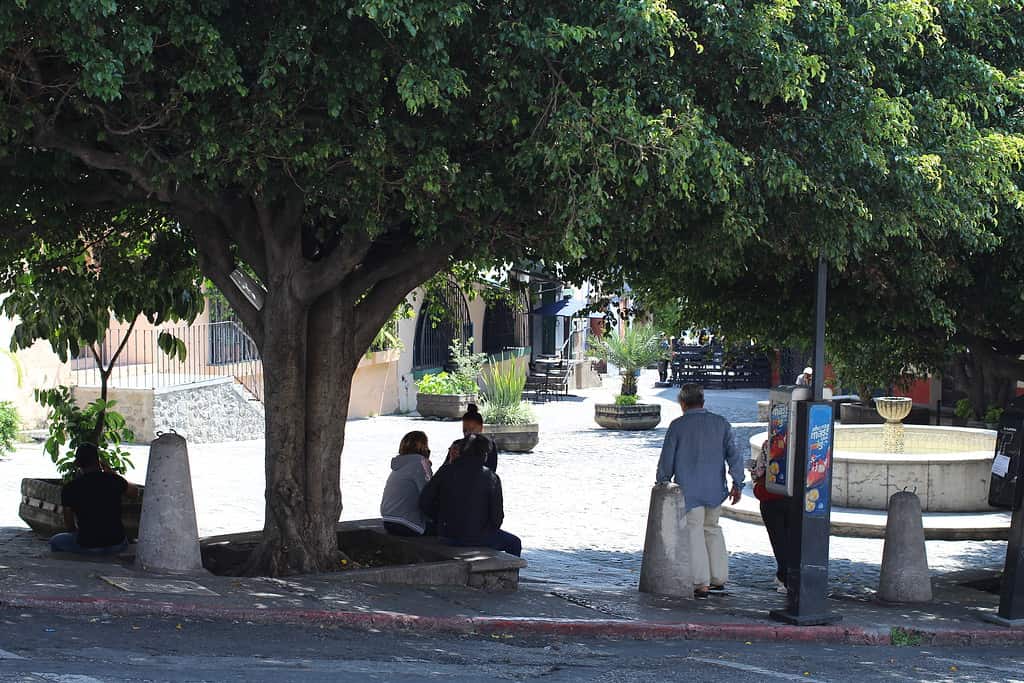
Best Airport to Fly to Cuernavaca
If you want to fly to Cuernavaca, you have several options. The closest airport to Cuernavaca is its own, Cuernavaca International Airport (CVJ) . Generally speaking, this airport is pretty small and only serves a few regional flights. While its footprint has been growing over the years, there’s a good chance you won’t find any great flight options straight into Cuernavaca International Airport.
In my experience, the better options are Toluca International Airport (TLC) and Mexico City International Airport (MEX) . These two airports are much bigger and tend to offer more flights throughout Mexico and internationally. Mexico City International Airport is the biggest hub airport in the whole country, too, which will almost always mean that it’s the best airport to use to fly to Cuernavaca, both from within Mexico and from a foreign country.
Is Cuernavaca Safe to Visit for Tourists?
There’s a huge misconception that Mexico is a vastly dangerous country to visit. A large proportion of tourists think that Mexico is just riddled with criminal activity, and that if you leave your beach resort you will come face to face with drug cartels. The truth is that many of Mexico’s most popular tourist destinations are among the most dangerous cities in Mexico , and most major cities are actually quite safe to visit . Step aside, Playa del Carmen!
Cuernavaca is a place that would fall into this category. While any city in the world will have its safety issues, Cuernavaca is a generally very safe place. I’ve heard stories about gang activity here, but you could say this about anywhere – including every major city in the United States! In most places in Mexico, as long as you avoid illegal activities and use common sense, you’ll usually be just as safe as anywhere else north of the border.
The metropolitan area of Cuernavaca has almost a million people, and any city of that size will have good parts and bad parts. But within the central parts of the city, even petty crime is relatively uncommon. Violent crime is usually either in bad neighborhoods of the city and directly targeted towards other criminals.
It’s very important to note that this is written as it applies to foreigners and tourists. The crime rate in Cuernavaca is actually somewhat high, but the vast majority of crimes are directly targeted toward criminal groups. The Mexican government takes the safety of foreigners very seriously, and as a city packed with foreign students, Cuernavaca gets special attention. While it might not be safe to live in certain parts of the city, it is sufficiently safe to travel to Cuernavaca.

– R E A D –
A Note on Rising Crime Rates in Recent Years
I’ve seen some sources say that Cuernavaca is as dangerous as Ciudad Juarez , and to me, that just feels like a lie. I’ve been to most of Mexico’s most dangerous cities, including Juarez and Tijuana, and I don’t think Cuernavaca belongs anywhere in that conversation. Chicago would, though!
Numbers don’t lie, but they do sometimes distort reality. According to the numbers, Cuernavaca has one of the higher homicide rates in Mexico. However, this figure is a biased representation of the reality in Morelos’ state capital.
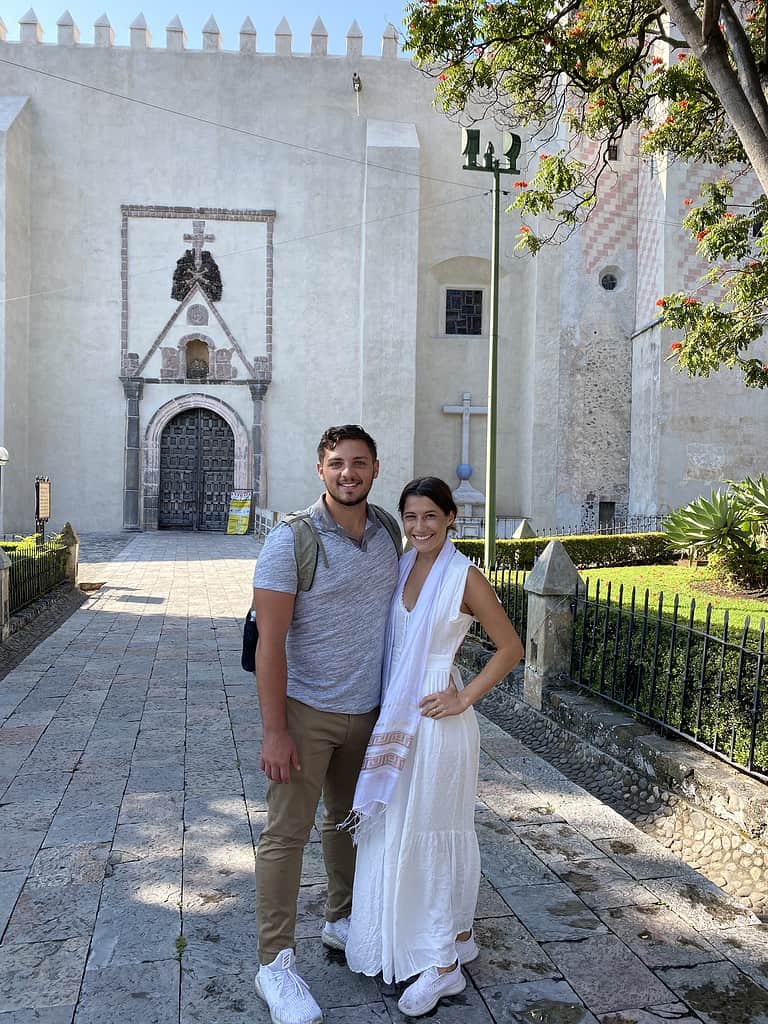
You can’t trust every ratio. You can trust me – I have a background as a data analyst! The crime rate, when simply stated like that, doesn’t account for the motives or limits of the crimes being committed. Similar math is what consistently ranks Myrtle Beach, South Carolina as one of the most dangerous cities in the United States, despite being a family vacation hub.
I’ve always trusted my gut more than I trust government travel advisories and international news networks. I’ve lived in Mexico for years, and I have never once witnessed or been victim of a crime. While there are certainly risks that come with traveling anywhere, I’d always recommend talking to travelers before ruling out a destination, including Cuernavaca. In my own experience, it is reasonably safe to travel to Cuernavaca, especially if you exercise caution.
Tips for Safety in Cuernavaca
While Cuernavaca is a relatively safe city to visit, there are always things you can do to prioritize your safety when visiting. Like anywhere, there’s always a chance of falling victim to a crime. But with Cuernavaca’s general safety along with these safety tips, your odds of having a bad experience are quite slim.
1. Explore During Daylight Hours
Cuernavaca is absolutely beautiful, and there are so many gorgeous areas to explore. From archaeological sites to beautiful gardens and buildings, Cuernavaca might be the most beautiful city in Mexico other than Puebla. There are so many things to fill up your itinerary!
Most of these places are only open for visitors during the day, so obviously heading out at night to see them is pointless. But going out at night is also significantly more dangerous than the daytime, too. When the sun goes down, like anywhere, crime rates do go up.
That’s not to say that Cuernavaca is dangerous after dark. We had plenty of great experiences walking around the Zocalo after dark and munching on delicious street food! But when the sun goes down, you’ll need to make sure you only stay in safe, well-lit areas and always exercise caution.

2. Opt for Uber Instead of Public Transportation or Taxis
In Cuernavaca, there isn’t very much public transportation aside from buses. While I am normally a big public transportation advocate, I scarcely recommend using it while in most Mexican cities. Uber is incredibly cheap and easy in Mexico, and it is almost always the best option.
While some Mexican cities and states do not allow Uber, most do. Cuernavaca fully allows Uber to be used, and it’s the best way to get around the city. It is also markedly safer than public transportation and taxis, as rides are private, prices are preset, and all drivers are vetted and tracked by Uber, adding several layers to your safety.
Uber in Mexico works just like it does at home . You can pay through the app with your credit card and there is no need to carry cash.
3. Carry Only the Cash That You Need
On that note, I don’t recommend carrying much cash around. Unless you’re going shopping, you’ll be perfectly fine in most places with just a credit card. While it’s always good to have some cash on hand for tipping or street food, I’d keep it to a minimum.
Similarly, leave your debit card behind. When you use a credit card, charges can be disputed and your money is protected. When you use a debit card, criminals can fully access your money with no way to get it back.
Generally, I recommend carrying no more than 500 pesos per person in your group for a typical day out. This is usually around $ 20 USD. If you plan on visiting tourist attractions or going shopping, your cash needs may be slightly higher. I recommend researching entry fees in advance to make sure you can pay in card, and if not, that you carry enough cash.
4. Keep an Eye on Your Personal Belongings
Early in my traveling days, a friend told me the most likely crime to ever fall victim to is pickpocketing or bag-snatching. Now as a seasoned veteran, I’d say that advice is spot on. While I have never been pickpocketed or robbed, I have come dangerously close on multiple occasions.
In Cuernavaca, the worst crime you’re likely to experience is pickpocketing. While it’s much better than armed robbery, losing your phone or wallet is still catastrophic! For this reason, I recommend being very diligent with your belongings.
Like in any major city, keep your valuables in your front pockets rather than your back pockets. It’s much harder to steal from your front pockets, especially since most rear pockets are much shallower. I also feel my pockets regularly to make sure everything is still there!
I also highly recommend investing in a theft-proof backpack. While it isn’t necessary, I find that it always provides me with excellent peace of mind, and many of my bag’s features have come in handy on more than one occasion. I always travel with a backpack from PacSafe , and I doubt any other company will win me over.
PacSafe’s bags are both good-looking and highly effective. My bag (the MetroSafe LS450) comes with locks on each zipper, a bottom that can’t be cut or slashed, and straps that can be attached to poles or park bench legs when I set my bag down. Beyond that, the bags are very highly functional and spacious for everyday use, too. If you want to learn more, use my link to check out what they have for sale!
5. Steer Clear of Illegal Activities
In Cuernavaca, most crime is committed against other criminals. Drug cartels generally want nothing to do with tourists, and they usually avoid them to steer clear of the news and police. However, if you partake in illicit activities, you’re opening up that Pandora’s box.
Drugs and prostitution are always illegal in Mexico. There is no such thing as legal marijuana or cocaine south of the border, and beyond just supporting cartels, you put yourself on their radar by consuming these things. Regardless of your personal habits, you should always avoid these things while in Mexico. As an Uber driver once told me in Tijuana , most foreigners are actively avoided by the gangs unless they put their nose where it doesn’t belong.
6. Know the Emergency Number
The emergency hotline in Mexico is 911, just like in the United States. Whether you need the police or an ambulance, this is the fastest way to get help. You never know when this information can save a life, whether it is yours or someone else’s!
7. Stay in a Reputable Hotel or Airbnb
Costs and prices in Mexico are much lower than many countries in the world, and foreigners can often afford to stay in very nice establishments. It’s common for 5-star hotels in Mexico to cost less than 2-star or 3-star hotels in the United States. If you can afford it, I highly recommend opting for 5-star hotels when traveling in Mexico.
While smaller hotels may be perfectly safe, there’s a higher element of unknown. I had a great experience in a local motel in Orizaba once, and I had a terrible experience in a small motel in Tulum. 5-star hotels are rarely hit or miss, and having an in-room safe is a huge advantage.
You can say the same for Airbnb’s. Always read the reviews before booking your stay. We stayed at a lovely Airbnb in Cuernavaca for less than $50 per night including parking!
In terms of hotels, the Ex Hacienda Santa Cecilia is a 4.5 star luxury hotel that gets raving reviews and often costs less than $100 per night.
8. Do as the Locals Do
Despite how many blog posts you read, nobody knows better than locals. When you do as the locals do, you often find yourself in a safe and manageable situation. As an added perk, the locals always know the best places to go in the city, and if you see a crowd of people eating at a certain restaurant, you know it’s a good one!
We followed the noise in Cuernavaca and wound up at a really nice corner cafe that served delicious food. If you speak Spanish, never hesitate to ask a friendly-looking person for recommendations. Folks in Cuernavaca are very friendly and will often help you out.
9. Travel with a Friend
Safe or not, most places are usually safer in groups than solo. While there’s something to be said about the tranquility of solo travel, having a companion makes almost any situation safer. I’ve always preferred traveling with a friend, and once I got married and had kids that reality was locked in!
10. Stay Hydrated
While it may be the City of Eternal Spring, this weather can actually be deceiving. The cool temperatures often cloud the feeling of thirst, and dehydration can set in quickly. Cuernavaca is pretty hilly, and you’ll likely need to drink more water than you realize.
Like anywhere in Mexico, you should always stick to bottled water or purified water from a large blue jug. Even if you see locals drinking the tap water, that doesn’t mean you should. Trust me – you’re better off paying a couple bucks for bottles!
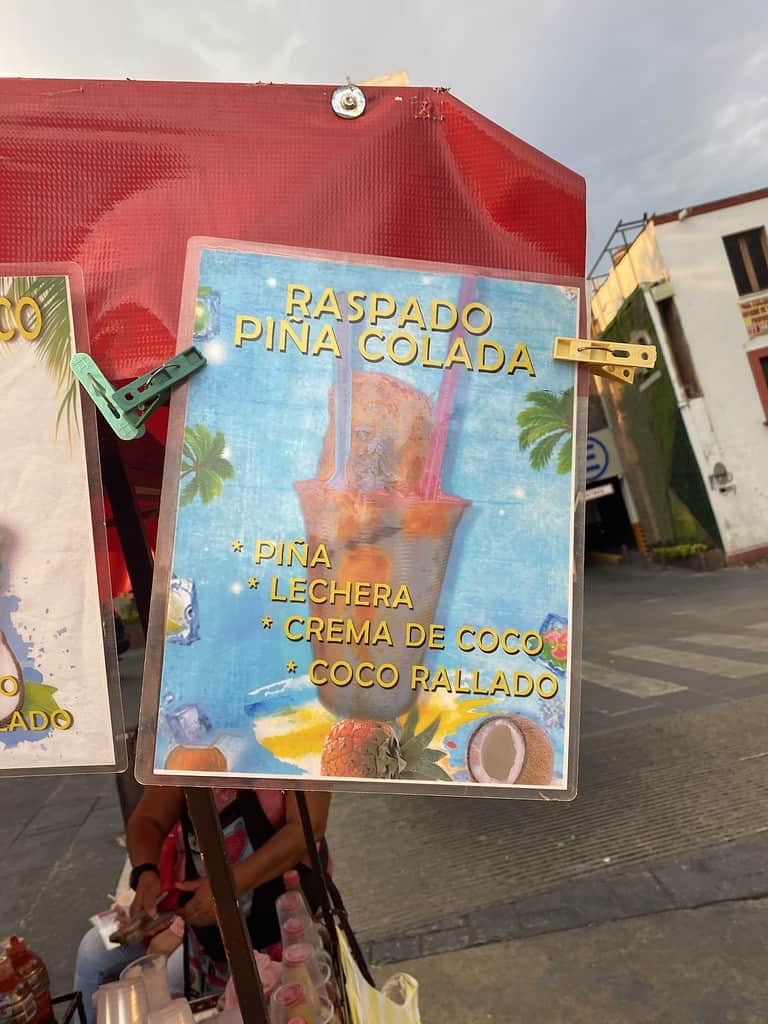
Is Cuernavaca Worth Visiting?
With hundreds of incredible destinations in Mexico, it can be hard to choose where to visit. While Cuernavaca isn’t my favorite place in Mexico, it is definitely a nice one that belongs on certain itineraries!
To me, Cuernavaca is a decent substitute for a place like Puebla or San Miguel de Allende . While I’d pick either of those cities over Cuernavaca, there’s one situation where I’d choose Cuernavaca instead: itineraries that are stopping in both Mexico City and the coastal gem of Acapulco . Cuernavaca sits right on the route between these two popular destinations, and it makes the perfect waypoint.
Cuernavaca is loaded with natural beauty, and colonial buildings like the Cuernavaca Cathedral are jaw-dropping. But one can say this about many places in Mexico! one big advantage of visiting Cuernavaca is that you can pair it with a visit to Tepoztlan, which is a gorgeous little town in the mountains just a short drive from the center of Cuernavaca.
For international visitors to Mexico City, visiting Tepoztlan and Cuernavaca makes a great day trip, along with the other cities on my list of the best day trips from Mexico City . It’s the perfect retreat from the noise and density of CDMX!
Hopefully this post answered the question any questions you have about safety in Cuernavaca. If you have any questions, let us know by dropping a comment below!
RECOMMENDED POSTS
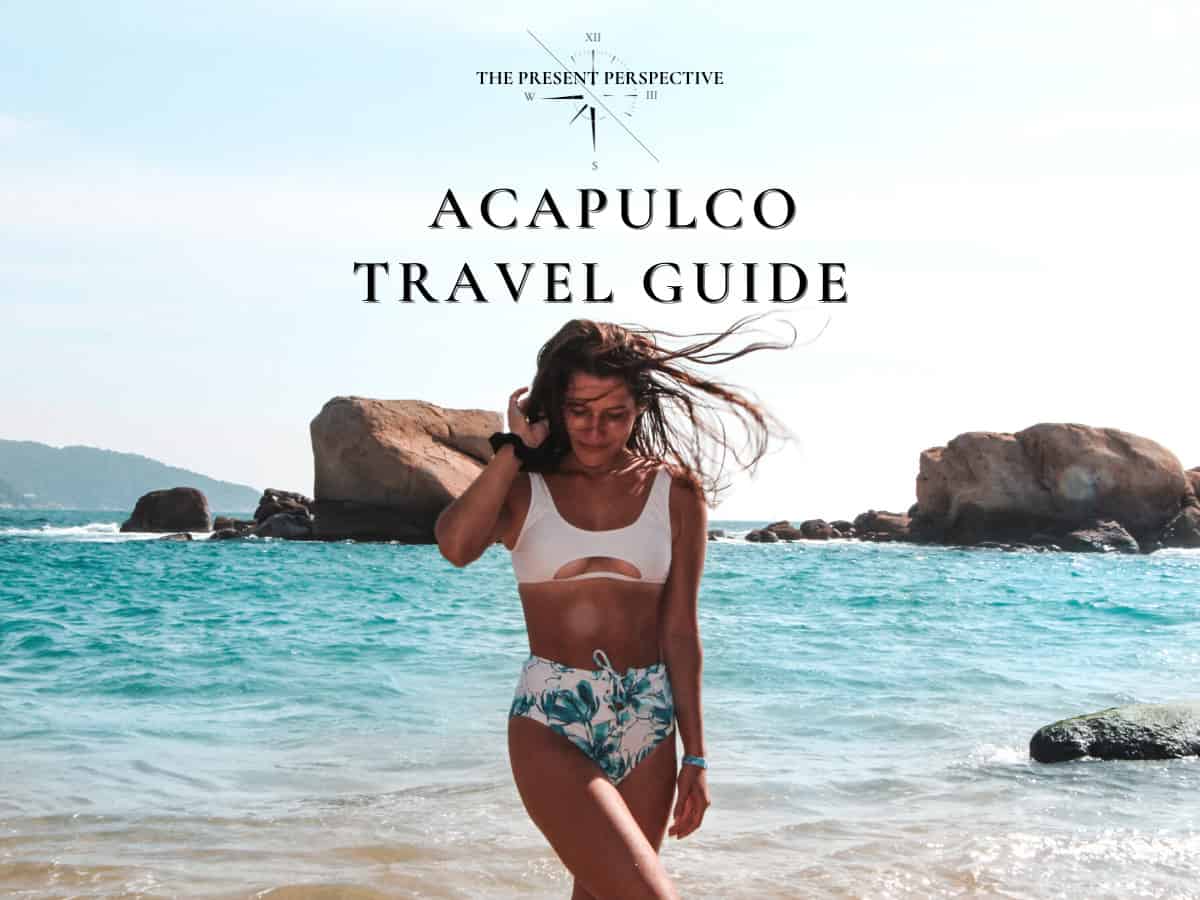
Acapulco Travel Guide: Safe to Visit? [2024]
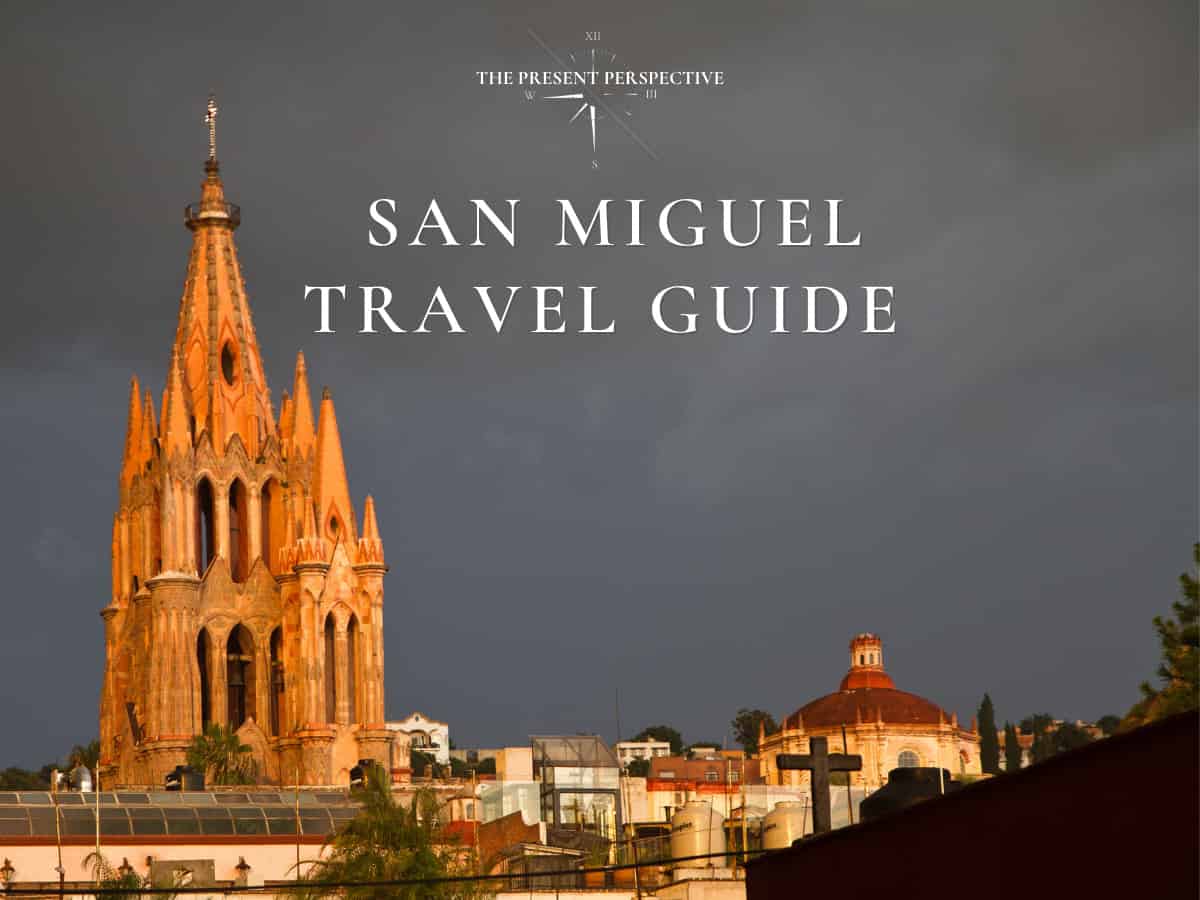
What Is So Special about San Miguel de Allende?

The Best Day Trips from Mexico City
Hi, I'm Greg. I'm an avid traveler who has traveled to over 50 countries all around the world with my wife and kids. I've lived in Italy, Mexico, China, and the United States, and I dream of moving abroad again in the future. With this blog, I provide my audience with detailed destination guides to my favorite places and pro-tips to make travel as stress-free as possible.
Leave a comment
Save my name, email, and website in this browser for the next time I comment.
Meet The Author - Greg

Recent Post

How Much Does a Trip to Egypt Cost: Budget Breakdown
March 10, 2024

Best Time to Visit the India Gate in Delhi [2024]
March 1, 2024

Flying with a Sinus Infection: Tips to Avoid Pain
February 20, 2024

11 Best Things to Do in Breckenridge Besides Skiing
February 12, 2024

10 Best Beaches in Mexico for Families (We Lived Here)
February 3, 2024

- English (EN)
- Español (ES)
- Português (BR)
Mexico : Safety by City
- Aguascalientes
- Cabo San Lucas
- Chichen Itza
- Guadalajara
- Isla Holbox
- Isla Mujeres
- Mexico City
- Nuevo Laredo
- Piedras Negras
- Playa del Carmen
- Puerto Morelos
- Puerto Vallarta
- Queretaro City
- San Luis Potosi
- San Miguel de Allende
- Zihuatanejo
Cuernavaca is the capital and largest city of the state of Morelos in Mexico.
The city is located around 86 km from Mexico City.
The name “Cuernavaca” means “surrounded by trees”.
Cuernavaca is known as the city of the eternal spring because of its warm weather that lasts almost all year.
For those who looking for an adventure, Cuernavaca will be a nice experience.
It has a great number of mountains, volcanoes, prairies, and rivers, where travelers can practice mountain climbing, caving, and rafting.
- Warnings & Dangers in Cuernavaca
OVERALL RISK: MEDIUM
The level of crime and violence is high in Cuernavaca. But it concerns only local bands and citizens. However, you should be more alert than usual here and not get too much attention in your behavior or clothes.
TRANSPORT & TAXIS RISK: LOW
Buses cover most of the city and surrounding areas and not costs much. These are not very comfortable but are enough safe and regularly used by the many foreign language students in the city. Taxi services safer if you take it from a smartphone application or from your hotel.
PICKPOCKETS RISK: MEDIUM
Tourists should be aware of caution every time they go outside. In crowds, markets or on public transportation you can fall victim to pickpockets. They can be very crafty and sometimes work in pairs.
NATURAL DISASTERS RISK: HIGH
Cuernavaca located in one of the world’s most seismologically active regions. The risk of earthquakes is permanently high here. Before planning a trip to here travelers should get information about the situation with natural hazard risks.
MUGGING RISK: MEDIUM
In Mexico, it is easy enough to become a victim of a robbery. In the Cuernavaca area, it is safe enough cause it's not so popular tourist place.
TERRORISM RISK: MEDIUM
Due to drug dealer crimes, terrorism risk exists in that region. Most of the terrorist attacks don't affect tourists and covered by police asap but may affect citizens as well.
SCAMS RISK: LOW
Scam risk is low here cause the place doesn't get many tourists. But travelers should be aware anyway and buy things at verified places to avoid cheating.
WOMEN TRAVELERS RISK: MEDIUM
In Cuernavaca women with “European” features could attract excessive attention. It's recommended to women not to show up on the streets at night and has modest clothes.
- So... How Safe Is Cuernavaca Really?
Cuernavaca is considered a not so safe place.
The index of crime is as high as and the possibility of being mugged.
But here mostly no problems with safety on the streets, except perhaps after dark.
For women as usual in Mexico is recommended not to wear jewelry and look alert and humble and be kind.
Most problems here are with local gang issues and corruption.
And it doesn’t affect tourists and students, who are a lot in this city.
Cuernavaca has a lot of international students who come to study Spanish.
Cuernavaca once had hundreds of foreign students studying Spanish in its numerous excellent language schools.
The descent in enrollments is due to violence in the country as a whole.
But the schools have high security and their administrations insist that they are safe and their students not victims of violence.
So the city has protected by the police and ordinary peoples are not affected by a showdown of bands.
Petty crime is common, but pickpockets and purse-snatchers are not as many as in other touristic places, even as in Europe.
Travelers must follow the State Department’s guidelines for precautions in areas of criminal incidents and keep valuable belongings in a safe place or not show it on the streets.
- How Does Cuernavaca Compare?
- Useful Information
No visas required for tourist proposals to enter Mexico for many countries of Europe, US citizens and so on. You should have a valid passport and a tourist permit. The maximum possible of stay is 180 days. For a longer stay of other options, you should visit the Mexican embassy.
The Mexican peso - is the official currency in Mexico. There are one hundred Mexican centavos to every peso. The symbol for the Mexican Peso is $, so you can see MX$ or MN$ in banks and exchange points.
Cuernavaca was nicknamed "City of Eternal Spring" because of fairly constant temperature during a year. The average temperatures in Cuernavaca vary little. Most of the year the city has a nice temperature. A comfortable temperature is from March to May. The dry season is in December, January and March.
Cuernavaca has an International Airport - General Mariano Matamoros International Airport. It located sixteen kilometers from Cuernavaca. Serves local and international flights of Cuernavaca.
Travel Insurance
The medical insurance for travelers should be prepared before starting your trip to Mexico. As well as in other countries, the customs officer can ask you to show travel insurance.
Cuernavaca Weather Averages (Temperatures)
- Average High/Low Temperature
Mexico - Safety by City
- Where to Next?
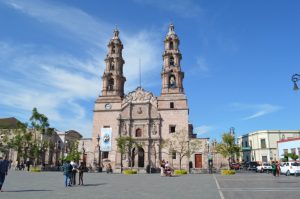
4 Reviews on Cuernavaca
Cuernavaca means “cow” (vaca) “horn” (cuerna)
From a local
This has no reference to sources for this article. I have lived in Cuernavaca for the past 35 years & all that is written here is out of date. Gang crime is in outlying cities & towns of the state, not in Cuernavaca, the capital. The dangerous areas are now in Cancun, Playa de Carmen & the central states of Zacatecas, Guanajuato etc for transport routes to the American drug market. There are plenty of tourists here but from Germany, France, Europe and Nationals who come for the culture & history, not to party on beaches. This is VERY old information & outdated.
Can you recommend a good hotel for 2 weeks for a woman traveler?
Thank you Georgia
Share Your Experience Cancel reply
Your Review
Title of your review
Article Contents
- Cuernavaca : Safety by City
- Overall Risk
- Transport & Taxis Risk
- Pickpockets Risk
- Natural Disasters Risk
- Mugging Risk
- Terrorism Risk
- Women Travelers Risk
- Weather Averages (Temperatures)
- User Reviews
- Share Your Experience
Popular Destinations

Safety Index
Recent reviews & comments.
- amora on 15 Pros and Cons of Living in Jamaica
- M.... on Amman
- Anton on Jordan
- Silv on Odesa
- Anonymous on Afghanistan
Popular US States
- Pennsylvania
- Search Please fill out this field.
- Manage Your Subscription
- Give a Gift Subscription
- Sweepstakes
U.S. Issues Travel Warning for Mexico Ahead of Spring Break
The warning is asking travelers to “travel smart” and “be informed."
:max_bytes(150000):strip_icc():format(webp)/alison-fox-author-pic-15f25761041b477aaf424ceca6618580.jpg)
marako85/Getty Images
The United States is warning travelers heading to Mexico to be aware of their surroundings ahead of the spring break holiday season.
The warning , which was issued this week by the U.S. Embassy and Consulates in Mexico, reminds travelers to “travel smart” and “be informed” as “thousands of U.S. citizens visit Mexico during spring break” each year. The embassy continued that “while the vast majority travel safely,” visitors should be aware of issues with crime, drugs, unregulated alcohol, drownings, and more.
“Crime, including violent crime, can occur anywhere in Mexico, including in popular tourist destinations. Travelers should maintain a high level of situational awareness, avoid areas where illicit activities occur, and promptly depart from potentially dangerous situations,” the embassy warned. “U.S. citizens should exercise increased caution in the downtown areas of popular spring break locations including Cancun, Playa Del Carmen, and Tulum, especially after dark.”
The warning also reminded American travelers that drug possession and use is illegal in Mexico, including medical marijuana. It also advised that unregulated alcohol may be contaminated, that counterfeit medication is common, and that guns are illegal in Mexico.
When it comes to the country’s popular beaches, the embassy reminded travelers some beaches may have strong rip tides and “may lack lifeguards, warnings, or signs of unsafe conditions.”
The U.S. Embassy and Consulates in Mexico issued a similar spring break warning last year .
The U.S. Department of State classifies different states in Mexico under different warning levels. While travelers can “exercise normal precautions” when traveling to the Campeche and Yucatan states, the State Department warns them to “exercise increased caution” when heading to places like Baja California Sur (where Los Cabos is), Mexico City, and Quintana Roo (where Cancun is) due to crime.
The State Department also asks American travelers to “reconsider” going to the state of Jalisco, which is home to popular destination Puerto Vallarta , due to the danger of crime and kidnapping.
The State Department recommends Americans who do travel to Mexico keep people at home informed of their travel plans and enroll in the department’s Smart Traveler Enrollment Program (STEP) to both receive alerts and make it easier to locate them if an emergency occurs.
Travelers heading to international destinations can view all current travel advisories on the State Department's website at travel.state.gov .
We’re sorry, this site is currently experiencing technical difficulties. Please try again in a few moments. Exception: request blocked
The Best Time to Visit Cuernavaca, Mexico for Weather, Safety, & Tourism
The best times to visit Cuernavaca for ideal weather are
October 15th to February 18th
based on average temperature and humidity from NOAA (the National Oceanic and Atmospheric Administration). Read below for more weather and travel details.
Cuernavaca Travel Guide
Temperature.
- Perceived Temperature
- Rain and snow
- Humidity and wind
- The busiest and least popular months
- Overall travel experience by time of year
Other Cuernavaca Travel Info
Weather in cuernavaca.
Average temperatures in Cuernavaca vary little. Considering humidity, temperatures feel nice most of the year, excluding some hot weeks in the summer, with a low chance of precipitation most of the year. The area is somewhat temperate — in the 55th percentile for pleasant weather — compared to tourist destinations worldwide. Weeks with ideal weather are listed above . If you’re looking for the very warmest time to visit Cuernavaca, the hottest months are April, May, and then March. See average monthly temperatures below. The warmest time of year is generally early to mid May where highs are regularly around 95.1°F (35.1°C) with temperatures rarely dropping below 66.7°F (19.3°C) at night.
Cuernavaca Temperatures (Fahrenheit)
Cuernavaca temperatures (celsius), “feels-like” temperatures.
The way we experience weather isn’t all about temperature. Higher temperatures affect us much more at higher humidity, and colder temperatures feel piercing with high winds. Our perceived temperatures factor in humidity and wind chill to better represent how hot or cold the day feels to a person.
Cuernavaca Perceived Temperature (F)
Cuernavaca perceived temperature (c), average cuernavaca temperatures by month.
Daily highs (averaged for the month) usually give the best indication of the weather. A significantly lower mean and low generally just means it gets colder at night.
Show Fahrenheit
Show celsius, precipitation (rain or snow).
If dry weather is what you’re after, the months with the lowest chance of significant precipitation in Cuernavaca are January, December, and then March. Note that we define “significant precipitation” as .1 inches or more in this section. The lowest chance of rain or snow occurs around early January. For example, on the week of January 1st there are no days of precipitation on average. By contrast, it’s most likely to rain or snow in early September with an average of 3 days of significant precipitation the week of September 3rd.
Chance of Precipitation
The graph below shows the % chance of rainy and snowy days in Cuernavaca.
Snow on the Ground
The graph below shows the average snow on the ground in Cuernavaca (in).
Average Rain and Snow by Month
Show inches, show centimeters, humidity and wind.
Cuernavaca has some comfortably humid months, with some very dry months. The least humid month is April (19.1% relative humidity), and the most humid month is September (58.5%).
Wind in Cuernavaca is usually extremely calm . The windiest month is April, followed by March and February. April’s average wind speed of around 2.4 knots (2.8 MPH or 4.5 KPH) is considered “light air.” Maximum sustained winds (the highest speed for the day lasting more than a few moments) are at their highest in late April where average top sustained speeds reach 10.2 knots, which is considered a gentle breeze.
Relative Humidity (%)
The graph below shows the average % humidity by month in Cuernavaca.
The graph below shows wind speed (max and average) in knots.
Average Wind Speeds
Show wind speeds.
All wind speeds are in knots. 1 knot = 1.15 MPH or 1.85 KPH.
Show Relative Humidity by Month
Is it safe to travel to cuernavaca.
Our best data indicates this area is somewhat safe, but with extra warnings in a few regions. As of Dec 04, 2023 there are travel warnings and regional advisories for Mexico; exercise a high degree of caution and avoid some areas. Check this page for any recent changes or regions to avoid: Travel Advice and Advisories . This advisory was last updated on Dec 04, 2023.
The Busiest and Least Crowded Months
The busiest month for tourism in Cuernavaca, Mexico is February, followed by January and March. Prices for hotels and flights will be most expensive during these months, though you can save if you purchase well in advance. Tourists are unlikely to visit Cuernavaca in December. Those willing to visit at these times will likely find it the least expensive month.
Estimated Tourism by Month
Most popular months to visit, overall cuernavaca travel experience by season, spring (march through may).
Humidity and temperatures combine to make this season feel warm. Highs range from 95.1°F (35.1°C) and 89.5°F (31.9°C) with similar temperatures in the later months. Rain is rare with 1 to 5 days of significant precipitation per month. Spring is the busiest for tourism, which makes it a good time for those looking for things to do.
Summer (June through August)
The middle-year months have very comfortable weather with high temperatures that are quite warm. These months see the most precipitation with 8 to 12 days of precipitation per month. June – August is the slowest season for tourism in Cuernavaca, so lodging and other accommodations may cost less than usual.
Fall (September through November)
Fall daily highs range from 84.3°F (29.1°C) and 82°F (27.8°C), which will feel very nice given the humidity and wind. It rains or snows a significant amount: 1 to 11 days per month. Tourism is fairly slow during these months due to the weather, so hotels may be lower priced.
Winter (December through February)
Weather is perfect this time of year in Cuernavaca to be enjoyable for warm weather travelers. The average high during this season is between 90.7°F (32.6°C) and 81.9°F (27.7°C). On average, it rains or snows a very small amount: 0 to 1 times per month. These times of year are the second busiest with tourists.
Best Times to Travel › Mexico › Cuernavaca, Mexico
Similar Destinations
- Tres de Mayo, Mexico
- Jiutepec, Mexico
- Temixco, Mexico
- Crucero Tezoyuca, Mexico
- Tepoztlan, Mexico
- Xochitepec, Mexico
- Yautepec, Mexico
- Amatlan, Mexico
- Ticuman, Mexico
- Cocoyoc, Mexico
Popular Destinations
- Hamburg, Germany
- Madrid, Spain
- Petaling Jaya, Malaysia
Is Cuernavaca Safe for Travel in 2024?

Mexico : Safety by City
- Aguascalientes
- Cabo San Lucas
- Chichen Itza
- Guadalajara
- Mexico City
- Playa del Carmen
- Puerto Vallarta
- Queretaro City
- San Luis Potosi
- San Miguel de Allende
- Zihuatanejo
Cuernavaca is the capital and largest city of the state of Morelos in Mexico. The town is located around a 90-minute drive south of Mexico City using the Federal Highway 95D.
Warnings & Dangers in Cuernavaca

OVERALL RISK : MEDIUM
Cuernavaca is not the safest place for travelers, but you can avoid most of the troubles if you use common sense and take precautions.

TRANSPORT & TAXIS RISK : MEDIUM
Public transport is not well-developed. Traffic on the roads can be very busy and unsafe. Pickpockets are common on buses. Use only licensed taxi services.

PICKPOCKETS RISK : HIGH
Pickpocketing occurs in Cuernavaca at every turn, so wear an anti-theft backpack, look after your belongings, and don't leave your phones and wallets unattended. In crowded places, keep an eye on your surroundings.

NATURAL DISASTERS RISK : MEDIUM
Cuernavaca is located in one of the world’s most seismology-active regions. The risk of earthquakes is permanently high here. Before planning a trip here, travelers should get information about the situation with natural hazard risks.

MUGGING RISK : MEDIUM
In the suburbs of Cuernavaca, local gangs' showdowns take place, during these showdowns, there are shootings and kidnappings. Avoid these areas and don't get involved with drugs.

TERRORISM RISK : MEDIUM
Terrorist attacks in the city are often associated with internal political showdowns. External threats from terrorist organizations usually do not exist in the city.

SCAMS RISK : MEDIUM
Fraud is commonly associated with street vendors offering counterfeit goods to tourists. Don't buy them even if the price is very attractive. Also, only withdraw money from ATMs at banks with cameras to avoid skimming your card.

WOMEN TRAVELERS RISK : HIGH
Women traveling alone in Cuernavaca should avoid late-night walks and be very discreet on the city streets. Heightened precautions won't hurt.
How Safe Is Cuernavaca for Tourists?
Cuernavaca is a rather unsafe city.
The crime index here is at a high level.
The main problems are related to corruption, drug trafficking, and attacks.
It is rather unsafe here at night.
It is better not to walk around the city at night and avoid poorly lit places and areas.
Also, use a taxi to get home.
Don’t carry a lot of precious things on you or with you.
Also, don’t shine with a lot of cash and electronic devices.
All of this attracts criminals and can end badly for you.
It is better for women to wear modest clothes and not draw attention to themselves with noisy behavior.
Most of the issues here are related to the problems of local gangs and corruption.
And this does not in any way affect tourists and students, of whom there are many in this city.
Cuernavaca has many international students who come to study Spanish.
There is a police presence in the city, but this also means that you may often be asked to show your documents.
Always carry your passport or copy with you to show to the police officer.
Petty crimes are common, but pickpockets and wallet extortionists are not as numerous as in other tourist destinations, even as in Europe.
Travelers should follow the Department of State’s guidelines for precautions at crime scenes and store valuables in a safe place or not show them on the street.
Do I Need a Visa to Visit Cuernavaca?
No visas are required for tourist proposals to enter Mexico for many countries of Europe, US citizens, and so on. You should have a valid passport and a tourist permit. The maximum possible stay is 180 days. For a longer stay or other options, you should visit the Mexican embassy.
Which Currency Is Used in Cuernavaca?
The Mexican peso – is the official currency in Mexico. There are one hundred Mexican centavos to every peso. The symbol for the Mexican Peso is $, so you can see MX$ or MN$ in banks and exchange points.
How's the Weather like in Cuernavaca?
In Cuernavaca, the wet season is overcast; the dry season is partly cloudy and warm year-round. The best time of year to visit Cuernavaca for warm-weather activities is from mid-February to mid-May.
What Do I Need to Know about Airports in Cuernavaca?
General Mariano Matamoros International Airport, or Cuernavaca International Airport, is an international airport located sixteen kilometers south of Cuernavaca, in the suburb of Temisco, State of Morelos, Mexico. Serves local and international flights to the city of Cuernavaca.
Should I Get Travel Insurance for My Travels?
A travel insurance policy is a must when visiting a foreign country or city. Make sure you got it before starting your journey; the customs officer may ask for it.
What Are Some Things to Do in Cuernavaca?
Nicknamed the “City of Eternal Spring” for its warm year-round weather and idyllic surroundings, Cuernavaca has long been a popular destination for the capital’s residents, home to some of Mexico’s finest spas and boasting a vibrant Spring Fair and carnival festivals. Here you can explore the central squares of Zocalo and Jardín Juarez, dotted with colorful market stalls, restaurants, and cafés and surrounded by attractions such as the Palacio de Gobierno Palacio Cortes and the Cathedral, and more.
Is the Water in Cuernavaca Safe to Drink?
Tap water is safe to drink.
Is Uber Safe in Cuernavaca?
There is no Uber taxi in Cuernavaca. You can use any other local taxi services.
More Travel Destinations
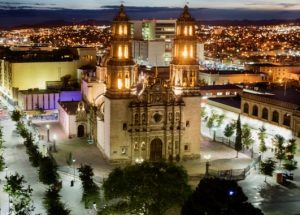

Cuernavaca Mexico: A Guide to the City of Eternal Spring
Sharing is caring!
Welcome to Cuernavaca, the enchanting jewel nestled in the State of Morelos , renowned as the “City of Eternal Spring.”
As you traverse through its cobblestone streets and vibrant plazas, you’ll quickly discover why Cuernavaca has earned this poetic moniker.
Basking in a perpetual state of mild and temperate weather, this city captivates visitors with its lush landscapes, rich history, and a culture that seamlessly blends indigenous roots with colonial influences.
Join me on a virtual journey as I unveil the essence of Cuernavaca Mexico, providing a comprehensive guide to help you navigate this charming destination where every season feels like spring.
From historic landmarks to local treasures, culinary delights to cultural experiences, this exploration will unveil the many facets that make Cuernavaca a true haven for those seeking an unforgettable getaway. ¡Bienvenidos a Cuernavaca!
Getting from Mexico City to Cuernavaca
To travel from Mexico City to Cuernavaca , you have several transportation options, including bus, car, or even a combination of metro and bus.
Depending on traffic conditions, the ride takes around 1.5 hours.
Here are the common ways to make the journey:
- Bus : One of the most convenient and economical travel methods is by bus. Several bus companies run between Mexico City and Cuernavaca. The bus journey takes approximately 1.5 to 2 hours, depending on traffic and the specific bus service. Bus terminals in Mexico City that offer services to Cuernavaca include Terminal de Autobuses de Pasajeros de Oriente (TAPO) and Terminal de Autobuses de Pasajeros de la Ciudad de México (Taxqueña) .
- Car : If you prefer driving, you can take the Autopista del Sol (toll road) from Mexico City to Cuernavaca. The journey usually takes around 1 to 1.5 hours, depending on traffic conditions. Make sure to consider the toll fees and check the current road conditions before starting your journey.
- Metro and Bus : You can take Line 2 of the Mexico City Metro to Tasqueña station. From there, you can catch a bus to Cuernavaca. The bus ride will take you to the terminal in Cuernavaca. This option may take longer than a direct bus or car, but it’s a more affordable choice.
Before making any travel plans, it’s advisable to check the current schedules, availability, and any travel restrictions.
You may want to read : Mexico City’s Magic: 45 Places You Can’t Afford to Miss
Additionally, consider the time of day you plan to travel, as traffic conditions can vary. Always check for the most up-to-date information on transportation options.
TOP 15 Things to do in Cuernavaca, Mexico
Because of its location, Cuernavaca offers endless things to do within the city and the surroundings.
But for now, I’ll leave you with what I consider the most popular things to do and see around here. Enjoy!
1. Visit Tepoztlán Magical Town
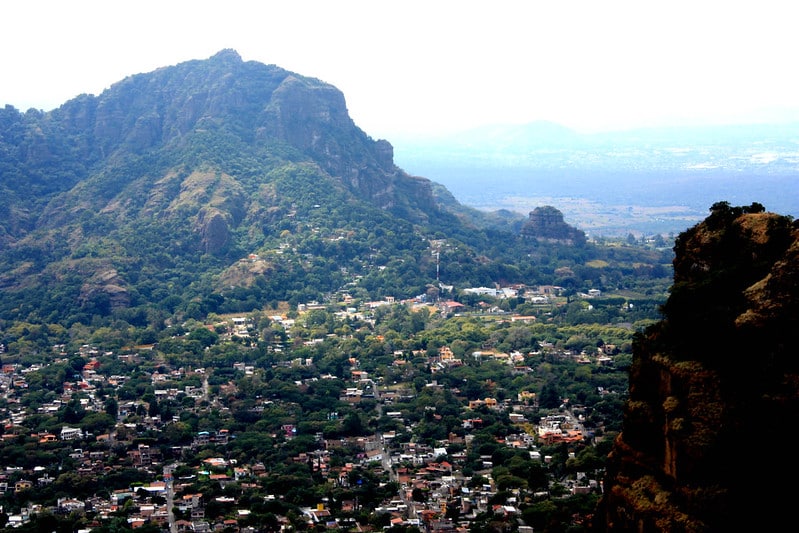
Tepoztlán is in the north of Morelos and due to its history and traditions it has been named a Magical Town since 2002.
It is about an hour and a half from Mexico City and 20 minutes from downtown Cuernavaca.
The main attraction is to climb the Tepozteco hill and visit the temple of Tepoztécatl, the admission fee is 50 pesos per person. It’s free on Sundays!
If you decide to go, wear comfortable clothes and shoes, sunscreen, and a hat because you are in for a long hike.
Read the full guide to Tepoztlan
On your visit to Tepoztlán, you can have a good time browsing the stalls of the famous tianguis of typical handicrafts (flea market) from the state of Morelos.
Also, if you like ice cream, this Magical Town is home to some of the best in the country!
2. Jardines de Mexico (The Gardens)

Exploring the Jardines de Mexico is a MUST in Cuernavaca, a flower theme park open from Tuesday to Sunday from 9 am to 6 pm.
Inside you can go through each of its gardens with different themes.
Jardines de Mexico is an excellent place for families where children can play and learn about the environment.
Also, if you like to go out with your dogs you can take them paying their entrance fee.
Only one dog per adult on a leash is allowed during your visit.
Inside the park there’s a Mexican food restaurant, on weekends they have breakfast and lunch buffet. Eating here doesn’t include the entrance to the gardens .
The entrance fee is 275 pesos. Seniors and children pay 225 pesos. You get a discount if you purchase them online at https://www.jardinesdemexico.com
3. Explore Xochicalco
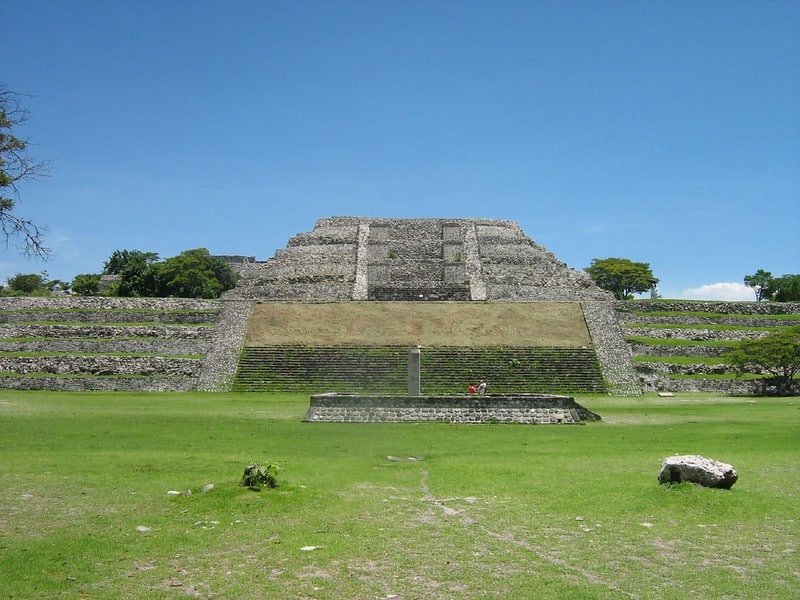
Xochicalco is an archaeological site in Cuernavaca and has been declared a World Heritage Site by UNESCO since 1999.
The name Xochicalco is a Nahuatl word xochi-flor and cal-casa , meaning “place of the house of flowers.”
Within the archaeological zone, you’ll find several structures in which the pyramid of the god Quetzalcoatl , also known as the feathered serpent stands out.
Also in Xochicalco, you can observe 3 fields where they used to play “ball game.”
How much does it cost to enter the pyramids of Xochicalco?
The entrance fee to the archaeological site is 90 pesos per person. Open every day from 9:00 am to 5:30 pm.
There’s also a site museum where various interesting pieces are showcased.
4. Relax in Agua Hedionda
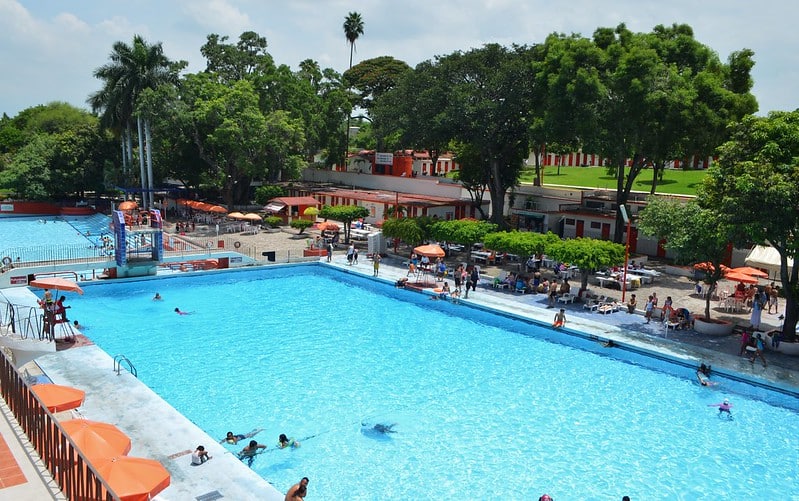
Agua Hedionda is a “natural SPA” in Cuautla (about an hour from Cuernavaca) famous for its waters with mineral properties.
It is considered one of the most important natural springs in Mexico.
Some of the services available are public and private pools, water slides, and splash pads.
Also green areas, barbecue grills, soccer field, gym, locker rooms, and some additional services.
The entrance fee is 50 pesos and 30 pesos for children and seniors. Open every day from 7 am to 5 pm.
There’s also a nice restaurant and cafe if you want to get breakfast and/or lunch.
5. Jardin Borda (Borda Garden)
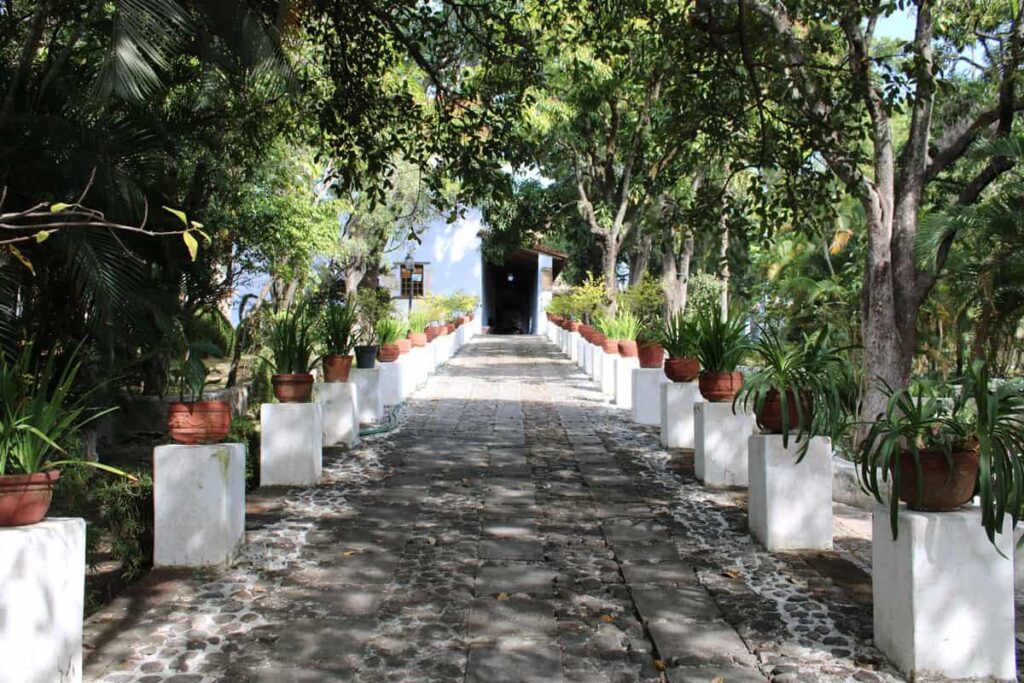
Visiting Jardin de Borda is another excellent option in the heart of Cuernavaca.
It is a colonial house built by José de la Borda . Inside it has several gardens and an artificial lake.
Besides being a botanical garden, it has a museum where cultural events are held, such as exhibitions, concerts, courses, and workshops on contemporary art.
Because it was one of Maximiliano and Carlota’s favorite summer destinations, the roads between Mexico City and Cuernavaca were improved.
It is undoubtedly a place full of nature, tranquility, and history that you cannot miss on your visit to the city of eternal spring.
6. Admire the Palace of Cortes
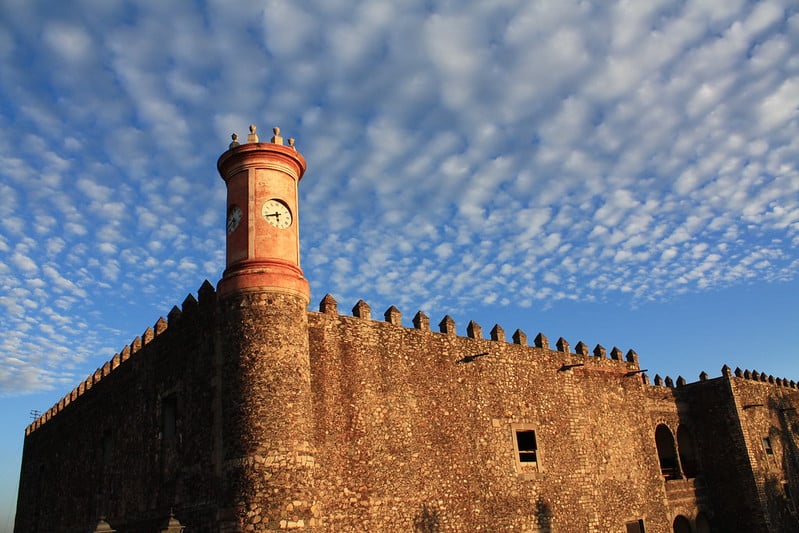
Now called Museo Regional Cuauhnáhuac , this palace boasts an impressive medieval-like construction from the 16th century and a lot of history.
Open Tuesday through Sunday from 9:00 am to 6:00 pm. The entrance fee is 90 pesos per person.
You probably know about Hernán Cortes (Spanish conquistador who led an expedition that caused the fall of the Aztec Empire and brought large portions of what is now mainland Mexico under the rule of the king of Castile in the early 16th century) .
Well, Mr. Cortes ordered the construction of a residence where the Palacio de Cortes is currently located.
Throughout history it has been used in different ways as the jail where José María Morelos was imprisoned, Maximilian’s office, and the seat of the Mexican government.
It is a museum where some objects related to different periods of the history of our country are exhibited. From the pre-Hispanic period to the present day.
This palace also has an emblematic clock located in one of its towers, and it has been witness to the history and some historical events of Cuernavaca.
7. Discover Teopanzolco
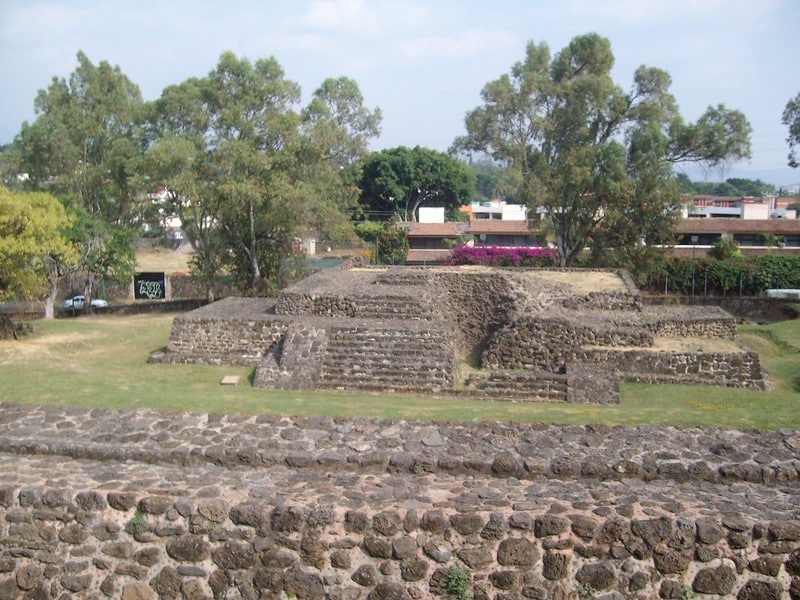
You are probably looking for another archaeological site to go to near Cuernavaca. Right?
Well, this is it! This mystical site, Teopanzolco (also known as the devil’s house because of the human sacrifices that took place there) is just north of the city.
The name Teopanzolco comes from the Nahuatl words teopan-temple, zolli-old so its meaning is “in the old temple.”
This archaeological site is located in the Vista Hermosa neighborhood. Open Wednesday to Sunday from 9:00 am to 4:00 pm.
The entrance fee is 85 pesos per person, I recommend you to wear comfortable clothes and shoes so you can enjoy your tour to the fullest.
8. Stay at Las Mañanitas Hotel, Cuernavaca Mexico

This iconic luxurious boutique hotel is just 1 km from downtown Cuernavaca. It was built in an old colonial Hacienda and opened its doors in 1955.
Something very characteristic that you can appreciate inside the hotel is its gardens that transmit tranquility.
You can also see exotic and beautiful birds.
Not only does it offer lodging and its traditional gardens, but it also has a world-class restaurant, spa, and swimming pool.
Again, the restaurant is top-notch and has very good reviews, you can enjoy typical Mexican or international food. It also has a wine list with more than 200 international labels.
Learn more and get the best rates at Las Mañanitas .
The whole place is decorated in an elegant colonial style including an extensive art collection.
9. Casino de la Selva (Jungle Casino)
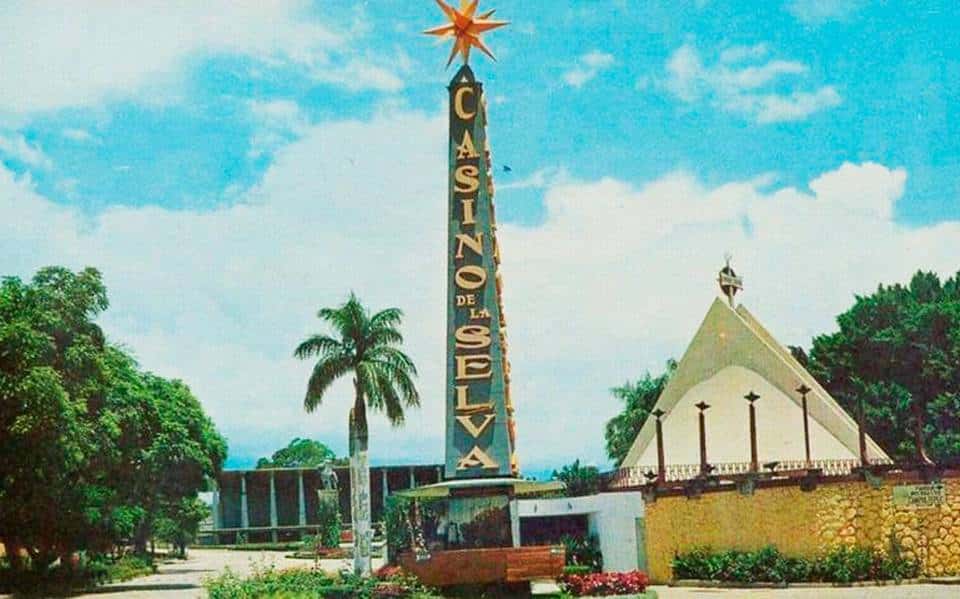
Continuing with the list of things to do in Cuernavaca, now it’s time to talk about a classic must-visit place.
In 1930 the plan to build a gambling house began and in 1931 the Hotel Casino de la Selva was inaugurated.
It seems that the proximity to Mexico City and the climate of Cuernavaca were two of the most important factors to build in this city.
Today this place no longer exists but due to the importance it took at the time it has become a landmark to the capital of Morelos.
Some time later the place was acquired by a company to create the commercial complex it is known today.
10. Robert Brady Museum
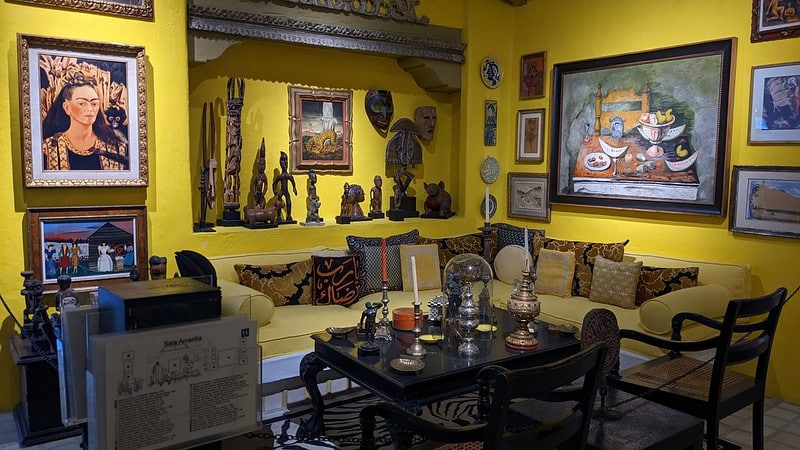
This museum was the house of American collector and artist Robert Brady who left a large collection of about 1400 pieces of art. It is also known as “Casa de la Torre.”
He collected them during his travels around the world.
Therefore, some of the pieces that you can find on your visit to the museum are furniture, works of art, pre-Hispanic pieces, sculptures, ceramics, and everything he collected.
After you finish touring the museum, you can enjoy a cup of coffee in the main courtyard.
It is open Tuesday to Sunday from 10:00 am to 6:00 pm and has an entrance fee of 50 pesos.
11. Admire the San Anton Waterfall
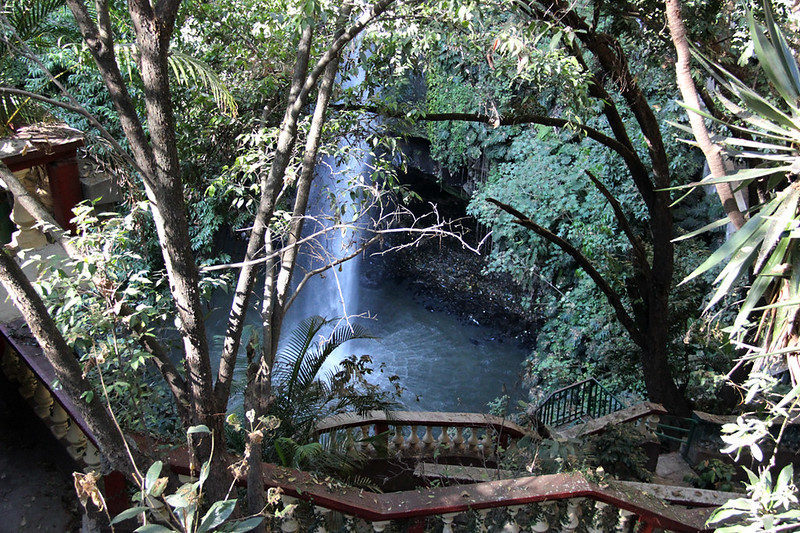
The waterfall of San Anton is not to be missed on your next visit to Cuernavaca, Mexico. It is very close to downtown so there are no excuses.
To get to the viewpoint and appreciate the fall of approximately 40 meters surrounded by vegetation you will have to descend a 100-meter staircase.
The surrounding cliff is formed by basaltic prisms and igneous rocks, formed by the slow cooling of lava.
The entrance to the waterfall is free and opens every day from 10:00 am to 6:00 pm.
In the surroundings, besides appreciating the scenery you can find some stalls selling handicrafts and almost at the entrance there is a restaurant.
12. Cuernavaca’s Cathedral
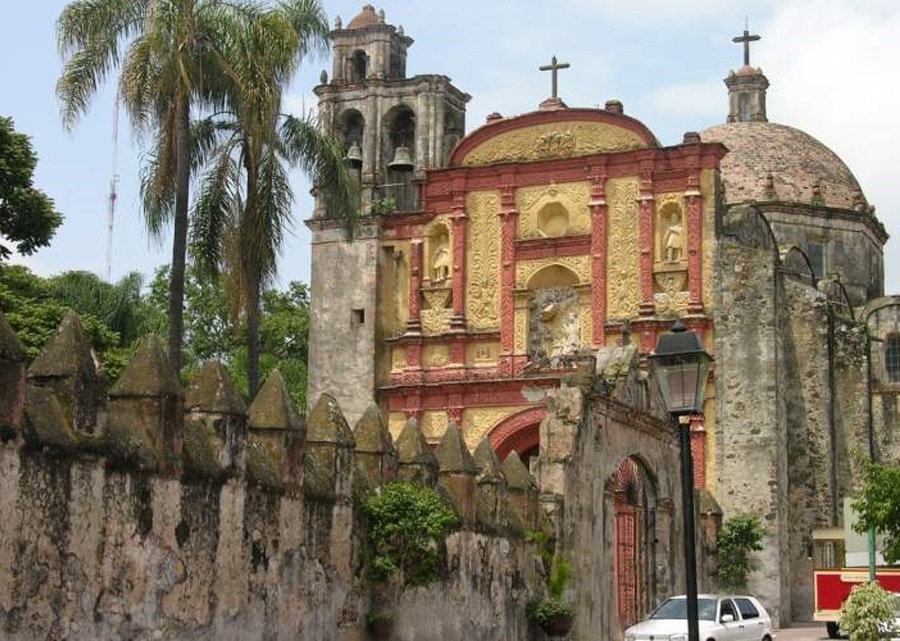
One of the most beautiful places in Cuernavaca that you may want to visit is the Cathedral of Cuernavaca (downtown) .
It is built in a baroque-style building from the XVI century. It is considered one of the oldest cathedrals in the country.
The cathedral is part of the “first monasteries” on the slopes of Popocatepetl. It was also declared by Unesco as a World Heritage Site in 1994.
What was the use of the Cathedral of Cuernavaca?
It was established in 1525 by the first twelve friars who arrived in the country and has been occupied as the Diocese of Cuernavaca ever since.
It is currently known as the Cathedral of the Assumption.
13. The Chapitel and Temple of San Jose el Calvario
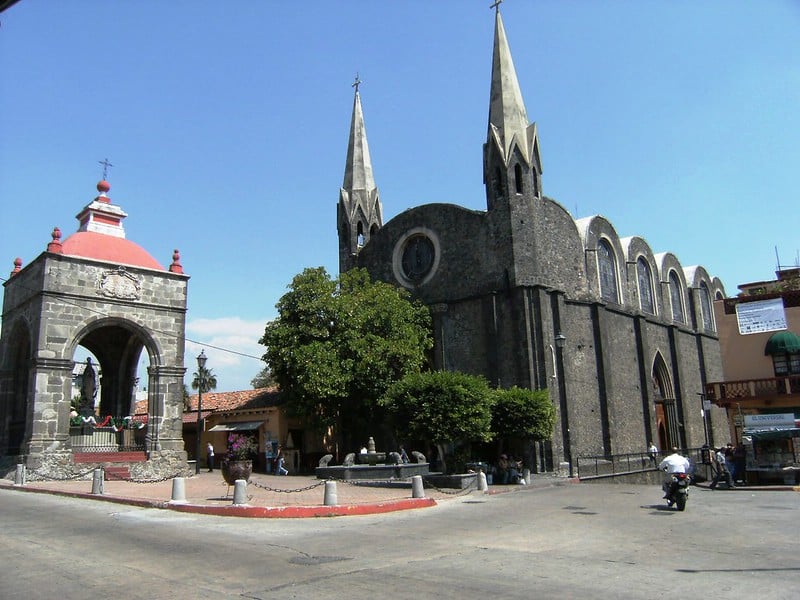
The “Chapitel” and “El Templo de San José el Calvario” are two religious buildings in the center of the capital of Morelos.
The first building is dedicated to the Virgin of Guadalupe and is where people go every year on December 12th to celebrate her birthday.
The second building (San Jose el Calvario) was built to provide a regular church service for the residents of Cuernavaca.
So now you know, if you are in downtown Cuernavaca you can enjoy a walk outdoors and visit this set of buildings.
14. La Tallera de Siqueiros, Cuernavaca Mexico
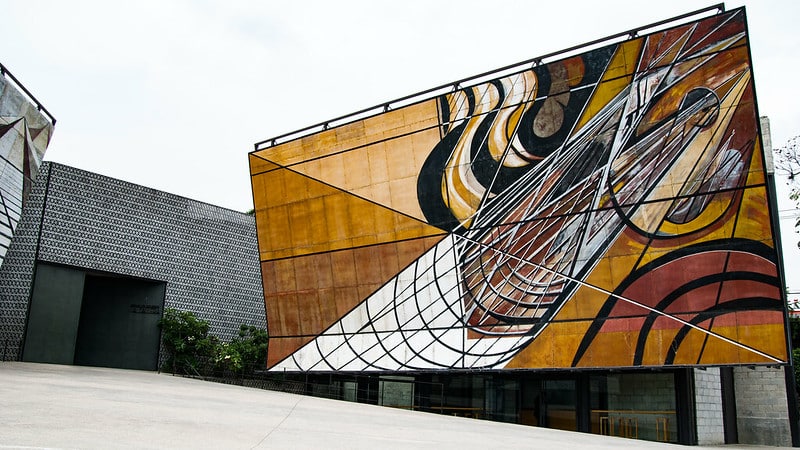
Do you know about David Alfaro Siqueiros? He is considered one of the three best Mexican muralists, along with Diego Rivera and Jose Clemente Orozco .
La Tallera (workshop) was one of Siqueiros’ homes where he created some of his works and spent the last years of his life.
It has 4 exhibition halls : Three of them permanently exhibit works of Siqueiros and other artists and in the fourth one there are temporary exhibitions.
This famous workshop museum is located at Venus St. 52 Col. Jardines de Cuernavaca and is open Tuesday to Sunday from 10 am to 6:00 pm with no entrance fee.
Also inside the museum, workshops in literature, painting, and photography are offered.
15. Eat at Casa Hidalgo
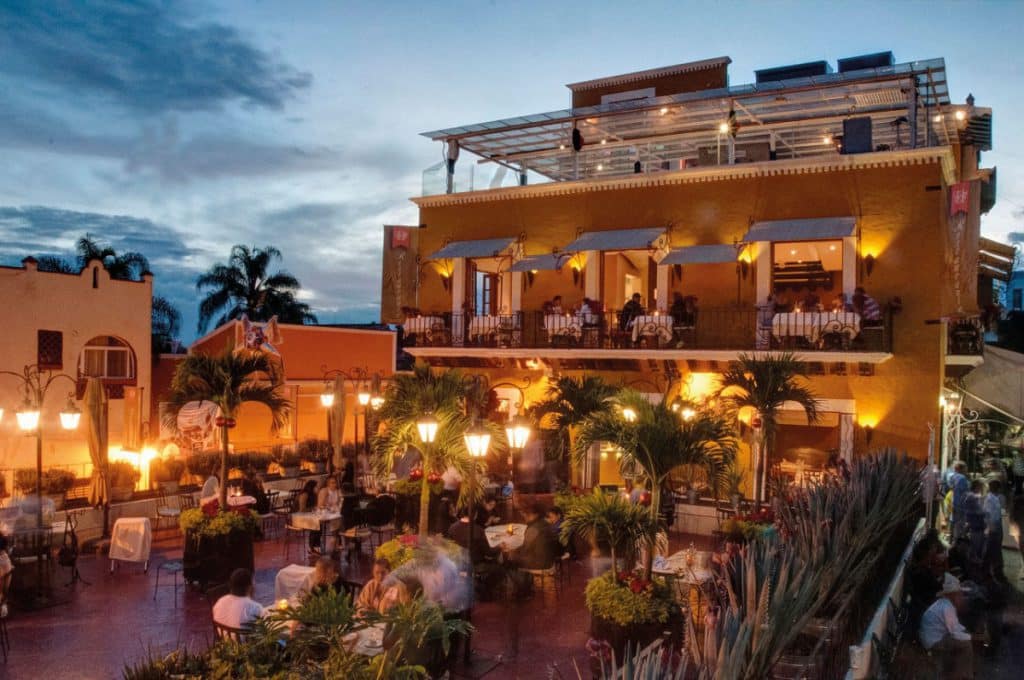
We are almost at the end of this article, but of course, we can’t miss a good place to eat in Cuernavaca.
I’m now going to talk about Casa Hidalgo , a famous terrace that has become an icon among the restaurants in the city.
In this restaurant, you can find different types of dishes either typical Mexican specialties or you can also choose from a variety of international foods.
An example of their menu is duck tacos, sopes with jerky, salads, black bean cream soup, fettuccini, pork loin with pipian, and many others.
Casa Hidalgo is open Monday to Thursday from 8:30 am to 11:00 pm, Friday and Saturday from 8:30 am to midnight, and on Sundays from 8:30 am to 10:30 pm.
Cuernavaca Mexico: Conclusion
As you can see, Cuernavaca Mexico truly lives up to its title as the City of Eternal Spring.
From its year-round pleasant climate to its rich history, vibrant culture, and stunning natural beauty, Cuernavaca offers a unique and enchanting experience for visitors.
Whether you’re exploring historic landmarks, indulging in delicious cuisine, or simply taking in the picturesque landscapes, this city has something to offer for every traveler.
As you navigate the cobbled streets and immerse yourself in the local atmosphere, you’ll discover the warmth and hospitality of the people, making your stay in Cuernavaca an unforgettable journey.
With its diverse attractions, from the iconic Palacio de Cortés to the lush Jardín Borda, this city invites you to savor the essence of Mexico in a tranquil and charming setting.
Cuernavaca, the City of Eternal Spring, awaits with open arms, ready to share its beauty and warmth with those who venture into its welcoming embrace.
Similar Posts
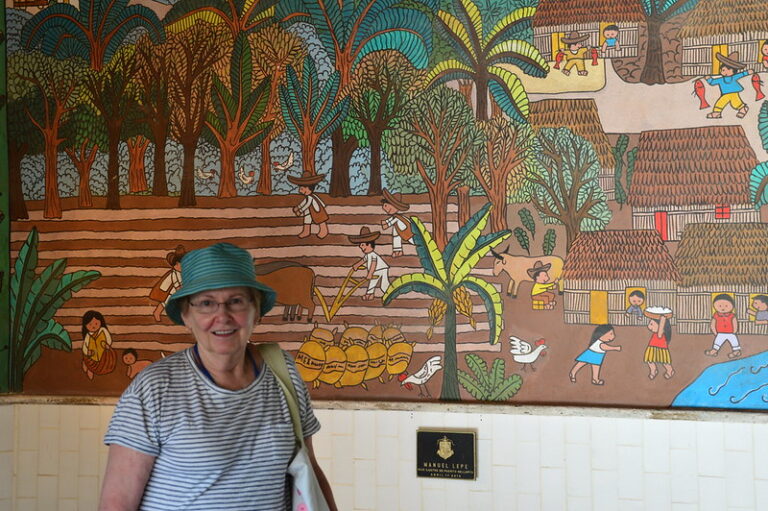
Is Mexico the Next Retirement Hotspot? A Comprehensive Analysis
Are you thinking of retiring in Mexico? The warm beaches, the food, and the variety of Magical Towns and cities that make it up are part of the attractions that thousands of retirees find in our country.
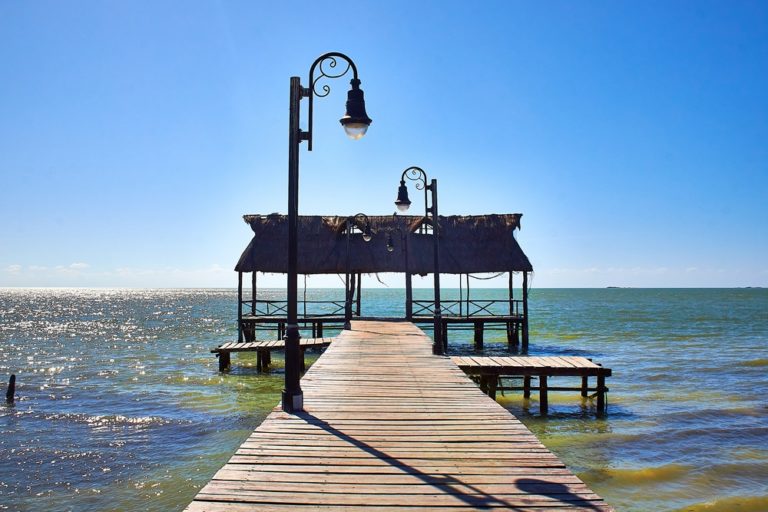
Island Magic: Isla Aguada Campeche’s Enchanting Attractions
I bet you haven’t heard of Isla Aguada Campeche, a heavenly little “island” in the heart of the beautiful Mexican Gulf. I will tell you about what activities you can do on your visit and a little bit of its history to learn more about this Magical Town and maybe encourage you to visit.
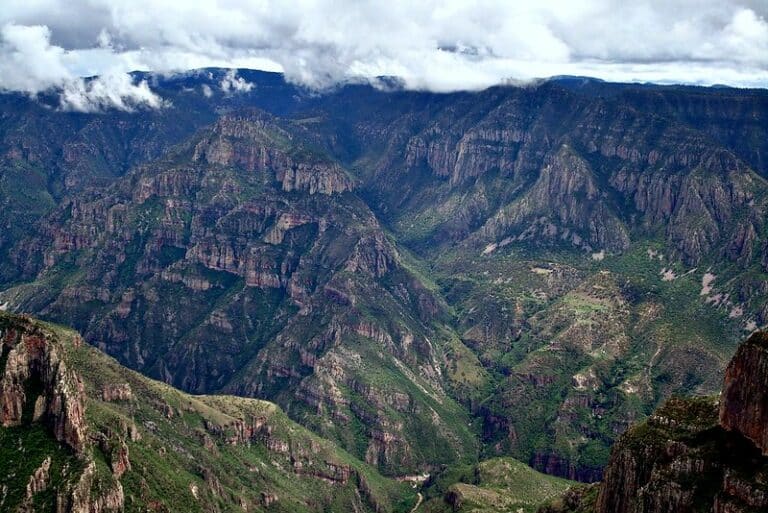
Discover Guachochi: Chihuahua’s New Magical Mountain Town
The new Magical Town of Guachochi is nestled among the Sierra Tarahumara in Mexico’s largest state: Chihuahua.
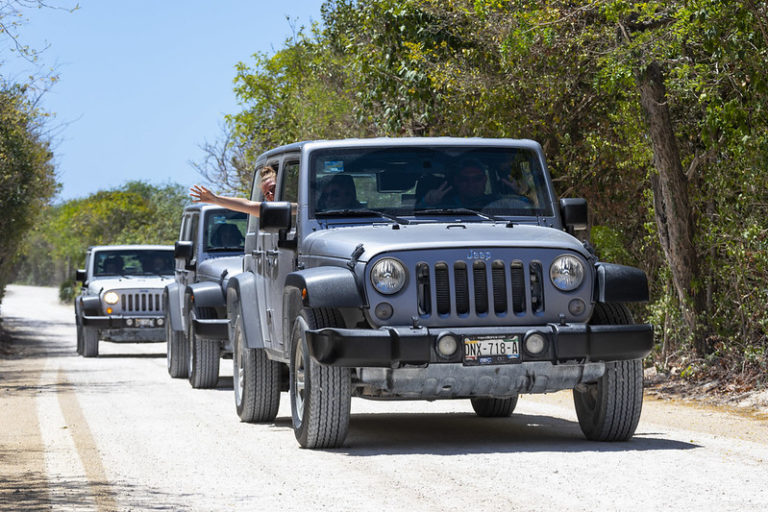
Vamonos! Mastering Car Rentals and Road Etiquette in Mexico
The purpose of this blog post is to provide valuable information to travelers considering renting a car in Mexico. Whether visiting for the first time or being a seasoned traveler, having a rental car…

Exploring El Fuerte, Sinaloa, ‘El Zorro’s’ Charming Hometown
The magical town of El Fuerte Sinaloa awaits you with its rich history and its cultural and natural attractions…
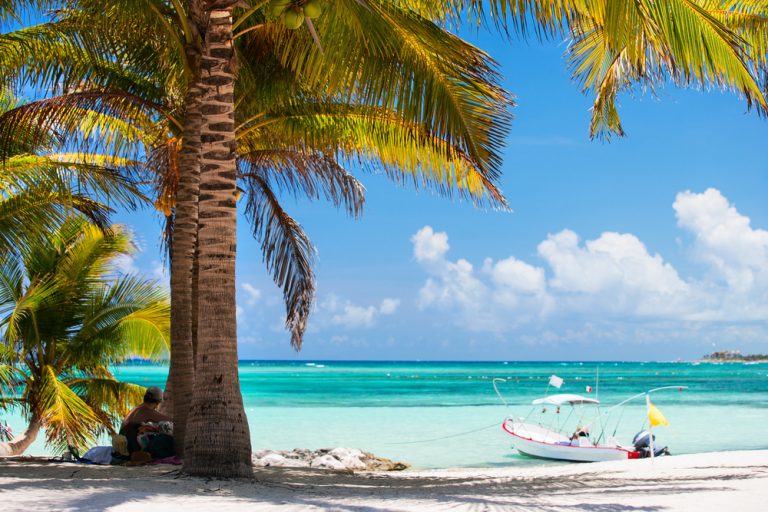
Akumal’s Perfect Vacation Combo: Cenotes, Beach, and Sun
A haven for turtles, Akumal Beach is a paradise in Mexico with a turquoise sea, clear and warm water.
Leave a Reply Cancel reply
Your email address will not be published. Required fields are marked *
Save my name, email, and website in this browser for the next time I comment.
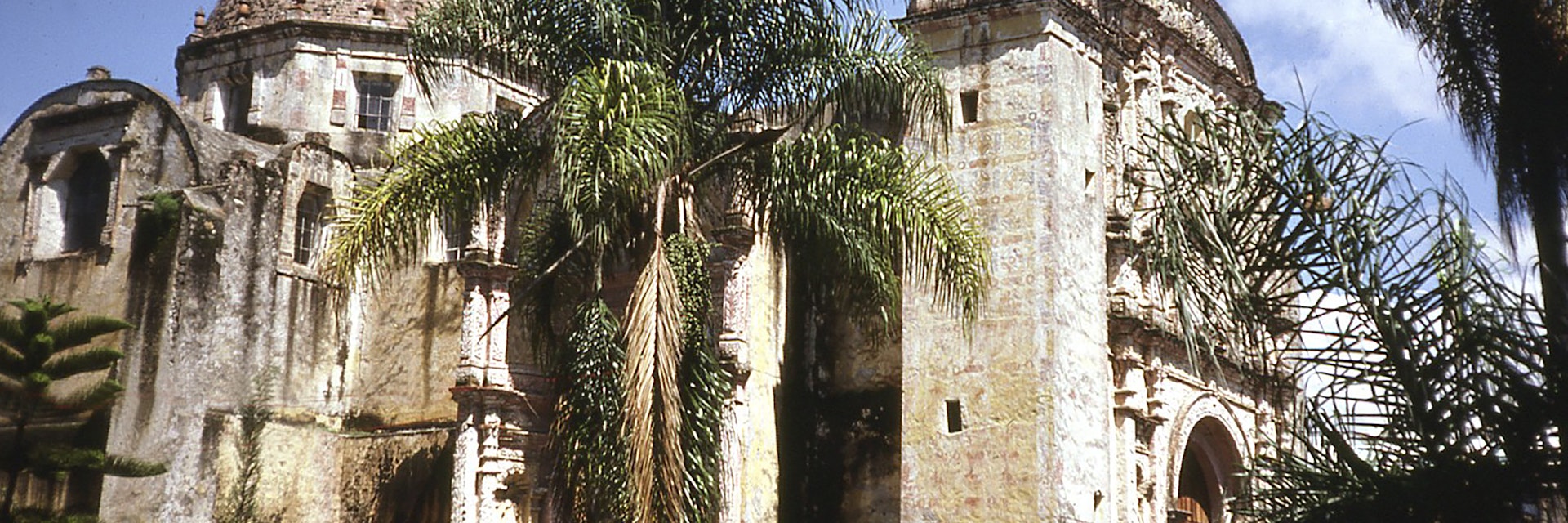
Getty Images/iStockphoto
There’s always been a formidable glamour surrounding Cuernavaca (kwehr-nah-vah-kah), the capital of Morelos state. With its vast, gated haciendas and sprawling estates, it has traditionally attracted high-society visitors year-round for its warmth, clean air and attractive architecture. Today this tradition continues, even though urban sprawl has put a decisive end to the clean air and you’re more likely to see vacationing North Americans and college students studying Spanish on monthlong courses than meet international royalty or great artists in the street.
Leave the planning to a local expert
Experience the real Cuernavaca. Let a local expert handle the planning for you.
Attractions
Must-see attractions.

Museo Robert Brady
Let’s face it, who wouldn’t want to be independently wealthy and spend their life traveling around the world collecting art for their lavish Mexican…

Catedral de Cuernavaca
Cuernavaca’s cathedral, Templo de la Asunción de María is plain and solid with an unembellished facade. It stands in a large high-walled recinto (compound…

Museo Juan Soriano
Opened in 2018, this contemporary art museum is comprised of off-white cubes squatting a few blocks west of the zócalo. Temporary exhibits have included…

Jardín Juárez
Adjoining the northwest corner of the Plaza de Armas is the Jardín Juárez, where the central gazebo (designed by tower specialist Gustave Eiffel) houses…

This bright and inviting museum showcases handicrafts from Morelos, including life-size chinelos (costumed dancers with upturned chins from Morelos). Most…

Museo Regional Cuauhnáhuac
The Palacio de Cortés houses this excellent museum, which has two floors of exhibits highlighting Mexican cultures and history. On the ground floor,…

Palacio de Cortés
Cortés’ imposing medieval-style fortress stands opposite the southeast end of the Plaza de Armas. This two-story stone palace was built in 1535 on the…

Jardín Borda
This extravagant property, inspired by Versailles (though with mere park-like results), features gardens formally laid out in a series of terraces with…
Plan with a local
Experience the real Mexico
Let a local expert craft your dream trip.
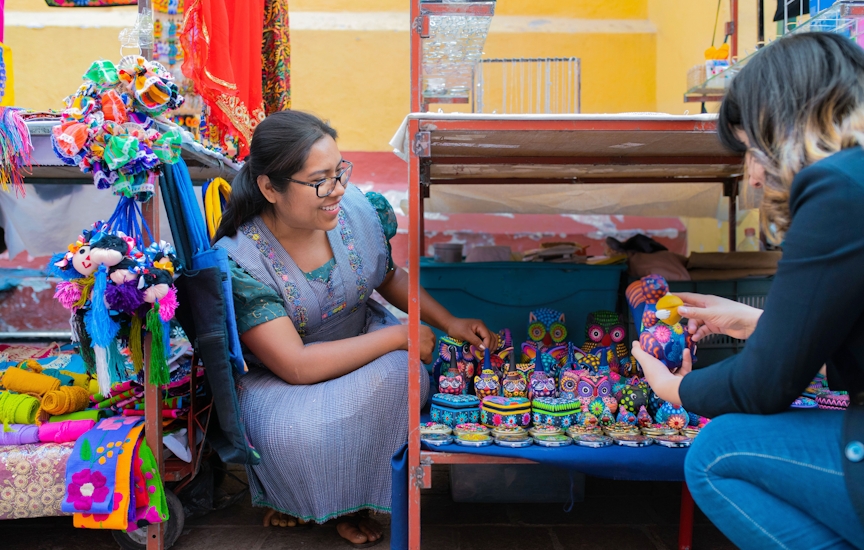
in partnership with getyourguide
Book popular activities in Cuernavaca
Purchase our award-winning guidebooks.
Get to the heart of Cuernavaca with one of our in-depth, award-winning guidebooks, covering maps, itineraries, and expert guidance.
You are using an outdated browser. Upgrade your browser today or install Google Chrome Frame to better experience this site.
Mexico Traveler View
Travel health notices, vaccines and medicines, non-vaccine-preventable diseases, stay healthy and safe.
- Packing List
After Your Trip

Be aware of current health issues in Mexico. Learn how to protect yourself.
Level 1 Practice Usual Precautions
- Dengue in the Americas April 18, 2024 Dengue is a risk in many parts of Central and South America, Mexico, and the Caribbean. Some countries are reporting increased numbers of cases of the disease. Travelers to the Americas can protect themselves by preventing mosquito bites. Destination List: Argentina, Brazil, Colombia, Costa Rica, Ecuador, including the Galápagos Islands, French Guiana (France), Guadeloupe, Guatemala, Martinique (France), Mexico, Nicaragua, Panama, Paraguay, Peru, Turks and Caicos Islands (U.K.), Uruguay
- Rocky Mountain Spotted Fever in Mexico March 12, 2024 There have been reports of Rocky Mountain spotted fever (RMSF) in people traveling to the United States from Tecate, in the state of Baja California, Mexico.
- Salmonella Newport in Mexico March 29, 2023 Some travelers who have spent time in Mexico have been infected with multidrug-resistant (MDR) Salmonella Newport.
⇧ Top
Check the vaccines and medicines list and visit your doctor at least a month before your trip to get vaccines or medicines you may need. If you or your doctor need help finding a location that provides certain vaccines or medicines, visit the Find a Clinic page.
Routine vaccines
Recommendations.
Make sure you are up-to-date on all routine vaccines before every trip. Some of these vaccines include
- Chickenpox (Varicella)
- Diphtheria-Tetanus-Pertussis
- Flu (influenza)
- Measles-Mumps-Rubella (MMR)
Immunization schedules
All eligible travelers should be up to date with their COVID-19 vaccines. Please see Your COVID-19 Vaccination for more information.
COVID-19 vaccine
Hepatitis A
Recommended for unvaccinated travelers one year old or older going to Mexico.
Infants 6 to 11 months old should also be vaccinated against Hepatitis A. The dose does not count toward the routine 2-dose series.
Travelers allergic to a vaccine component or who are younger than 6 months should receive a single dose of immune globulin, which provides effective protection for up to 2 months depending on dosage given.
Unvaccinated travelers who are over 40 years old, immunocompromised, or have chronic medical conditions planning to depart to a risk area in less than 2 weeks should get the initial dose of vaccine and at the same appointment receive immune globulin.
Hepatitis A - CDC Yellow Book
Dosing info - Hep A
Hepatitis B
Recommended for unvaccinated travelers younger than 60 years old traveling to Mexico. Unvaccinated travelers 60 years and older may get vaccinated before traveling to Mexico.
Hepatitis B - CDC Yellow Book
Dosing info - Hep B
CDC recommends that travelers going to certain areas of Mexico take prescription medicine to prevent malaria. Depending on the medicine you take, you will need to start taking this medicine multiple days before your trip, as well as during and after your trip. Talk to your doctor about which malaria medication you should take.
Find country-specific information about malaria.
Malaria - CDC Yellow Book
Considerations when choosing a drug for malaria prophylaxis (CDC Yellow Book)
Malaria information for Mexico.
Cases of measles are on the rise worldwide. Travelers are at risk of measles if they have not been fully vaccinated at least two weeks prior to departure, or have not had measles in the past, and travel internationally to areas where measles is spreading.
All international travelers should be fully vaccinated against measles with the measles-mumps-rubella (MMR) vaccine, including an early dose for infants 6–11 months, according to CDC’s measles vaccination recommendations for international travel .
Measles (Rubeola) - CDC Yellow Book
Rabid dogs are commonly found in Mexico. However, if you are bitten or scratched by a dog or other mammal while in Mexico, rabies treatment is often available.
Consider rabies vaccination before your trip if your activities mean you will be around dogs or wildlife.
Travelers more likely to encounter rabid animals include
- Campers, adventure travelers, or cave explorers (spelunkers)
- Veterinarians, animal handlers, field biologists, or laboratory workers handling animal specimens
- Visitors to rural areas
Since children are more likely to be bitten or scratched by a dog or other animals, consider rabies vaccination for children traveling to Mexico.
Rabies - CDC Yellow Book
Recommended for most travelers, especially those staying with friends or relatives or visiting smaller cities or rural areas.
Typhoid - CDC Yellow Book
Dosing info - Typhoid
Avoid contaminated water
Leptospirosis
How most people get sick (most common modes of transmission)
- Touching urine or other body fluids from an animal infected with leptospirosis
- Swimming or wading in urine-contaminated fresh water, or contact with urine-contaminated mud
- Drinking water or eating food contaminated with animal urine
- Avoid contaminated water and soil
Clinical Guidance
Avoid bug bites, chagas disease (american trypanosomiasis).
- Accidentally rub feces (poop) of the triatomine bug into the bug bite, other breaks in the skin, your eyes, or mouth
- From pregnant woman to her baby, contaminated blood products (transfusions), or contaminated food or drink.
- Avoid Bug Bites
Chagas disease
- Mosquito bite
Leishmaniasis
- Sand fly bite
- An infected pregnant woman can spread it to her unborn baby
Airborne & droplet
Avian/bird flu.
- Being around, touching, or working with infected poultry, such as visiting poultry farms or live-animal markets
- Avoid domestic and wild poultry
- Breathing in air or accidentally eating food contaminated with the urine, droppings, or saliva of infected rodents
- Bite from an infected rodent
- Less commonly, being around someone sick with hantavirus (only occurs with Andes virus)
- Avoid rodents and areas where they live
- Avoid sick people
Tuberculosis (TB)
- Breathe in TB bacteria that is in the air from an infected and contagious person coughing, speaking, or singing.
Learn actions you can take to stay healthy and safe on your trip. Vaccines cannot protect you from many diseases in Mexico, so your behaviors are important.
Eat and drink safely
Food and water standards around the world vary based on the destination. Standards may also differ within a country and risk may change depending on activity type (e.g., hiking versus business trip). You can learn more about safe food and drink choices when traveling by accessing the resources below.
- Choose Safe Food and Drinks When Traveling
- Water Treatment Options When Hiking, Camping or Traveling
- Global Water, Sanitation and Hygiene | Healthy Water
- Avoid Contaminated Water During Travel
You can also visit the Department of State Country Information Pages for additional information about food and water safety.
Prevent bug bites
Bugs (like mosquitoes, ticks, and fleas) can spread a number of diseases in Mexico. Many of these diseases cannot be prevented with a vaccine or medicine. You can reduce your risk by taking steps to prevent bug bites.
What can I do to prevent bug bites?
- Cover exposed skin by wearing long-sleeved shirts, long pants, and hats.
- Use an appropriate insect repellent (see below).
- Use permethrin-treated clothing and gear (such as boots, pants, socks, and tents). Do not use permethrin directly on skin.
- Stay and sleep in air-conditioned or screened rooms.
- Use a bed net if the area where you are sleeping is exposed to the outdoors.
What type of insect repellent should I use?
- FOR PROTECTION AGAINST TICKS AND MOSQUITOES: Use a repellent that contains 20% or more DEET for protection that lasts up to several hours.
- Picaridin (also known as KBR 3023, Bayrepel, and icaridin)
- Oil of lemon eucalyptus (OLE) or para-menthane-diol (PMD)
- 2-undecanone
- Always use insect repellent as directed.
What should I do if I am bitten by bugs?
- Avoid scratching bug bites, and apply hydrocortisone cream or calamine lotion to reduce the itching.
- Check your entire body for ticks after outdoor activity. Be sure to remove ticks properly.
What can I do to avoid bed bugs?
Although bed bugs do not carry disease, they are an annoyance. See our information page about avoiding bug bites for some easy tips to avoid them. For more information on bed bugs, see Bed Bugs .
For more detailed information on avoiding bug bites, see Avoid Bug Bites .
Some diseases in Mexico—such as dengue, Zika, leishmaniasis, and Chagas disease—are spread by bugs and cannot be prevented with a vaccine. Follow the insect avoidance measures described above to prevent these and other illnesses.
Stay safe outdoors
If your travel plans in Mexico include outdoor activities, take these steps to stay safe and healthy during your trip.
- Stay alert to changing weather conditions and adjust your plans if conditions become unsafe.
- Prepare for activities by wearing the right clothes and packing protective items, such as bug spray, sunscreen, and a basic first aid kit.
- Consider learning basic first aid and CPR before travel. Bring a travel health kit with items appropriate for your activities.
- If you are outside for many hours in heat, eat salty snacks and drink water to stay hydrated and replace salt lost through sweating.
- Protect yourself from UV radiation : use sunscreen with an SPF of at least 15, wear protective clothing, and seek shade during the hottest time of day (10 a.m.–4 p.m.).
- Be especially careful during summer months and at high elevation. Because sunlight reflects off snow, sand, and water, sun exposure may be increased during activities like skiing, swimming, and sailing.
- Very cold temperatures can be dangerous. Dress in layers and cover heads, hands, and feet properly if you are visiting a cold location.
Stay safe around water
- Swim only in designated swimming areas. Obey lifeguards and warning flags on beaches.
- Practice safe boating—follow all boating safety laws, do not drink alcohol if driving a boat, and always wear a life jacket.
- Do not dive into shallow water.
- Do not swim in freshwater in developing areas or where sanitation is poor.
- Avoid swallowing water when swimming. Untreated water can carry germs that make you sick.
- To prevent infections, wear shoes on beaches where there may be animal waste.
Leptospirosis, a bacterial infection that can be spread in fresh water, is found in Mexico. Avoid swimming in fresh, unchlorinated water, such as lakes, ponds, or rivers.
Keep away from animals
Most animals avoid people, but they may attack if they feel threatened, are protecting their young or territory, or if they are injured or ill. Animal bites and scratches can lead to serious diseases such as rabies.
Follow these tips to protect yourself:
- Do not touch or feed any animals you do not know.
- Do not allow animals to lick open wounds, and do not get animal saliva in your eyes or mouth.
- Avoid rodents and their urine and feces.
- Traveling pets should be supervised closely and not allowed to come in contact with local animals.
- If you wake in a room with a bat, seek medical care immediately. Bat bites may be hard to see.
All animals can pose a threat, but be extra careful around dogs, bats, monkeys, sea animals such as jellyfish, and snakes. If you are bitten or scratched by an animal, immediately:
- Wash the wound with soap and clean water.
- Go to a doctor right away.
- Tell your doctor about your injury when you get back to the United States.
Consider buying medical evacuation insurance. Rabies is a deadly disease that must be treated quickly, and treatment may not be available in some countries.
Reduce your exposure to germs
Follow these tips to avoid getting sick or spreading illness to others while traveling:
- Wash your hands often, especially before eating.
- If soap and water aren’t available, clean hands with hand sanitizer (containing at least 60% alcohol).
- Don’t touch your eyes, nose, or mouth. If you need to touch your face, make sure your hands are clean.
- Cover your mouth and nose with a tissue or your sleeve (not your hands) when coughing or sneezing.
- Try to avoid contact with people who are sick.
- If you are sick, stay home or in your hotel room, unless you need medical care.
Avoid sharing body fluids
Diseases can be spread through body fluids, such as saliva, blood, vomit, and semen.
Protect yourself:
- Use latex condoms correctly.
- Do not inject drugs.
- Limit alcohol consumption. People take more risks when intoxicated.
- Do not share needles or any devices that can break the skin. That includes needles for tattoos, piercings, and acupuncture.
- If you receive medical or dental care, make sure the equipment is disinfected or sanitized.
Know how to get medical care while traveling
Plan for how you will get health care during your trip, should the need arise:
- Carry a list of local doctors and hospitals at your destination.
- Review your health insurance plan to determine what medical services it would cover during your trip. Consider purchasing travel health and medical evacuation insurance.
- Carry a card that identifies, in the local language, your blood type, chronic conditions or serious allergies, and the generic names of any medications you take.
- Some prescription drugs may be illegal in other countries. Call Mexico’s embassy to verify that all of your prescription(s) are legal to bring with you.
- Bring all the medicines (including over-the-counter medicines) you think you might need during your trip, including extra in case of travel delays. Ask your doctor to help you get prescriptions filled early if you need to.
Many foreign hospitals and clinics are accredited by the Joint Commission International. A list of accredited facilities is available at their website ( www.jointcommissioninternational.org ).
In some countries, medicine (prescription and over-the-counter) may be substandard or counterfeit. Bring the medicines you will need from the United States to avoid having to buy them at your destination.
Malaria is a risk in some parts of Mexico. If you are going to a risk area, fill your malaria prescription before you leave, and take enough with you for the entire length of your trip. Follow your doctor’s instructions for taking the pills; some need to be started before you leave.
Select safe transportation
Motor vehicle crashes are the #1 killer of healthy US citizens in foreign countries.
In many places cars, buses, large trucks, rickshaws, bikes, people on foot, and even animals share the same lanes of traffic, increasing the risk for crashes.
Be smart when you are traveling on foot.
- Use sidewalks and marked crosswalks.
- Pay attention to the traffic around you, especially in crowded areas.
- Remember, people on foot do not always have the right of way in other countries.
Riding/Driving
Choose a safe vehicle.
- Choose official taxis or public transportation, such as trains and buses.
- Ride only in cars that have seatbelts.
- Avoid overcrowded, overloaded, top-heavy buses and minivans.
- Avoid riding on motorcycles or motorbikes, especially motorbike taxis. (Many crashes are caused by inexperienced motorbike drivers.)
- Choose newer vehicles—they may have more safety features, such as airbags, and be more reliable.
- Choose larger vehicles, which may provide more protection in crashes.
Think about the driver.
- Do not drive after drinking alcohol or ride with someone who has been drinking.
- Consider hiring a licensed, trained driver familiar with the area.
- Arrange payment before departing.
Follow basic safety tips.
- Wear a seatbelt at all times.
- Sit in the back seat of cars and taxis.
- When on motorbikes or bicycles, always wear a helmet. (Bring a helmet from home, if needed.)
- Avoid driving at night; street lighting in certain parts of Mexico may be poor.
- Do not use a cell phone or text while driving (illegal in many countries).
- Travel during daylight hours only, especially in rural areas.
- If you choose to drive a vehicle in Mexico, learn the local traffic laws and have the proper paperwork.
- Get any driving permits and insurance you may need. Get an International Driving Permit (IDP). Carry the IDP and a US-issued driver's license at all times.
- Check with your auto insurance policy's international coverage, and get more coverage if needed. Make sure you have liability insurance.
- Avoid using local, unscheduled aircraft.
- If possible, fly on larger planes (more than 30 seats); larger airplanes are more likely to have regular safety inspections.
- Try to schedule flights during daylight hours and in good weather.
Medical Evacuation Insurance
If you are seriously injured, emergency care may not be available or may not meet US standards. Trauma care centers are uncommon outside urban areas. Having medical evacuation insurance can be helpful for these reasons.
Helpful Resources
Road Safety Overseas (Information from the US Department of State): Includes tips on driving in other countries, International Driving Permits, auto insurance, and other resources.
The Association for International Road Travel has country-specific Road Travel Reports available for most countries for a minimal fee.
For information traffic safety and road conditions in Mexico, see Travel and Transportation on US Department of State's country-specific information for Mexico .
Maintain personal security
Use the same common sense traveling overseas that you would at home, and always stay alert and aware of your surroundings.
Before you leave
- Research your destination(s), including local laws, customs, and culture.
- Monitor travel advisories and alerts and read travel tips from the US Department of State.
- Enroll in the Smart Traveler Enrollment Program (STEP) .
- Leave a copy of your itinerary, contact information, credit cards, and passport with someone at home.
- Pack as light as possible, and leave at home any item you could not replace.
While at your destination(s)
- Carry contact information for the nearest US embassy or consulate .
- Carry a photocopy of your passport and entry stamp; leave the actual passport securely in your hotel.
- Follow all local laws and social customs.
- Do not wear expensive clothing or jewelry.
- Always keep hotel doors locked, and store valuables in secure areas.
- If possible, choose hotel rooms between the 2nd and 6th floors.
To call for emergency services while in Mexico, dial 066, 060, or 080. Write these numbers down to carry with you during your trip.
Learn as much as you can about Mexico before you travel there. A good place to start is the country-specific information on Mexico from the US Department of State.
Americans in Mexico have been arrested for purchasing souvenirs that were, or looked like, antiques and that local customs authorities believed were national treasures. Familiarize yourself with any local regulations for antiques and follow these tips:
- When you are considering purchasing an authentic antique or a reproduction, ask if you are allowed to export these items before you purchase them.
- If you buy a reproduction, document on the customs form that it is a reproduction.
- If you buy an authentic antique, obtain the necessary export permit (often from the national museum).
Healthy Travel Packing List
Use the Healthy Travel Packing List for Mexico for a list of health-related items to consider packing for your trip. Talk to your doctor about which items are most important for you.
Why does CDC recommend packing these health-related items?
It’s best to be prepared to prevent and treat common illnesses and injuries. Some supplies and medicines may be difficult to find at your destination, may have different names, or may have different ingredients than what you normally use.
If you are not feeling well after your trip, you may need to see a doctor. If you need help finding a travel medicine specialist, see Find a Clinic . Be sure to tell your doctor about your travel, including where you went and what you did on your trip. Also tell your doctor if you were bitten or scratched by an animal while traveling.
If your doctor prescribed antimalarial medicine for your trip, keep taking the rest of your pills after you return home. If you stop taking your medicine too soon, you could still get sick.
Malaria is always a serious disease and may be a deadly illness. If you become ill with a fever either while traveling in a malaria-risk area or after you return home (for up to 1 year), you should seek immediate medical attention and should tell the doctor about your travel history.
For more information on what to do if you are sick after your trip, see Getting Sick after Travel .
Map Disclaimer - The boundaries and names shown and the designations used on maps do not imply the expression of any opinion whatsoever on the part of the Centers for Disease Control and Prevention concerning the legal status of any country, territory, city or area or of its authorities, or concerning the delimitation of its frontiers or boundaries. Approximate border lines for which there may not yet be full agreement are generally marked.
Other Destinations
If you need help finding travel information:
Message & data rates may apply. CDC Privacy Policy

File Formats Help:
- Adobe PDF file
- Microsoft PowerPoint file
- Microsoft Word file
- Microsoft Excel file
- Audio/Video file
- Apple Quicktime file
- RealPlayer file
- Zip Archive file
Exit Notification / Disclaimer Policy
- The Centers for Disease Control and Prevention (CDC) cannot attest to the accuracy of a non-federal website.
- Linking to a non-federal website does not constitute an endorsement by CDC or any of its employees of the sponsors or the information and products presented on the website.
- You will be subject to the destination website's privacy policy when you follow the link.
- CDC is not responsible for Section 508 compliance (accessibility) on other federal or private website.

A Guide to Cuernavaca: The City of Eternal Spring
Last Updated on: 7th December 2023, 11:04 am
Spanish conquistador Hernán Cortés chose Cuernavaca as his base of operations, partly due to its central location. But, like the Aztec rulers before him, he surely enjoyed its mild year-round climate. And up until fairly recently, ‘The City of Eternal Spring’ was considered the place to be for high-society Mexicans and expats alike. In the following Cuernavaca guide, we’ll be covering the top things to do in the city as well as nearby Tepoztlán.
Cuernavaca, the capital of the state of Morelos, is about a 60-90-minute drive from Mexico City. As such, it makes for a convenient day trip from the capital. While Cuernavaca’s highlights could potentially be seen in a single day, consider staying for at least several.
In addition to the attractions – both modern and ancient – featured in the Cuernavaca guide below, the city makes for an excellent base for day trips. The ruins of Xochicalco and Chalcatzingo , as well as the Magic Town of Taxco , are all within easy reach.
To learn more about how to reach Cuernavaca and where to stay, be sure to check the end of the article .

Cuernavaca Guide Contents
Palacio de cortés, the robert brady museum, cuernavaca cathedral.
- Cementerio General
More Cuernavaca Museums
The ruins of teopanzolco.
- Accommodation & Transport Info
The most historically important building in this Cuernavaca guide is easily the Palacio de Cortés. Built in 1526, it happens to be the oldest standing colonial building in all of the Americas!
As the name suggests, the building was the former residence of Hernán Cortés upon his conquest of the Aztec Empire. As with many important colonial structures, the palace’s location was deliberate, having been built over the former tribute center of local Aztec (and prior to that, Tlahuican) leaders.

As you’ll notice, it more closely resembles a fort than it does a palace, as the defeat of the Aztec Empire did not guarantee an era of peace and calm. Many groups throughout Mesoamerica still wanted to drive the Spanish out, and Cortés was under constant threat.
More recently, the palace served as the local government headquarters before being converted to a museum in the 1970s. Unfortunately, it had already been closed for years for renovations at the time of my visit, but it appears to have reopened in 2023.
If you’re visiting the city as a day trip and only have time for a few locations in this Cuernavaca guide, put the Robert Brady Museum at the top of your itinerary.
Admittedly, I’d never heard of Robert Brady before visiting Cuernavaca, but his former residence turned out to be my favorite place in the city.

Born in Iowa, USA in 1928, Brady grew up in an artistic family and eventually majored in art in university. Not long after, he began traveling the world, gradually building a personal collection of interesting objects.
In between travel to far-flung corners of the globe, he made Venice, Italy his base. But upon the suggestion of his friend Peggy Guggenheim, he traveled to Central Mexico, ultimately falling in love with the city of Cuernavaca.
Buying an abandoned 16th-century monastery, he refurbished it and made it his new home.

Though he lived here during his life, he envisioned the public being able to enjoy his collection after his death. And so in his will, he granted his house and art collection to the municipal government so it could be turned into a public museum.
If you’ve already been to Valladolid , Yucatán, the Robert Brady Museum looks and feels similar to the Casa de los Venados. The difference here, however, is that the art comes from all over the world and not just Mexico.

As you’ll soon realize, this certainly isn’t an anthropology museum. Folk art from far corners of the world are often placed in the same room together with contemporary paintings. Apparently, Brady arranged his collection based on aesthetics alone.
In some of the earlier rooms, you will indeed find a large assortment of Mexican art, such as masks and dolls from Guerrero and cardboard dolls from Guanajuato. Brady also collected a sizable amount of pre-Hispanic art from places like Veracruz.
But you’ll find them interspersed with masks from Ghana and Peru, along with numerous figurines from South Asia and other far-away lands.

Clearly, Brady was incredibly well-traveled – especially for his era. And if you’re also a dedicated traveler, it can be fun to scan each room with your eyes, guessing where certain pieces are from.
While you won’t find any labels on the walls, laminated sheets will tell you the origin of each object if you’re stumped.

The house is teeming with color – even the kitchen and bathrooms. One room, however, which seems to be dedicated to colonial Catholic art, could be called somewhat minimalist compared to the rest.

Among the most beautiful rooms at the Robert Brady Museum is the so-called Yellow Room, which functioned as a living room.
In addition to pieces from Mexico, India and indigenous folk art from Canada, the room features numerous contemporary paintings.
Among them is the original copy of ‘Self-Portrait with Monkey’ by Frida Kahlo and Robert Brady’s own portrait of Peggy Guggenheim, along with several other Brady originals.

While, as mentioned, most of the collection is quite random when considering each piece’s origin, the upper floor contains an ‘Oriental Room’ focusing on Asia. Among the works on display here are paintings from Rajasthan and Japan and various sculptures from Southeast Asia.
The collection includes a 17th-century bronze standing Buddha made in the Ayutthaya style. Thai visitors would shudder, however, to see that Brady chose the bathroom, of all places, to display it!

As with every other colonial city in Latin America, one of Cuernavaca’s most important pieces of architecture is its central cathedral. Constructed in the 16th century, it was built to evangelize the local indigenous population shortly after the Spanish conquest of Mexico.
Uniquely, unlike most other churches from the era, it doesn’t face the city’s central square but is tucked away in its own complex.

Stepping inside, over to your right is the ornate Tercera Orden Chapel. It was constructed in 1772 in the Churrigueresque, or ‘Ultra Baroque’ style. Notably, some of the sculptures of saints on the facade wear indigenous headdresses.

Before stepping inside the main church, you’ll notice an open chapel over to the right, believed to date back to the time of Hernán Cortés. Its open format made it an ideal place for the conversion of the local natives.
Construction of the main church began in 1529 and it was largely finished decades later. But continuous renovations and remodelings would take place over the next few centuries.

Despite all the renovations, the church maintains plenty of original frescoes. Among them are the 17th-century murals depicting the 26 Martyrs of Japan, a group of Catholic missionaries who were executed in Nagasaki in 1597.
Other highlights include a stone baptismal font and the large cross hanging over the main altar.
During your visit, also be sure to check out the Museum of Religious Art for a small fee, accessed via the open chapel mentioned above.

Items on display here, most of which relate to the Catholic liturgy, date back as early as the 17th century. One particularly notable piece, however, is a salvaged statue of Tonantzin, the local fertility goddess in pre-Hispanic times. Amazingly, it was discovered beneath the main altar during renovations.
Other sections of the small museum, meanwhile, are dedicated to St. Francis of Assisi and the efforts to evangelize Mexico in colonial times. The collection includes a myriad of both paintings and sculptures.

In addition to the Robert Brady Museum and Cuernavaca Cathedral’s Museum of Religious Art, the city is home to several additional museums to check out if you have the time.
The Folk Art Museum
The local Folk Art Museum is arguably the best of Cuernavaca’s minor museums. Dedicated to traditional art from throughout the state of Morelos, the small museum is home to a nice collection of colorful and eye-catching sculptures and costumes.

Jardín Borda
Often touted as one of the top things to do in Cuernavaca, Jardín Borda doesn’t quite live up to the hype. In the 18th century, the property once belonged to José de la Borda, a silver magnate from nearby Taxco.
Later in 1778, his son Manuel inherited the land and commissioned a large botanical garden. The space would later be occupied by Maximilian, the Austrian archduke who briefly ruled Mexico in the 1860s.

Exploring the gardens today, the fountains are largely dry with many of the plants having seen better days. You will, at least, have access to a museum featuring the history of the site as well as some modern art exhibits.
The location is quite central, making it easy to squeeze in between visits to other locations in this Cuernavaca guide.
Centro Cultural Juan Soriano
The city’s premier contemporary art museum was mostly off-limits during my visit. I was, however, allowed to tour the gardens which are home to a collection of large bronze sculptures.
The sculptures were created by Juan Soriano (1920-2006) himself, a well-known Mexican sculptor and painter, and many of them depict birds.

While Cuernavaca makes for a great base for visiting numerous archaeological sites (such as Xochimilco and Chalcatzingo), the bustling city happens to be home to some ruins of its own.
Formerly known as El Mogote, the site was established by the Tlahuica people in the 13th century before being absorbed into the Aztec Empire in 1427.

The ruins may be small and relatively unimpressive compared with many other sites around Central Mexico. But there’s a noteworthy architectural feature that pre-Hispanic archaeology enthusiasts will surely find interesting.
The well-preserved main temple closely resembles how Templo Mayor, the prominent temple of the Aztec Empire, would’ve looked before its destruction.

The same two deities were worshipped here as well: Tlaloc, the Mesoamerican rain deity, and Huitzilopochtli, the god of war who was also worshipped as the Aztec patron deity.
Thinking I was alone at these relatively unknown ruins, I did encounter one other visitor. It was a (presumably) local woman who was performing some type of extravagant dance routine or ritual in front of the pyramid.
Was she perhaps in her own way trying to keep the religion of her ancestors alive?

I waited, and waited, and twenty minutes or so later I was finally able to capture an unobstructed shot of the pyramid. Notably, it was built in two separate phases.
The second phase seems to have been an attempt at enlarging the temple, though construction was halted upon the arrival of the Spanish.

Elsewhere around the complex, one can encounter temples to Tezcatlipoca, the god of fire and the dead, and to Ehecatl, the wind deity who’s better known today as Quetzalcoatl.
Despite its small size and relative obscurity, I was surprised to see them charging $85 MXN at the entrance. But perhaps this was to offset of the cost of extensive renovations that were taking place from 2017-2022.
Teopanzolco is indeed located in the center of an urban area, and it was a bit odd to explore the site as a fashion event was happening next door at a venue overlooking the ruins!
Tepoztlán is one of the most popular Pueblo Mágicos in Morelos and Central Mexico as a whole. Not only is the area considered to be the mythological birthplace of Quetzalcoatl, but Tepoztlán is also home to frequent UFO sightings.
But as fascinating as all that sounds, and in spite of its beautiful natural surroundings, I found Tepoztlán to be underwhelming and quite boring overall.

Tepoztlán’s main attraction is the archaeological site of El Tepozteco, which consists of a pyramid built atop a small mountain. I first learned about it when researching for my trip to Central Mexico in 2017, though it got damaged by the devastating earthquake which struck just before my arrival.
Visiting five years later, I was disappointed to find it still closed as a result of the same natural disaster.

As for what else there is to do around Tepoztlán, the answer is not a whole lot. A couple of museums I’d researched prior to my visit, such as the Collection of Carlos Pellicer, was closed as well.
The only open attraction, it seemed, was the Templo y Ex Convento de la Natividad, a former 16th-century monastery.

The monastery was constructed by local Tepoztecos upon the orders of Dominican friars between 1555 and 1580.
Now abandoned, the building functions as a museum. Visitors are free to explore the halls and admire their well-preserved frescoes. The monastery should be of special interest to those with an interest in early colonial history.

After your visit, you can wander the streets of the colorful town at eat to the local mercado, where many vendors specialize in pre-Hispanic cuisine. Tepoztlán is also renowned for its local ice cream, and you’ll encounter shops on nearly every block. I can confirm that it is indeed delicious.
GETTING THERE: The easiest way to reach Tepoztlán from Cuernavaca would be to catch a bus from the main market. Run by the Estrella Roja company, buses depart every thirty minutes or so. The Pullman de Morelos company also run buses to Tepoztlán, though seemingly not as frequently.
If the pyramid is still closed during your visit, I would recommend the town of Malinalco as an alternative to Tepoztlán, as it has a very similar look and feel but with a lot more going on.
Malinalco too has a hilltop archaeological site which is actually open, while the nearby town of Chalma is home to a fascinating pilgrimage spot.
But while Malinalco is relatively close to Cuernavaca, it’s actually easier to visit from Mexico City, with direct buses to Chalma departing every half an hour or so from Terminal Poniente.
Additional Info
Cuernavaca is a fairly well-connected city, and it can be reached by bus from numerous other cities and towns within Central Mexico.
From Mexico City, it can be reached from Terminal de Autobuses del Sur. And in the south of the city, the Pullman de Morelos company offers transport from their small station near Hotel Royal Pedregal. The same company also provides direct transport from the airport.
Coming from Acapulco, you can take the Estrella Roja company or Alta Mar.
And if you’d like to travel in between Cuernavaca and Puebla without having to transfer in Mexico City, the Autobuses ORO company is the only one with direct routes between the two. Their station in Cuernavaca is quite a distance from the center, so you’ll need to take an Uber or taxi there.
Speaking of bus stations, I’ve never seen so many bus stations in a single city as I have in Cuernavaca! It’s normal, of course, for smaller second-class bus companies in Mexico to run their own stations. But in Cuernavaca, I counted at least eight different bus stations, and there still might be more I haven’t discovered!
The locations of all these bus stations become a factor when choosing accommodation, as Cuernavaca makes for a great base for day trips (see more below).
Cuernavaca, home to roughly 350,000 people, is a mid-sized city. As long as you’re staying somewhere relatively central, most of the locations in the Cuernavaca guide above should be walkable.
Also as mentioned above, the city is home to a plethora of different bus stations, and you’ll often be using a different one during each of your day trips, not to mention arrival and departure.
I stayed just off of Avenida Morelos, where a few of the stations happen to be located. The hotel was called Hotel Colonial and it suited my needs perfectly. In addition to the convenient location, I had a comfortable room with a private bathroom. The hotel is also home to a very friendly (but very vocal!) cat.
Other highly-rated options in the city include Mesón de las Delicias , Hotel Casa Colonial , and for budget stays, Home Sweet Home .
If you’re short on time or simply don’t want to deal with the hassle of using public transport, consider taking a guided tour from Mexico City like this one that takes you to the highlights of Cuernavaca as well as the nearby Magic Town of Taxco.
- Cuernavaca Tourism
- Cuernavaca Hotels
- Cuernavaca Guest House
- Cuernavaca Holiday Homes
- Cuernavaca Flights
- Cuernavaca Restaurants
- Cuernavaca Attractions
- Cuernavaca Travel Forum
- Cuernavaca Photos
- Cuernavaca Map
- All Cuernavaca Hotels
- Cuernavaca Hotel Deals
- Last Minute Hotels in Cuernavaca
- Things to Do
- Restaurants
- Holiday homes
- Travel Stories
- Add a Place
- Travel Forum
- Travellers' Choice
- Help Centre
Is it safe for Americans to travel to Cuernavaca - Cuernavaca Forum
- Mexico
- Central Mexico and Gulf Coast
- Morelos
- Cuernavaca
Is it safe for Americans to travel to Cuernavaca
- India Forums
- United States Forums
- Europe Forums
- Canada Forums
- Asia Forums
- Central America Forums
- Africa Forums
- Caribbean Forums
- Mexico Forums
- South Pacific Forums
- South America Forums
- Middle East Forums
- Honeymoons and Romance
- Business Travel
- Train Travel
- Traveling With Disabilities
- Tripadvisor Support
- Solo Travel
- Bargain Travel
- Timeshares / Holiday Rentals
- Morelos forums
- Cuernavaca forum

Thank you both for the advice. We have decided to go ahead with the trip as I continue to only hear that Cuernavaca is a safe and wonderful place to visit. Thank you for the recommendations, we will add them to our itinerary.
Nice! Have a great trip and please come back and let us know hot it went.
Wonderful. Don't forget to stop by Helado Santa Clara (a regional Mexican ice cream chain) while in Cuernavaca. There's no sense in traveling all that distance and skipping the helado. Have a great time.
I have been to CN 4 times in the last approx 2 years.
It is a great city and I am always cautious and aware but used local transportation taxis local buses (the ruta) went to the mercado etc.
I would be aware of your surroundings not be out to late, use taxis at night and
CN will be a great experience.
I am going back soon to attend a language school again.
This post was determined to be inappropriate by the Tripadvisor community and has been removed.
why wouldnt you ask the mexican side of the family?

I just came back from two weeks in Cuernavaca and felt very comfortable and safe the whole time. I walked from the school I was studying at to my hotel every afternoon (3 miles) with no problems. As in any large city, you want to stay out of the bad parts and not walk alone at night.

I have been to Cuernavaca three times, including a semester I spent studying abroad there, but since the last time I went was in the summer of 2008 I cannot speak directly to the current security situation. However, I can recommend some great places for you to see during your trip. While in Cuernavaca I recommend visiting the Palacio de Cortes, the Jardin Borda, and agree with the other poster that Xochicalco is amazing if you get the chance to go. One thing that really encourages me about the safety of your travel there is that you are going to be with family members who are Mexican. This gives you a significant advantage because they have local insight to give you that a solo tourist would not have. I agree that you should not walk around alone too much at night and try to take radio taxis at night if possible. Cuernavaca is a great city and is practically a language school mecca for those studying Spanish as a second language, so it's not as if you are going somewhere completely off the beaten path for foreigners. Have a great trip!
- Driver from CDMX to Cuernavaca 17 April 2023
- Cuernavaca a no-go? 30 March 2023
- Private transport from Benito Juarez Airport to Cuernavaca 03 March 2023
- Bus terminal from Cuernavaca to San Juan del Rio, Queretaro? 01 March 2023
- PCR test in Cuernavaca 12 January 2023
- Mother/Daughter Trip to Cuernavaca - is is Safe? 01 January 2023
- Bus: Mexico City to Cuernavaca and return 13 November 2022
- Location to stay at 11 August 2022
- Time of travel from MEX airport to Cuernavaca 06 June 2022
- Pullman bus to airport 15 April 2022
- Traveling from Cuernavaca to Mexico City at night by bus 31 March 2022
- Questions about Cuernavaca weather for living year-round... 27 March 2022
- Cuernavaca Neighborhoods? 24 March 2022
- private driver from Taxco to Mexico city with stop in Cuerna 01 January 2022
- Bus from Cuernavaca to Tepoztlan 4 replies
- Cuernavaca to San Miguel de Allende 10 replies
- Help selecting a language school 9 replies
- charity work in mexico Cuernavaca with IVHQ 10 replies
- Travel from Cuernavaca to Oaxaca 4 replies
- Safety and Travel in Cuernavaca Mexico 61 replies
- Car Rental 5 replies
- Cuernavaca in August 2 replies
- toilet etiquette? 9 replies
- cuernavaca language schools 2 replies
Cuernavaca Hotels and Places to Stay
Is Cuernavaca Safe for Solo Female Travelers?
Safety rating.
Based on our research and crime data
Meet new people
Get the travel ladies app to meet new people , find travel buddies , share solo travel experiences and stay with locals through couch surfing ..

Safety index

Safety at night: Unsafe

Public transportation: Moderate

Street harassment: Moderate

Petty crimes: Moderate

Tap water: Unsafe
Is cuernavaca safe to travel.

Rachel (57)
United States
Solo travel experience
Cuernavaca is easy to get to from the CDMX airport or the Terminal de Sur Taxqueña. Take the Pullman de Morelos direct bus right into town. Cuernavaca has Uber so I used that to get around. My primary reason for visiting here was to learn cumbia dancing at the Academia de Baile Calor Latino, which I found on YouTube believe it or not. This was truly a great experience, the owner has created a welcoming and fun place to spend time and really learn Latin dancing. So I spent my time dancing, and wandering around the main square trying restaurants, practicing Spanish, and people watching. I felt safe in the parts of town I frecuented. I took Uber to the Unesco world heritage site Xochicalco ruins. There was no cell service so I had to figure out the buses back. The bus drivers were very helpful and made sure I made the right connections. I plan to go back later this year to dance again and explore other areas. Feel free to contact me if you want to chat.
Is Cuernavaca safe for women?
Is cuernavaca safe right now, canada's travel advisory exercise a high degree of caution, australia's travel advisory exercise a high degree of caution, meet locals in cuernavaca.

Hi! I am Sara, I come from Canadian and Mexican parents. I am a musician, I play the violin and I almost finish my career!!! I want to travel with my instrument and share making music with others. I would love to meet people from around the world and I’ll try to be the best host you ever have. I love parting and going out, you will never get bored in my house. You are welcome ☺️
Stay with locals in Cuernavaca
Can host for:, safety in mexico.
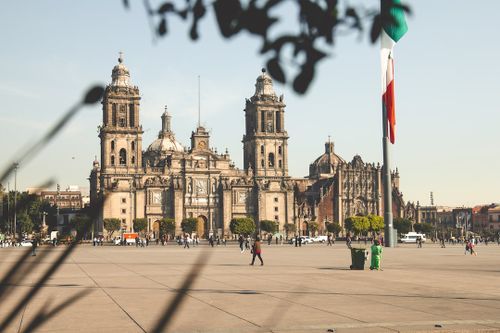
Mexico City
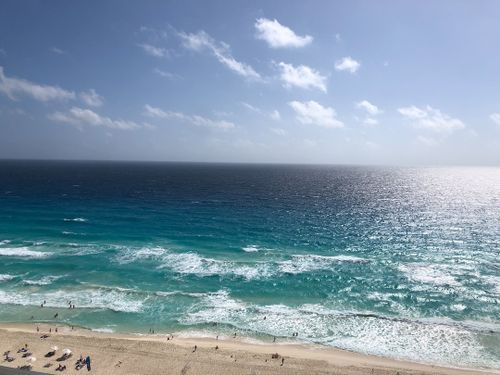
Playa del Carmen
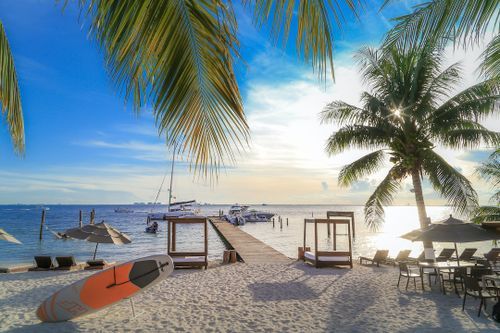
Isla Mujeres
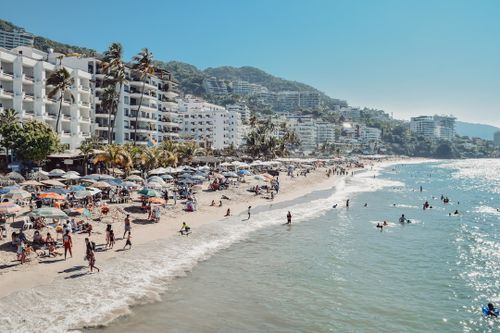
Puerto Vallarta
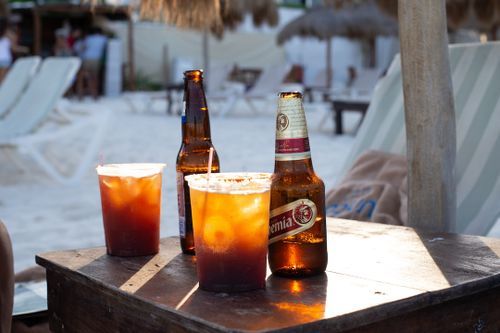
Puerto Morelos
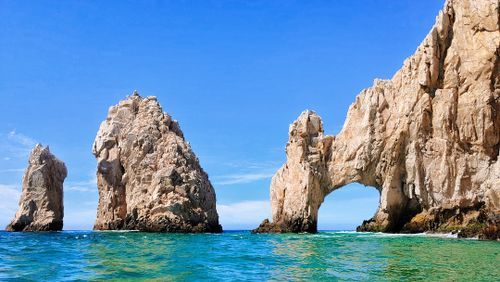
Cabo San Lucas
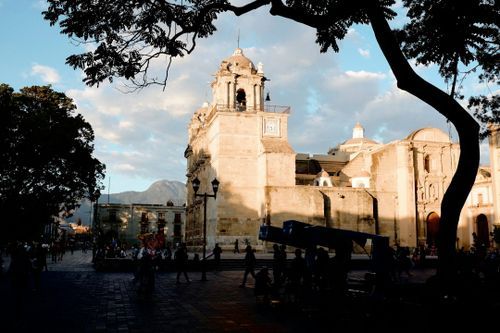
Oaxaca City
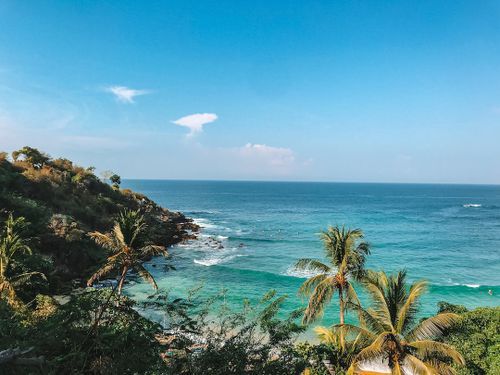
Puerto Escondido
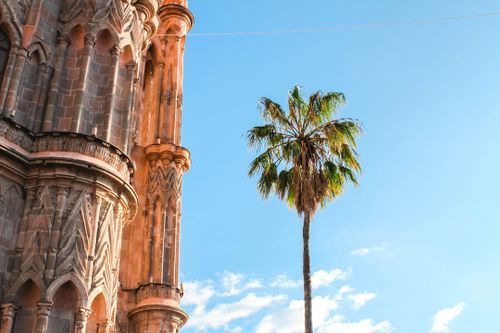
San Miguel de Allende
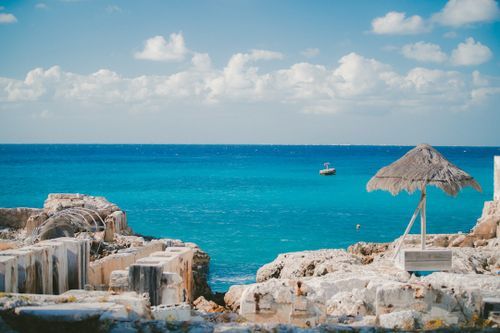
Quintana Roo
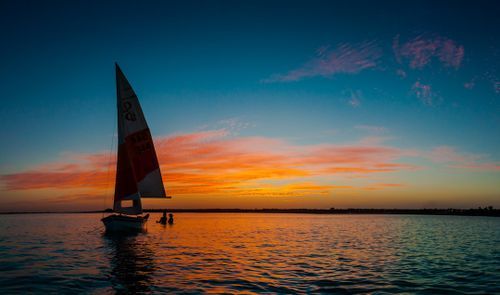
San Jose del Cabo
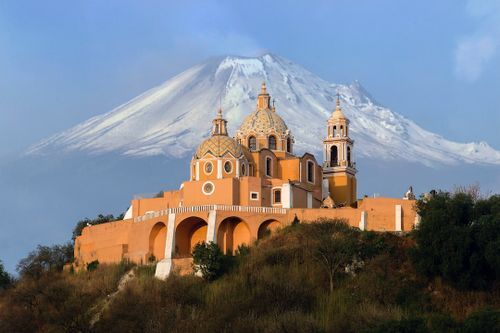
- Privacy Policy
- Terms & Conditions
- Solo Travel
- Couch surfing
- Travel Buddy
- Meet New People
- Safety Index
- Best countries for solo female travel
- Safest countries for solo female travel
- Cheap countries for solo female travel
- Best places for solo female travel
- Safest places for solo female travel
- Cheap places for solo female travel


Stories by Soumya
The Travel Blog of a Culture Addict
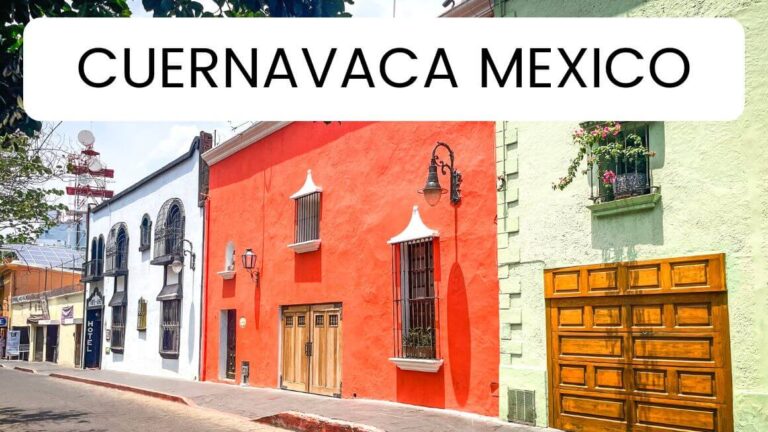
17 Best Things to Do in Cuernavaca Mexico
Last Updated on September 15, 2023 by Soumya
Looking for the best things to do in Cuernavaca Mexico ? Wondering what are the best Cuernavaca attractions ? Don’t worry. We have you covered.
I just got back from the most epic Cuernavaca trip and cannot stop gushing about how beautiful it is.
Chock full of colonial buildings and gorgeous haciendas , Cuernavaca is one of the prettiest cities to visit in Central Mexico .
Cuernavaca is home to the 16th-century Cathedral of the Assumption of Mary, a UNESCO heritage site as well as the Palace of Hernan Cortes featuring the most beautiful Diego Rivera murals. Taxco, the City of Silver, is only a stone’s throw away. And so is the world heritage site of Xochicalco.
No doubt, the list of best things to do in Cuernavaca is endless . But I have tried and squeezed my favorite places into this epic Cuernavaca bucket list.
If you’re visiting Cuernavaca for the first time or the fifteenth, this ultimate Cuernavaca travel guide will be your best friend helping you navigate the city and find the top things to do, the best places to stay, and the best day trips to take.
Please note: This post may contain affiliate links which means I may earn a commission if you make a purchase by clicking a link on this post. This will be at no additional cost to you. Affiliate links help me keep this website up and running. Thanks for your support!
Planning your Cuernavaca trip last minute?
If you are booking your trip to Cuernavaca Mexico last minute, don’t worry. We have you covered. Here are some of the best tours and hotels in the city.
Top Experiences and Tours in Cuernavaca Mexico
- Taxco, Cuernavaca, and Pre-Hispanic Mine Tour from Mexico City (Bestseller!)
- The Magical Colonial Towns of Taxco and Cuernavaca (Small-group tour with excellent reviews!)
Top Hotels in Cuernavaca Mexico
- Las Mañanitas (Luxury) – Expedia | Booking
- Hotel & Spa Hacienda de Cortes (Midrange) – Expedia | Booking
- El Jardín del Edén B&B Boutique (Budget) – Booking
Table of Contents
How to get to Cuernavaca?
Getting to Cuernavaca is easy due to its proximity to Mexico City. It is located only 50 miles to the south of the Mexican Capital and there are several ways to get there.
By Bus: Multiple bus companies operate regular services from Mexico City to Cuernavaca. The journey takes around 1.5 hours, depending on the traffic. Buses depart from Taxquena or the South Bus Terminal (Terminal Central de Autobuses del Sur) in Mexico City. Both Pullman de Morelos and Futura buses run on this route. You can book Futura bus tickets on Busbud website here .
By Car: If you’re driving, you can take the 95D highway which connects Mexico City and Cuernavaca. The drive is typically around 1.5 hours, depending on traffic. Check for directions on Google Maps here . Rent a car in Mexico City here .
By Tour: Guided tours are a preferred way of visiting Cuernavaca from Mexico City because they often include other notable destinations like the Silver Town of Taxco and take care of all logistics. If you’re concerned about the safety of exploring nearby Taxco which lies in the State of Guerrero, I highly recommend taking a guided tour.
Here are a couple of highly recommended Cuernavaca guided tours from Mexico City.
About Cuernavaca Mexico
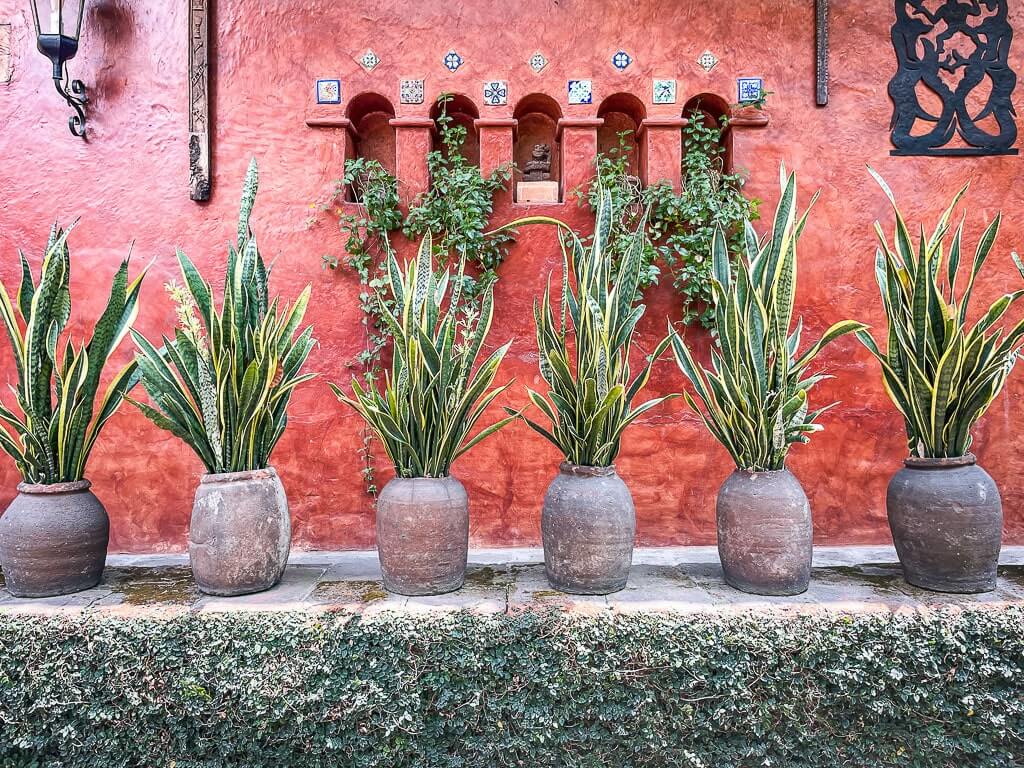
- Cuernavaca, pronounced “Kwair-nah-vah-kah”, is the capital of Morelos State in Mexico. It is often dubbed “The City of Eternal Spring” because of its year-round mild climate.
- Cuernavaca is home to Palacio de Cortes, the oldest conserved colonial-era civil structure in the continental Americas . Built by Hernan Cortes, this fortress-like palace is a unique piece of colonial architecture.
- The haciendas and quintas of Cuernavaca have always been a favorite getaway of the Mexican elite who come here for the fresh mountain air and great weather.
- Since Cuernavaca is located just 50 miles to the south of Mexico City, it is often visited on a day trip from the Mexican capital. It is easy to combine Cuernavaca with the silver mining town of Taxco on a group tour like this one and see the best of both.
Best Things to Do in Cuernavaca Mexico
Palace of cortes.
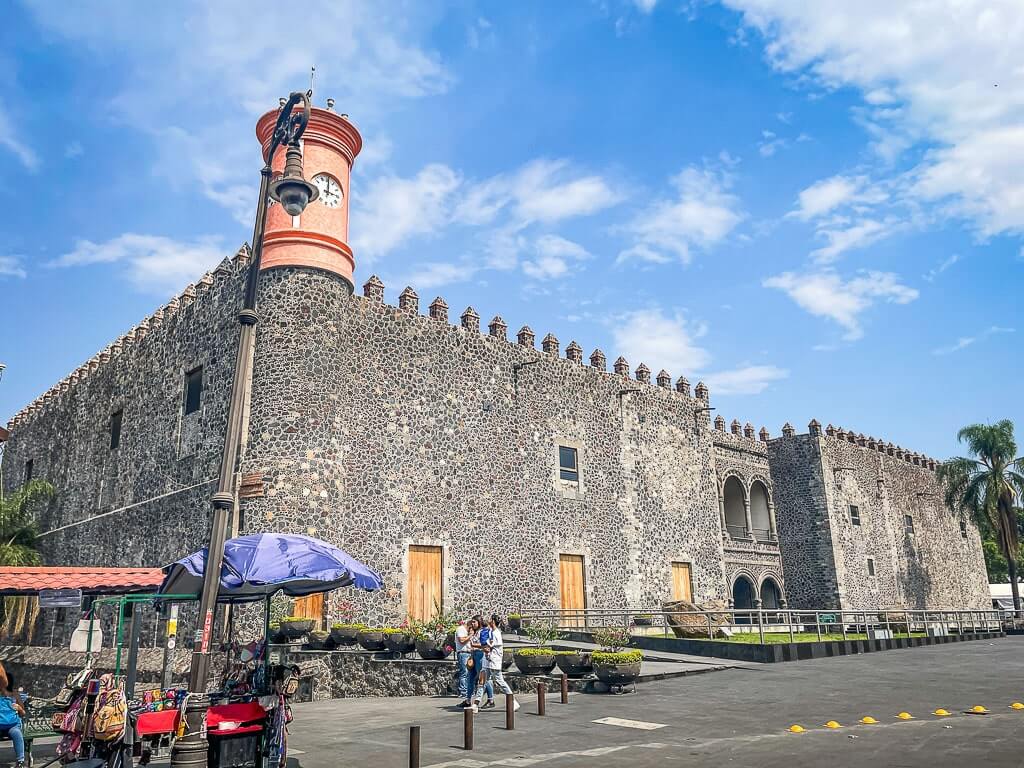
The Palace of Cortes, a must-visit Cuernavaca attraction , carries immense historical significance.
Constructed in the early 16th century, this fort-like palace served as the residence of Hernan Cortes , the famous Spanish conquistador. Its unique architecture is a testament to the fusion of Spanish and Mesoamerican cultures, giving visitors a glimpse into Mexico’s rich past.
Today, the palace houses an impressive museum called the Museo Cuauhnahuac. It is also known as the Regional Museum of the People of Morelos.
At the museum, you can see several artifacts displaying the cultural and natural diversity of the Morelos State including historical displays about the Olmec civilization.
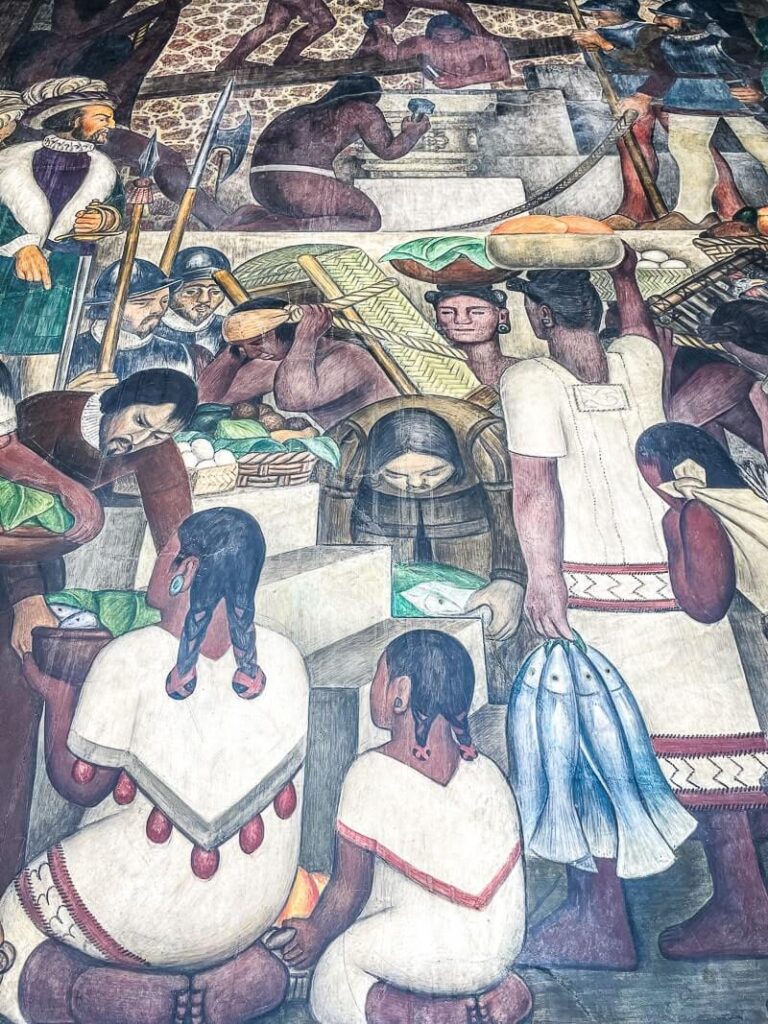
Be sure to go up to the terrace and admire an array of murals by Diego Rivera. These murals depict Mexico’s history from pre-Hispanic times to the Spanish conquest, offering a visual narrative that enriches understanding.
The museum is open 9:00 am – 6:00 pm, Tuesday through Sunday. For the latest information on admission and opening hours, check their official website here .
Robert Brady Museum
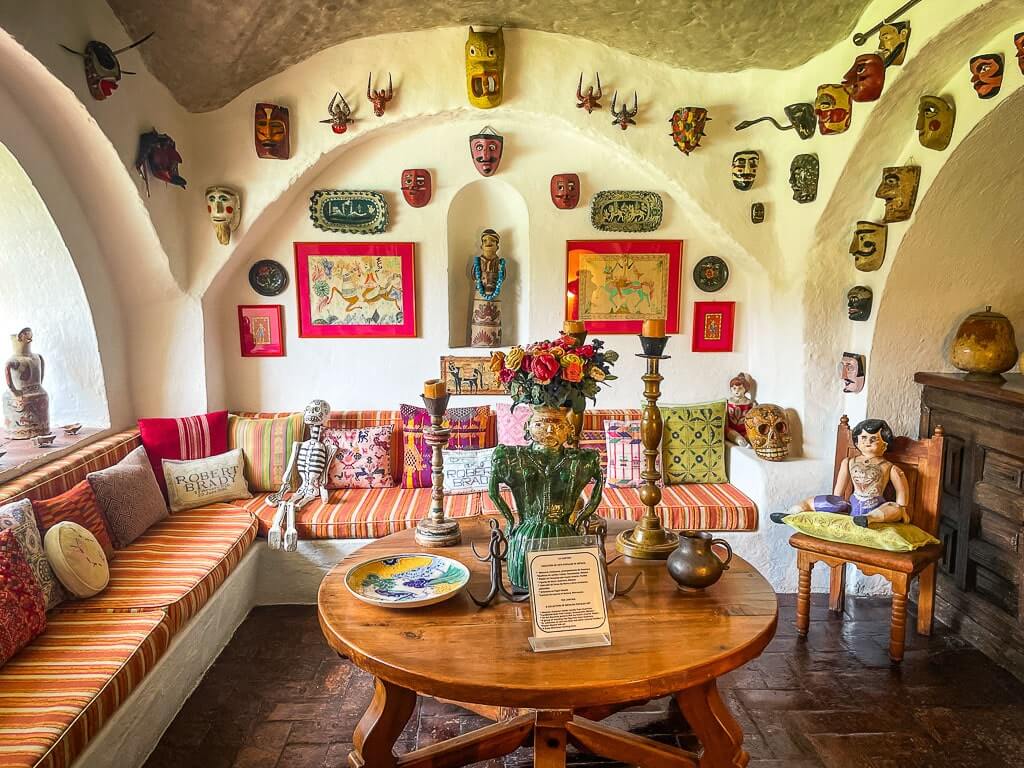
Nestled within the heart of Cuernavaca is the Robert Brady Museum, a distinct gem among Cuernavaca’s attractions.
This museum is set in the former home of Robert Brady, an American artist and avid art collector. It is a unique testament to Brady’s love for art and his eclectic taste .
Brady bought a dilapidated monastery in 1962 and transformed it into a lavish home and later a museum. The colorful exterior of the building is as striking as the array of artwork it houses within.
With a collection exceeding 1,300 pieces of art from all over the world , the museum is a vibrant and colorful reflection of Brady’s travels and his passion for collecting.
The collection includes pieces from every corner of the globe. They range from pre-Hispanic ceramics and African masks to more recent works by renowned artists like Frida Kahlo and Rufino Tamayo.
Don’t miss the Yellow Room which has the most amazing collection of all.
The Robert Brady Museum is not just a museum but a window into the artist’s life. Each room is meticulously preserved to appear as Brady left it.
The 16th-century architecture of Casa de la Torre, where the museum is housed, further adds to the charm.
Cuernavaca Cathedral
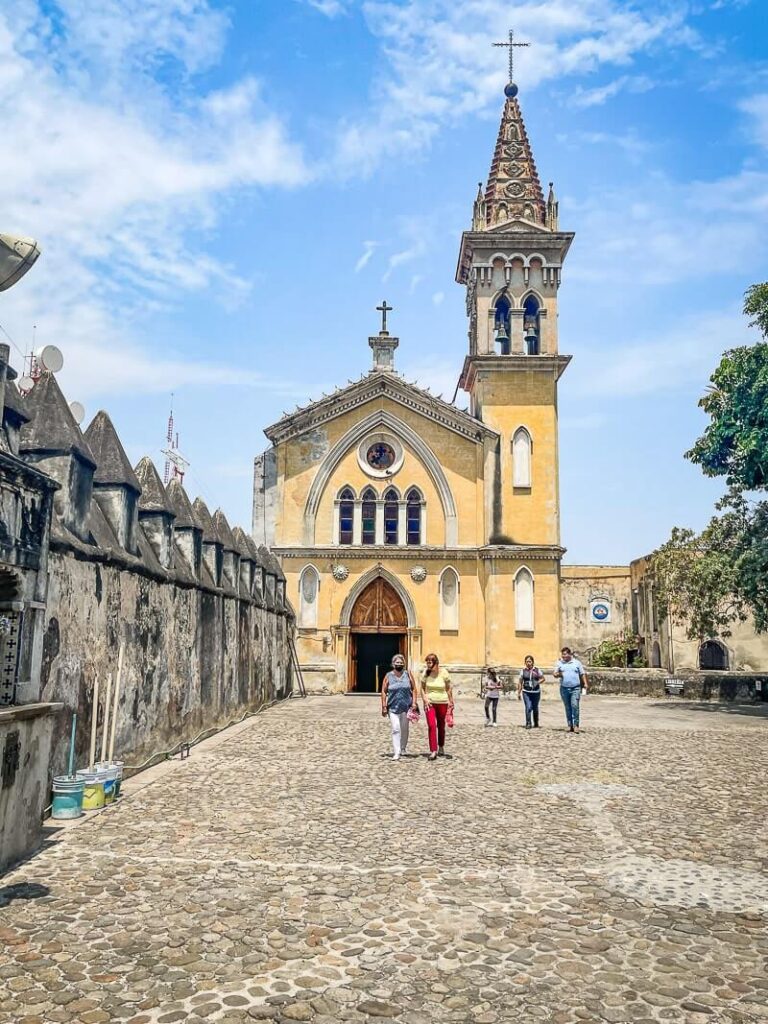
Visiting the Cuernavaca Cathedral is undoubtedly one of the best things to do in Cuernavaca.
The magnificent cathedral, officially known as the Cathedral of the Assumption of Mary, stands as a testament to the city’s rich history.
Built back in the 16th century, the cathedral is one of the oldest in Mexico and an exceptional example of early colonial architecture. Therefore, the Cuernavaca Cathedral & Monastery is part of the UNESCO-listed Earliest 16th-Century Monasteries located on the Slopes of Popocatepetl.
Inside, you’ll find a beautiful main altar adorned with an impressive image of the Virgin Mary and a series of murals that depict biblical scenes.
The highlight is a massive 17th-century mural depicting the life of Philip of Jesus and his martyrdom in Japan.
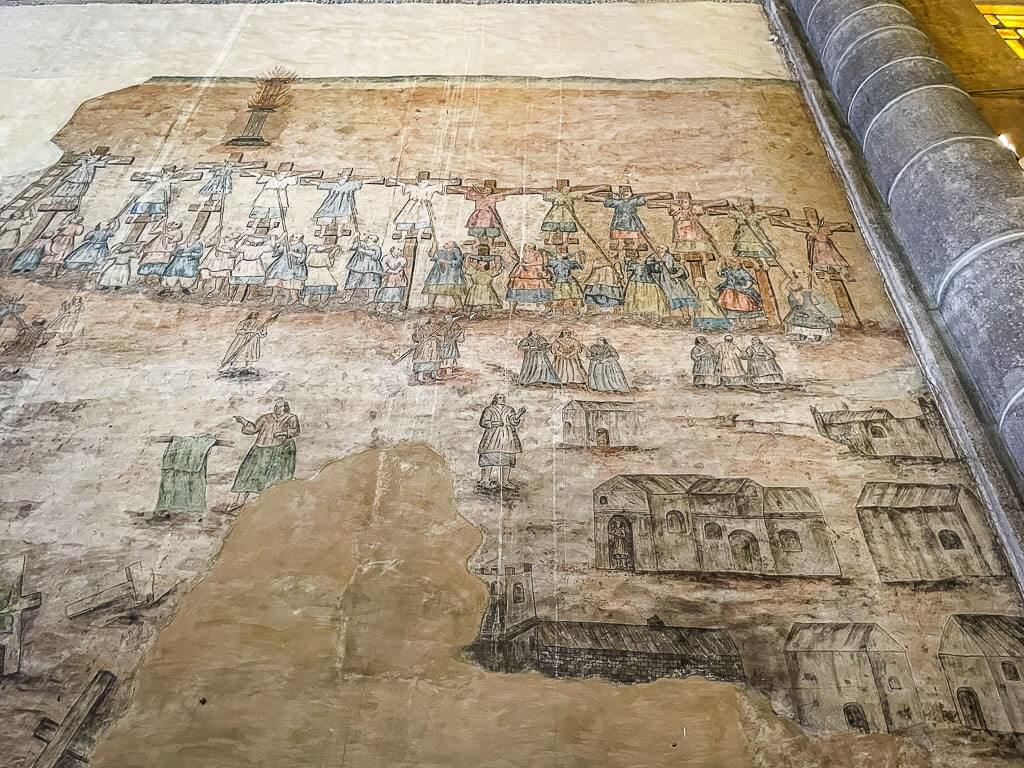
Another unique thing about the Cuernavaca Cathedral apart is the open chapel, known as the Capilla Abierta. This unique architectural feature is one of the few surviving open chapels in Mexico. It was probably designed for mass conversion of large groups of indigenous people during the early years of Spanish rule.
MMAPO Morelense Folk Art Museum
The MMAPO Morelense Folk Art Museum is a treasure trove of Mexican culture and heritage , making it a must-visit place in Cuernavaca.
This is a small but interesting museum that showcases the richness of Morelos’ traditional arts and crafts.
The collection spans from paper mache toys, ceramics, masks, wooden crafts, and local textiles. They often have a exhibition of Day of the Dead artifacts which is very interesting.
The museum is open 10:00 am – 5:00 pm, Tuesday – Sunday. It is free to enter and has some great Mexican souvenirs that you can buy.
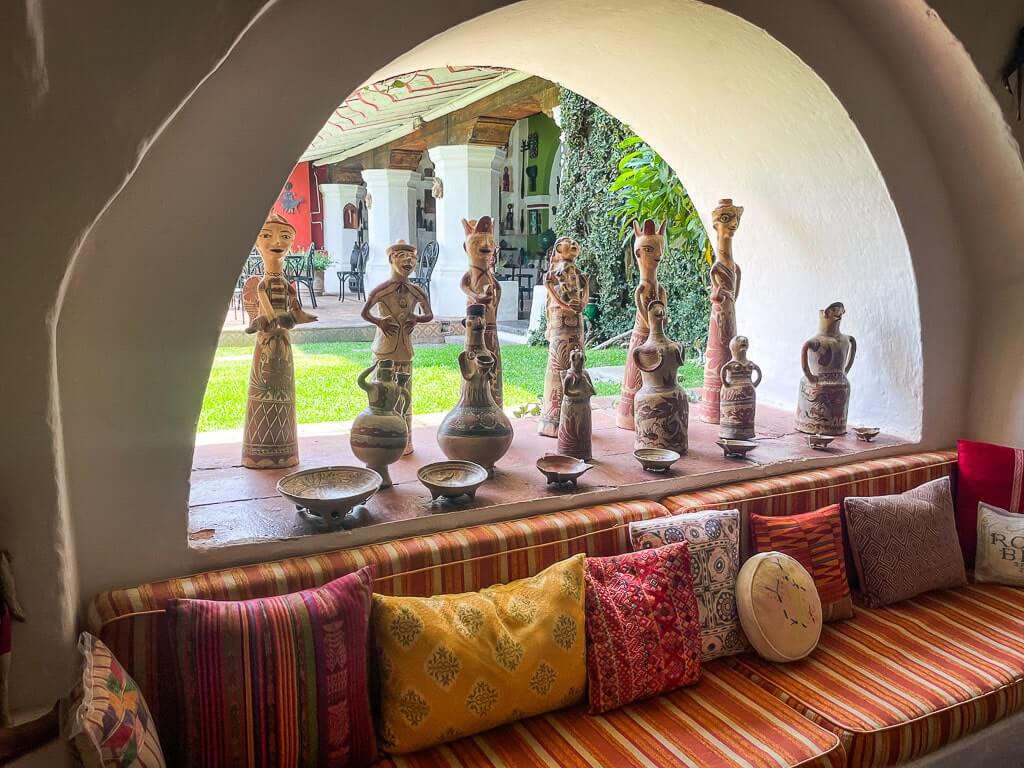
The Zocalo of Cuernavaca, also known as the Main Square, is the vibrant heart of the city. It’s a bustling, lively spot where locals and tourists come to enjoy the vibe.
Apart from being the city center, the Zocalo holds historical significance, surrounded by iconic buildings such as the Palacio de Cortés.
It’s also a hub for local vendors selling everything from delicious street food to handmade crafts, making it an excellent place for souvenir shopping.
Throughout the year, the square is often the site of various festivals and events, offering a glimpse into the rich cultural traditions of Cuernavaca.
With its beautiful gardens, dynamic atmosphere, and charming cafes perfect for people-watching, the Zocalo at Cuernavaca is a must-see attraction on your visit.
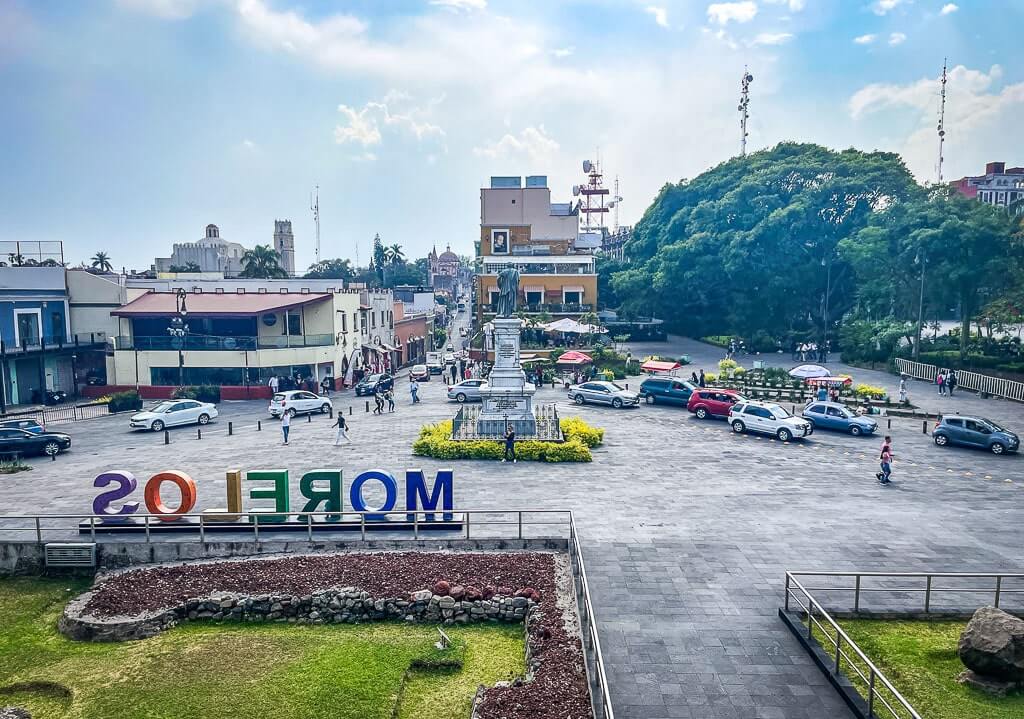
Plaza Moctezuma
Plaza Moctezuma is another remarkable place to visit in Cuernavaca.
Named after the legendary Aztec ruler, Plaza Moctezuma is a historic building dating to 1903. It was once a luxurious hotel and went on to serve as the headquarters of Mexican revolutionary, Emiliano Zapata Salazar.
An iconic photo of Zapata Salazar taken at the Moctezuma Hotel , now Plaza Moctezuma, is one of the most famous pictures of a Mexican citizen. The picture has been reproduced in textbooks, tshirts, paintings, sculptures, memorabilia, and even some of Diego Rivera murals.
The red brick building with high arches and impressive columns is a shopping plaza today with stores selling everything from desserts and sweets to typical Morelos souvenirs.
Borda Garden

Visiting Borda Garden is undeniably among the top things to do in Cuernavaca, especially for nature lovers.
Established in the 18th century by a wealthy silver miner from Taxco, José de la Borda, this lush, tranquil garden is a true oasis in the heart of the bustling city.
The garden features a wide range of exotic plants and beautifully manicured landscapes . That provides a picturesque setting for leisurely walks. If you’re visiting Cuernavaca with your loved one, then be sure to spend some time here.
It also houses a museum that showcases a collection of paintings and relics associated with Maximillian and Carlota, who used the site as their summer residence. A painting depicting Maximilian with La India Bonita (the beautiful Indian who later became his lover) in the garden is the highlight.
Located a short walk away from the Cuernavaca Cathedral, Borda Garden is a slice of paradise that offers a serene retreat from the city’s noise and hustle.
The garden is open 10:00 am – 5:30 pm, Tuesday through Sunday. Admission is free on Sundays.
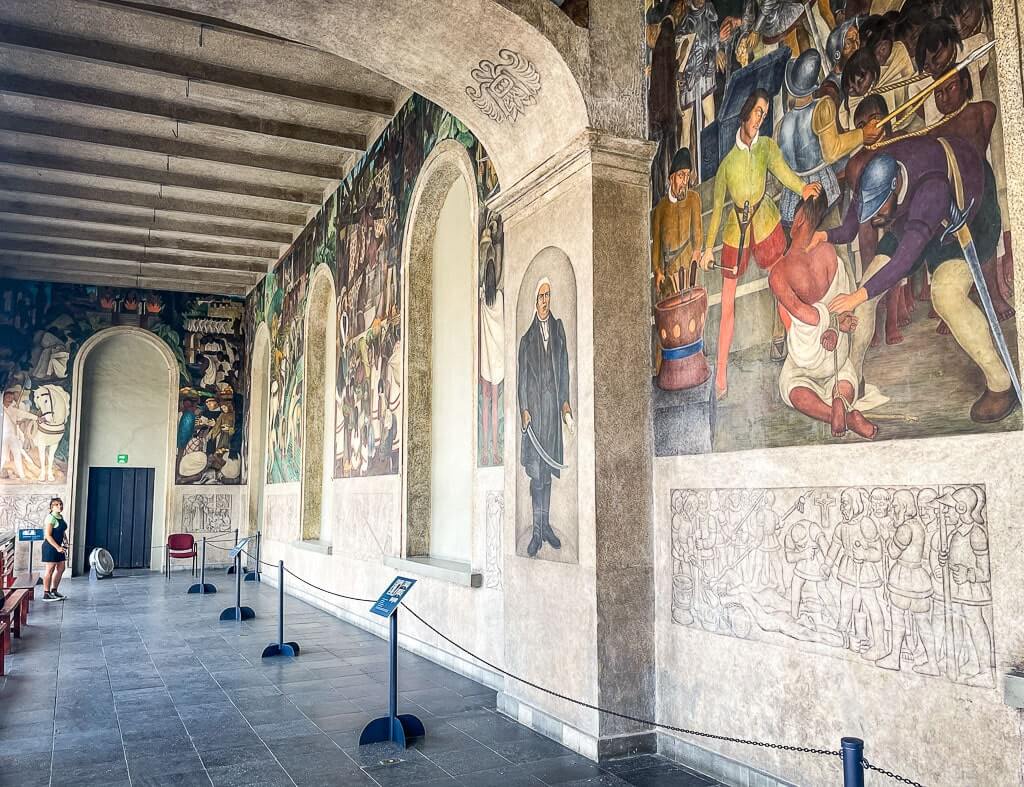
La Tallera Art Museum
La Tallera Art Museum in Cuernavaca is special because it’s not just a museum; it’s the former workshop of one of Mexico’s most renowned muralists – David Alfaro Siqueiros.
This modern art space provides a unique glimpse into Siqueiros’ life and work. When Siqueiros moved to Cuernavaca in the 1960s, he transformed his home into this workshop, or “La Tallera,” where he crafted many of his masterpieces.
Preserved and converted into a museum after his death, La Tallera showcases Siqueiros’s murals like few other places can. Not only does it display his works, but it also celebrates his working methods and the creative processes behind his famous murals.
Visiting La Tallera is almost like stepping inside the mind of a creative genius, making it a must-visit for art aficionados, history buffs, and anyone interested in the cultural scene in Cuernavaca.
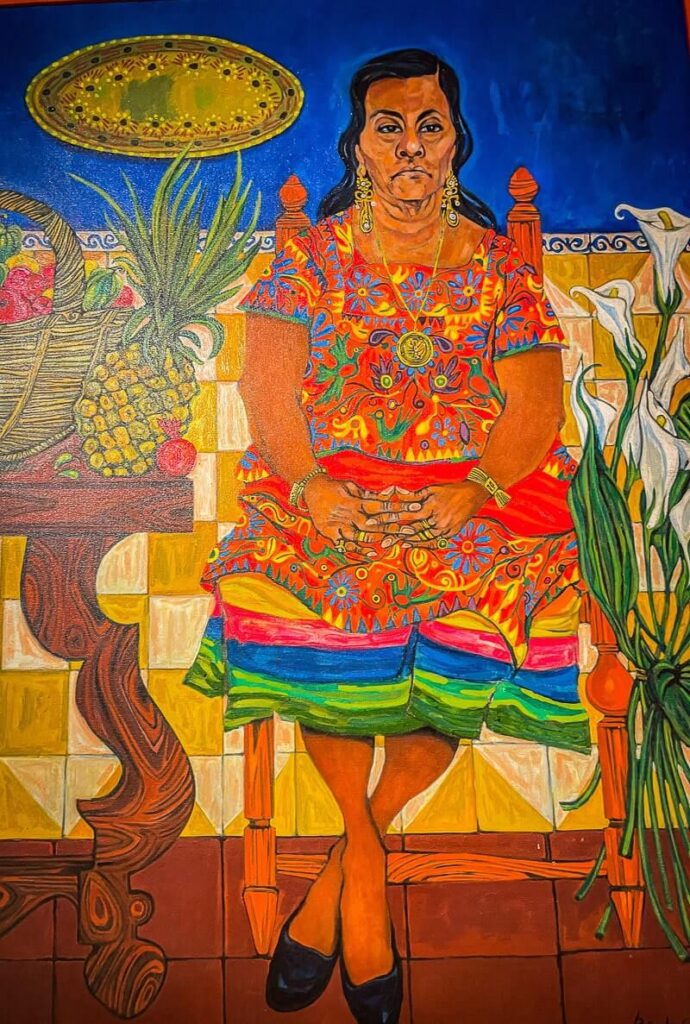
Papalote Children’s Museum in Cuernavaca
Papalote Cuernavaca is an interactive children’s museum that is an absolute must-visit if you’re traveling to Cuernavaca with the little ones. It is part of the Papalote Museo del Nino, a Mexico City-based network of museums aimed at helping children learn through play.
The museum features hands-on exhibits covering a wide array of subjects , from science and technology to art and environmental awareness. They have over 40 permanent exhibitions and many more temporary ones for the kids to interact with and play around.
Check their official website for opening hours and admission charges before visiting. They are closed on Mondays.
Papalote Cuernavaca provides a fun and educational day out for the entire family. Its innovative approach to learning by touching and playing , a wide range of exhibits, and focus on child-friendly interactions make it one of the top Cuernavaca attractions for families.
Mercado de Artesanias
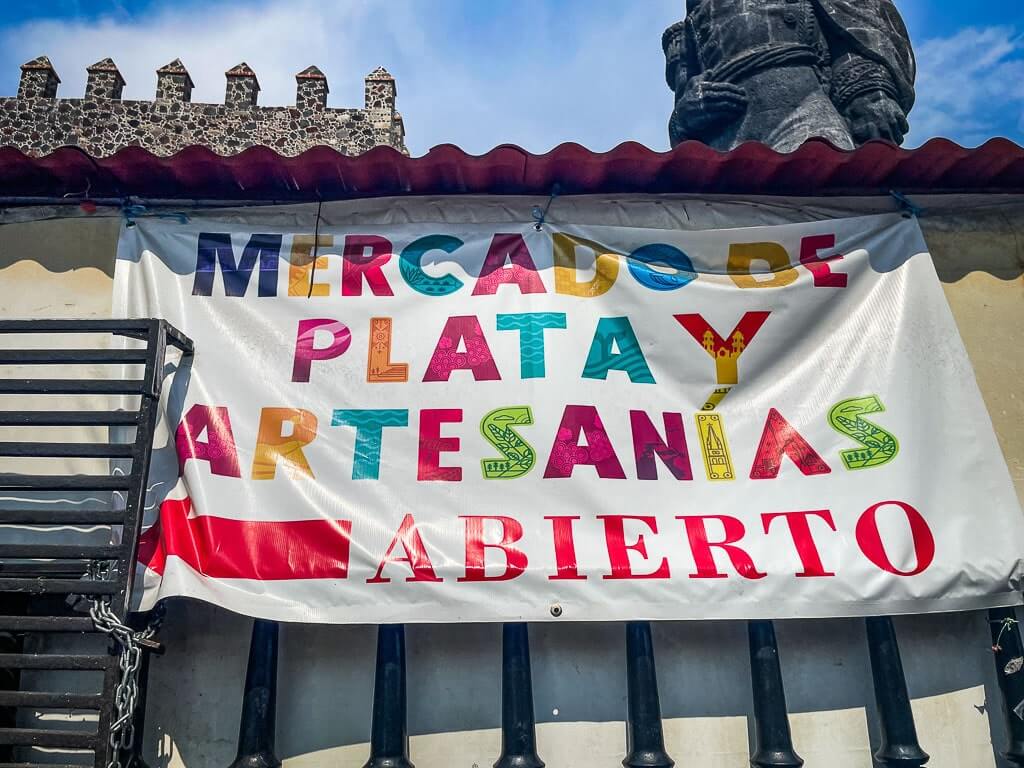
Mercado de Artesanias in Cuernavaca is your shopping haven if you’re looking for authentic and unique things to take back home from Mexico .
This bustling market is teeming with artisanal stalls where local craftsmen exhibit their handcrafted goods , providing a fantastic opportunity to purchase a piece of Mexican culture.
You’ll find an impressive array of items here, from intricately woven textiles and hand-painted ceramics to beautiful jewelry, leather goods, and traditional Mexican toys.
What sets Mercado de Artesanias apart is not just the quality and variety of the goods, but also the vibrant atmosphere. As you navigate the narrow aisles, you’re surrounded by the friendly chatter of the vendors, the smell of freshly prepared street food, and the lively hum of locals and tourists alike.
It’s not just about shopping. It’s about immersing yourself in the local culture and lifestyle , making the market one of the top places to visit in Cuernavaca.
This experience provides a personal touch to your shopping and contributes to the local economy. Doesn’t that make your trip to Cuernavaca more meaningful and memorable?
✦ Pro Tip : Shopping anywhere in Mexico is a wonderful experience. Check out all the amazing things to buy as gifts from Mexico .
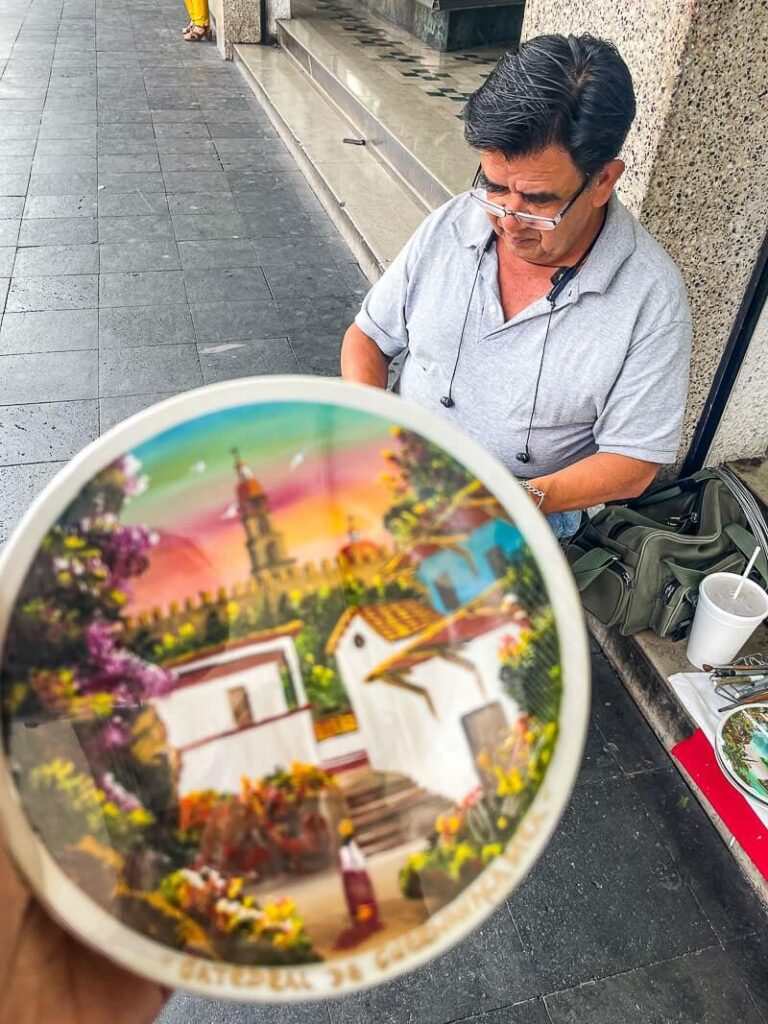
Pre-Hispanic Site of Tepanzolco
The Pre-Hispanic Site of Tepanzolco was built by the Tlahuica tribe , the original inhabitants of Morelos. It was later annexed by the Aztec Empire and is one of the most fascinating Aztec ruins to visit near Mexico City .
The highlights of Tepanzolco include the Great Platform or Pyramid that housed the twin temples of Tlaloc, the Aztec God of Rain and Huitzilopochtli, the Aztec God of War.
Distinguished by their unique dual-staircase design, twin temples are featured in a few rare pyramids in Mexico City . These temples were dedicated to the Aztec gods of rain and war respectively.
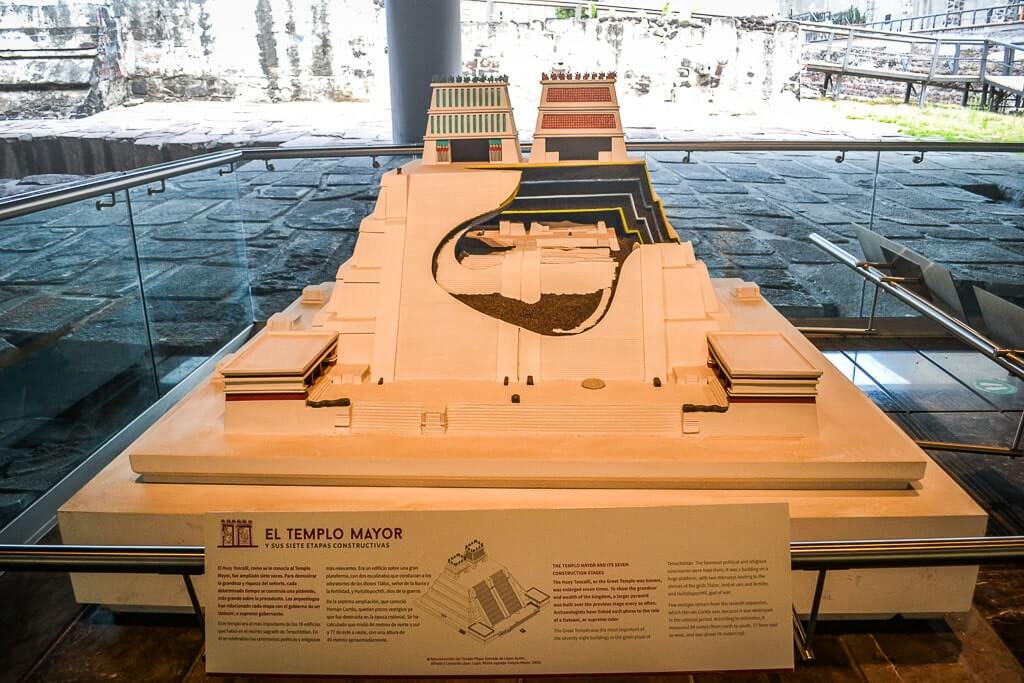
The archeological site was badly damaged in the Mexico earthquake of 2017. Climbing the pyramid has been banned since then.
However, if you wish to delve into Mexico’s pre-Hispanic history or want to know how Cuernavaca looked a thousand years ago, then Tepanzolco is a great place to visit.
✦ Pro Tip : If you love ancient pyramids, then you’ll love this epic bucket list of the 20 Most Fascinating Pyramids in Mexico.
Colorful streets of Cuernavaca
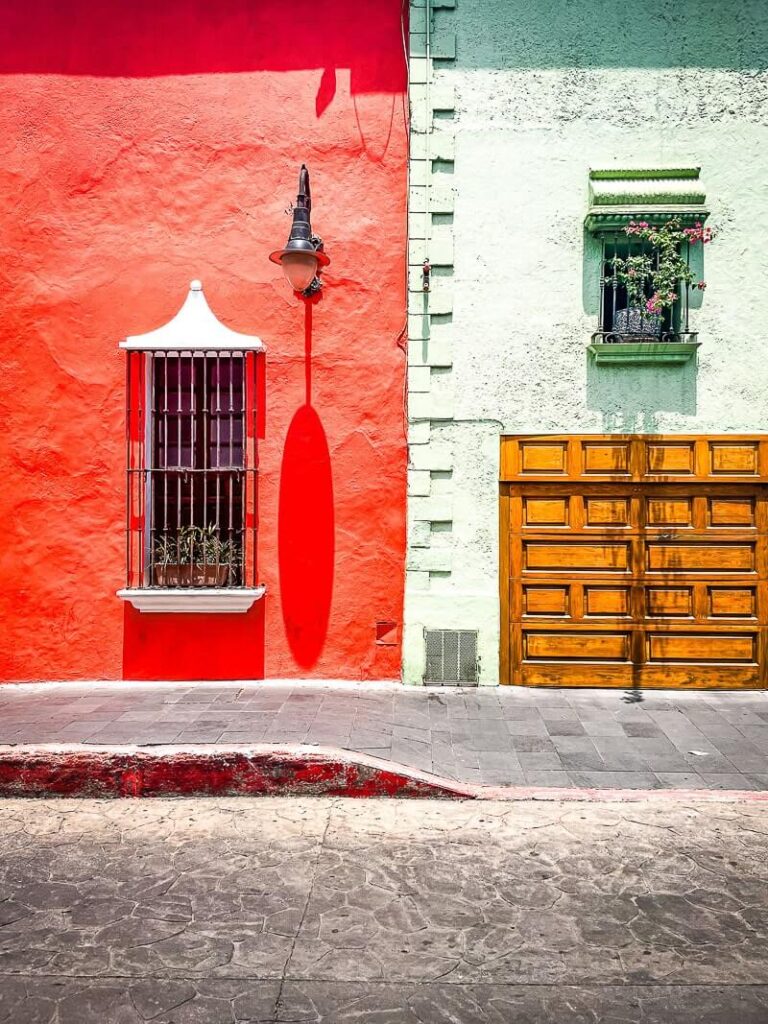
Strolling down the vibrant streets of Cuernavaca, Mexico is a sensory feast that simply must not be missed.
As you wander amidst the city’s colorful streets, you’ll find numerous stories depicting the city’s rich history. Street vendors offer tempting local delicacies, and the sound of mariachi music lingers in the air.
Perhaps, the most authentic thing to do in Cuernavaca is to wander through these streets and observe the neighborhood markets bustling with locals.
I picked up my most precious Mexican souvenir, a hand-painted Cuernavaca plate , from a local on one of these streets. So, don’t miss ambling through them and discovering some hidden gems in Cuernavaca.
Best Things to Do near Cuernavaca Mexico
Taxco – the beautiful silver town of mexico.
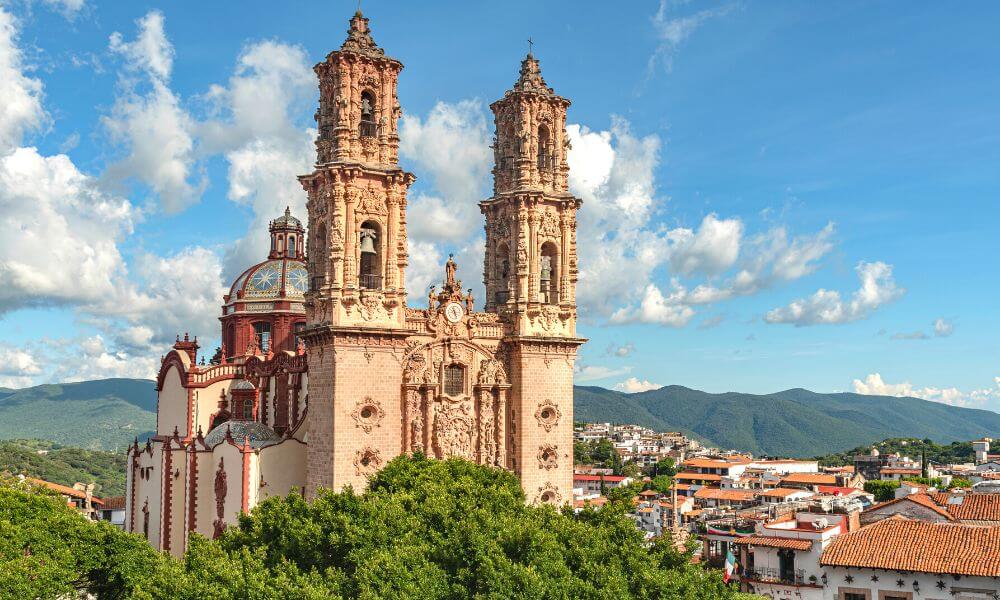
Just a short drive from Cuernavaca lies the enchanting silver town of Taxco , a must-have on your Mexican itinerary.
Nestled on a hillside with winding cobblestone streets, whitewashed houses with red-tile roofs, and a classic Spanish colonial layout, Taxco exudes an irresistible old-world charm.
Once a major silver mining hub in the colonial period, Taxco is now famed for its silver craftsmanship.
The city is one of the best places in Mexico to buy silver jewelry and artifacts , with numerous shops and markets showcasing intricate designs.
Exploring Taxco involves more than just silver shopping, though.
The town’s piece de resistance is the Santa Prisca Church, a baroque masterpiece that towers over the central plaza. Its staggering detailed facade and ornate interiors are a testament to the town’s prosperous mining era.
Take a leisurely walk up to the Cristo Monumental, a gigantic statue of Christ overlooking the city, for panoramic views of the stunning landscape.
Here’s an exciting Taxco + Cuernavaca full-day tour that you’d want to look at if you’re planning to visit from Mexico City.
Archeological Zone of Xochicalco – A UNESCO Heritage Site
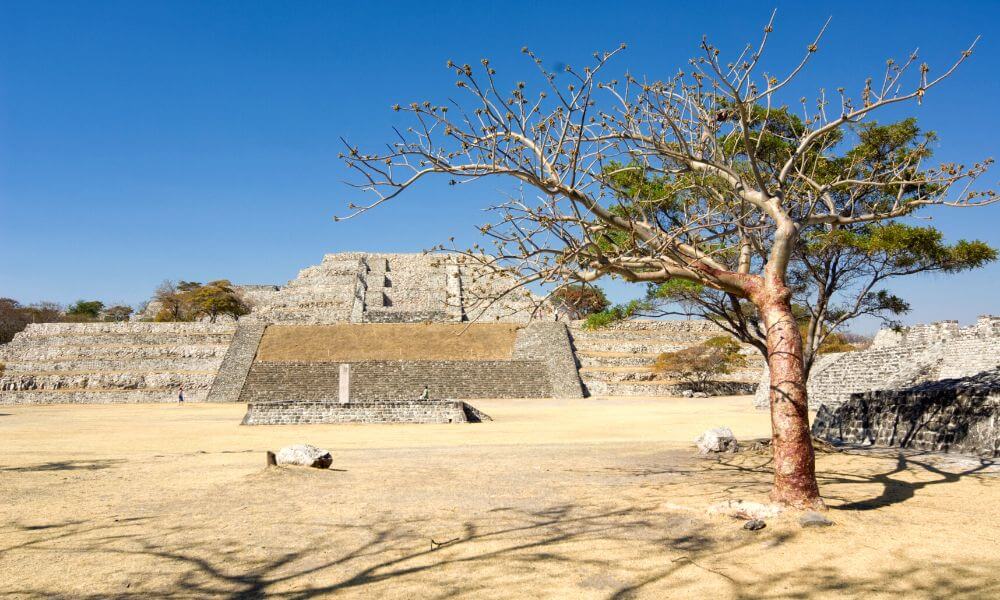
The Archeological Zone of Xochicalco is an amazing day trip from Cuernavaca. Located just a short drive from the city, this UNESCO World Heritage Site is a remarkable testament to the rich cultural and historical heritage of Mexico .
The name “Xochicalco” means “In the House of Flowers” in the indigenous language.
Once a thriving city of the Olmeca-Xicalanca people, a Mayan trading community, Xochicalco is a rare example of a fortified city-state that rose after the fall of Teotihuacan.
Xochicalco’s most notable attraction is its magnificent Mexican pyramid , the Pyramid of the Feathered Serpent .
This multi-tiered structure is intricately adorned with detailed carvings depicting the Feathered Serpent deity, a symbolic representation seen in other Mesoamerican cultures like the Aztecs and Mayans.
Other highlights of the archeological complex include plazas, altars, and a ball court that offer a fascinating insight into the ceremonial and social life of its former inhabitants.
Here’s an amazing Xochicalco + Cuernavaca full-day tour if you’re considering visiting from Mexico City.
Hacienda San Gabriel de las Palmas
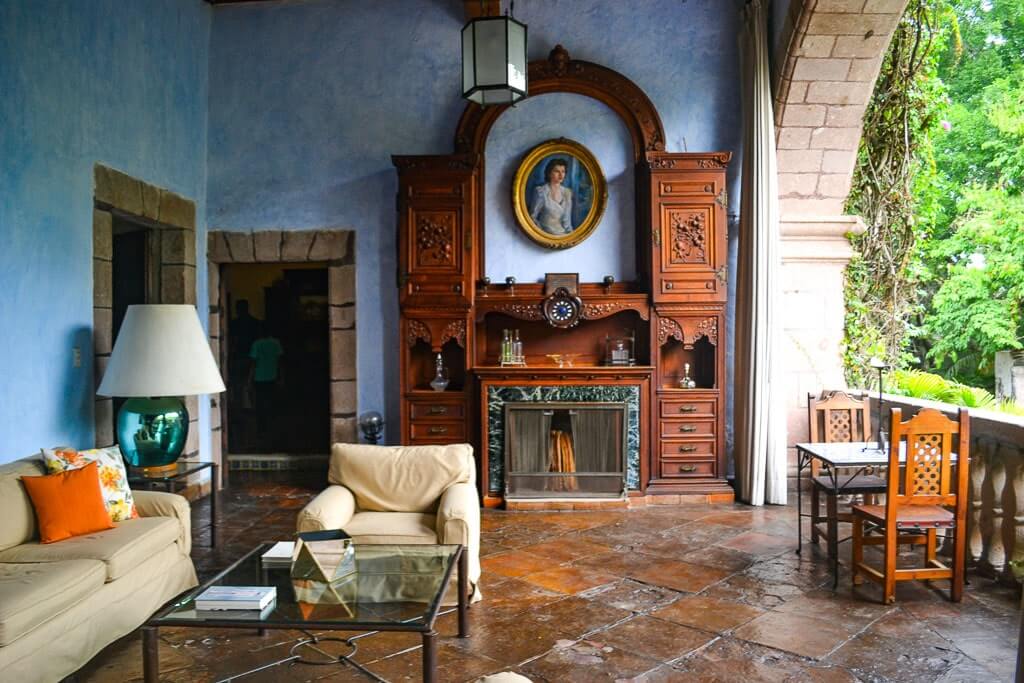
Located just 30 miles to the south of Cuernavaca, Hacienda San Gabriel de las Palmas is a former 16th-century sugar cane plantation-now-luxurious hotel. Staying here for a couple of days allows you to soak in the rich history of Cuernavaca’s colonial past/
The hacienda is steeped in heritage . Every room here echoes a bygone era of colonial elegance, having been meticulously restored to its original splendor.
Originally built in 1529 under the orders of Hernan Cortes himself, this grand estate was once a Franciscan Monastery and then a sugar mill. Later, it became an important site during the Mexican Revolution.
The hacienda’s ornate architecture, featuring vaulted ceilings, arched doorways , and its lush tropical gardens provide a serene and beautiful setting that promises to transport you back in time.
Spend your days lounging by the pool set amidst the gardens, pamper yourself at the on-site spa, or dine at the gourmet restaurant that serves exquisite Mexican and international cuisine cultivated from the hacienda’s own organic garden.
For adventure seekers, the hacienda offers horseback riding, hiking trails, and the opportunity to explore the surrounding landscapes of Cuernavaca.
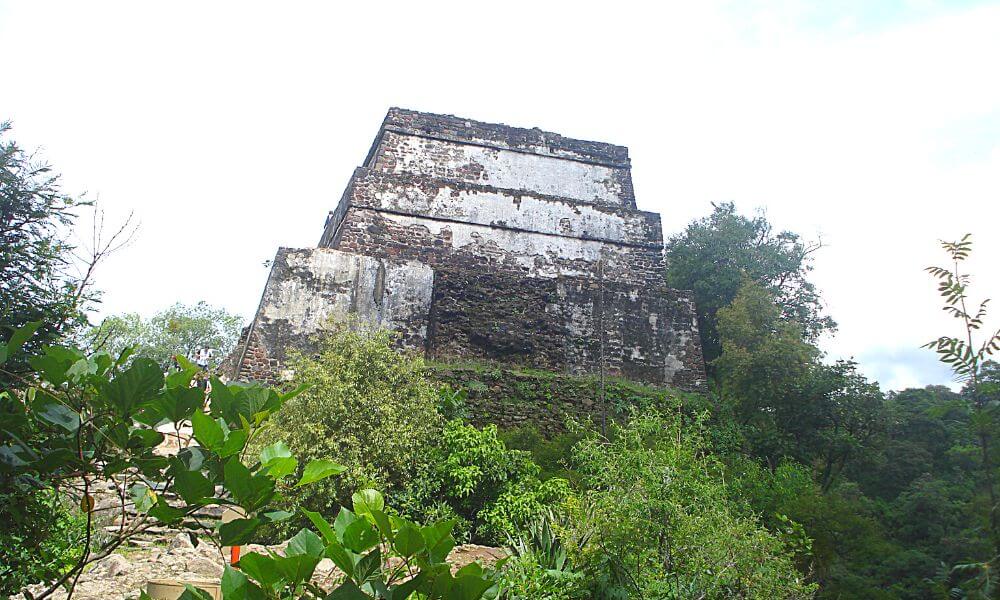
A mere half-hour drive from Cuernavaca will take you to Tepoztlan, a pueblo magico that is a combination of Mexico’s rich heritage and natural beauty . It’s a wonderful day trip destination and a must-do on any Cuernavaca itinerary.
The town center is charming, boasting cobblestone streets and vibrantly painted buildings.
You can explore the Former Convent of the Nativity, now a UNESCO heritage site and a museum showcasing pre-Hispanic artifacts and local history.
Another iconic landmark, the Tepozteco pyramid, perched atop a hill , beckons the adventurous for a thrilling hike. Despite the steep climb, the panoramic views of the town and surrounding valleys are certainly worth the effort.
A vibrant food scene complements the rich history of Tepoztlan. The local market is a gastronomical delight, offering unique regional specialties like ‘itacates’ (stuffed tortillas) and ‘tepache’ (a fermented pineapple drink).
Weird and exotic meats of armadillos, tarantulas, and warthogs are also on offer. Adventurous enough?
Tepoztlan’s unique blend of history, culture, and natural beauty, combined with its proximity to Cuernavaca, makes it a fantastic day trip.
Jardines de Mexico: A Botanical Paradise

Considered one of the most captivating attractions in Cuernavaca, Jardines de Mexico is a spectacle of vibrant color and natural beauty.
As one of the largest flower gardens in the world , Jardines de Mexico covers an impressive 51 hectares and offers a captivating blend of nature, art, and relaxation.
The gardens consist of eight different thematic sections, each meticulously designed and cared for, offering a unique exploration of various plant species.
From the enchanting Italian and Japanese gardens to the captivating tropical and cactus gardens, each section is a world of its own, brimming with mesmerizing flora.
Visiting Jardines de Mexico is more than just a visual treat, it’s an immersive experience. Here, you can enjoy a tranquil stroll, learn about various plant species, or simply relax amidst nature’s grandeur.
With its lush greenery, stunning floral displays, and peaceful ambiance, it offers a refreshing escape from the hustle and bustle of urban life, making it a must-visit when in Cuernavaca.
Where to stay in Cuernavaca Mexico?
If you’re visiting Cuernavaca for the first time, I highly recommend that you stay in the city center. Also known as Centro, Cuernavaca’s city center is an excellent choice because it’s home to several historic sites, vibrant squares, and lively markets.
Here are some of the best Cuernavaca hotels in the city center .
- Las Mañanitas is a highly-rated 4-star hotel in Cuernavaca Centro. Known for its charming colonial architecture and beautifully landscaped gardens, Las Mañanitas provides the perfect space for relaxing and rejuvenating on a long Mexican holiday. ✅ BOOK YOUR STAY AT LAS MANANITAS HERE
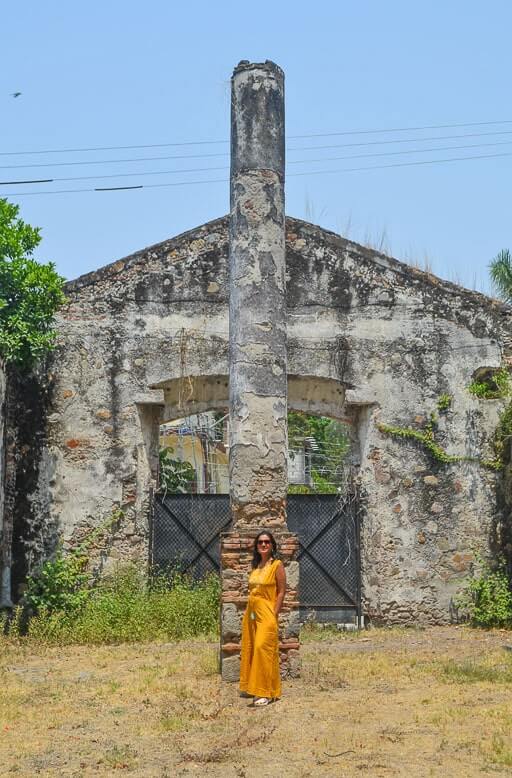
- If you’re looking for a pretty hacienda, check out Hotel & Spa Hacienda de Cortes . This former 16th-century sugar cane plantation founded by Cortes himself is steeped in history. It is now converted into a hotel and features an outdoor swimming pool, a highly-rated spa, and beautifully landscaped grounds. ✅ BOOK NOW!
- We had been eyeing Hotel & Spa Hacienda de Cortes until we stumbled on Hacienda San Gabriel de las Palmas in Amacuzac and decided to spend two awesome days there.
- If you’re looking for something more budget-friendly, check out El Jardín del Edén B&B Boutique . A cozy hotel with the warmest staff, El Jardín del Edén B&B Boutique features homely rooms, an outdoor swimming pool, and a beautiful sun terrace. ✅ CHECK PRICES & AVAILABILITY
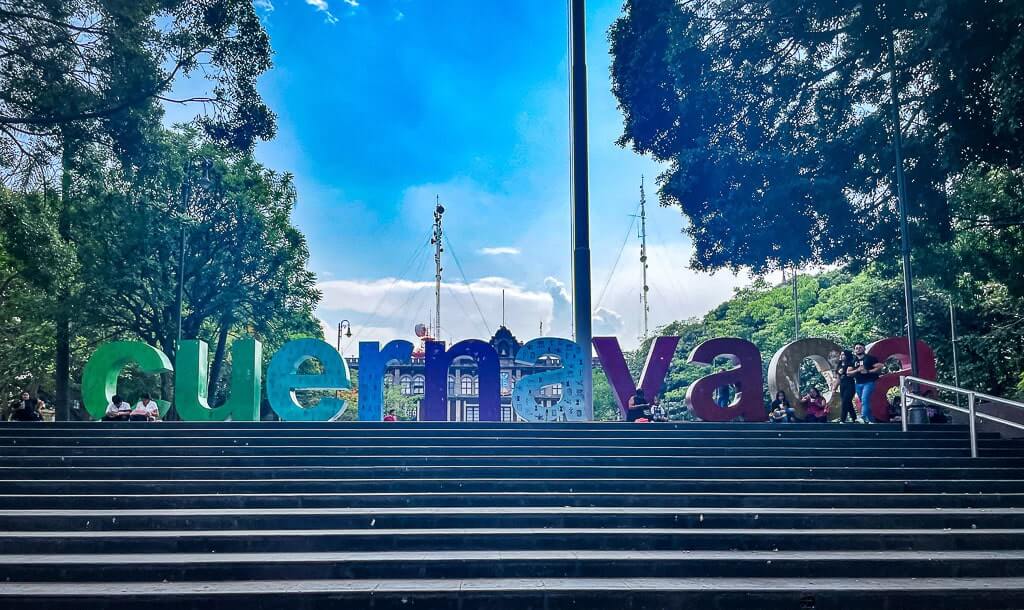
Best Time to Visit Cuernavaca Mexico
Cuernavaca, renowned as the “City of Eternal Spring,” enjoys pleasant weather all year round .
Temperatures vary little throughout the year (averaging at the mid-seventies) except for April, May, and June which are the hottest months.
The best time to visit is during winter from November to Feb , when temperatures are lower and days are dry – ideal for outdoor activities and sightseeing.
January is also a great time to visit if you wish to catch Carnival Jiutepec, the largest celebration in the state of Morelos. Carnival Jiutepec is a vibrant display of color and culture, featuring lively parades, traditional music, and dance performances.
How to get around Cuernavaca Mexico?
The best way to get around Cuernavaca is by walking.
The city is quite walkable, particularly the downtown area where many of the key Cuernavaca attractions are located. Meandering through the city streets on foot allows you to soak in the city’s vibrant atmosphere and discover hidden gems.
Taxis are a reliable option and are typically inexpensive. However, ensure to confirm the fare before your journey to avoid any misunderstandings.
I also noticed a Cuernavaca City Tour Bus (picture below). You can board one of these and check out the sights too.
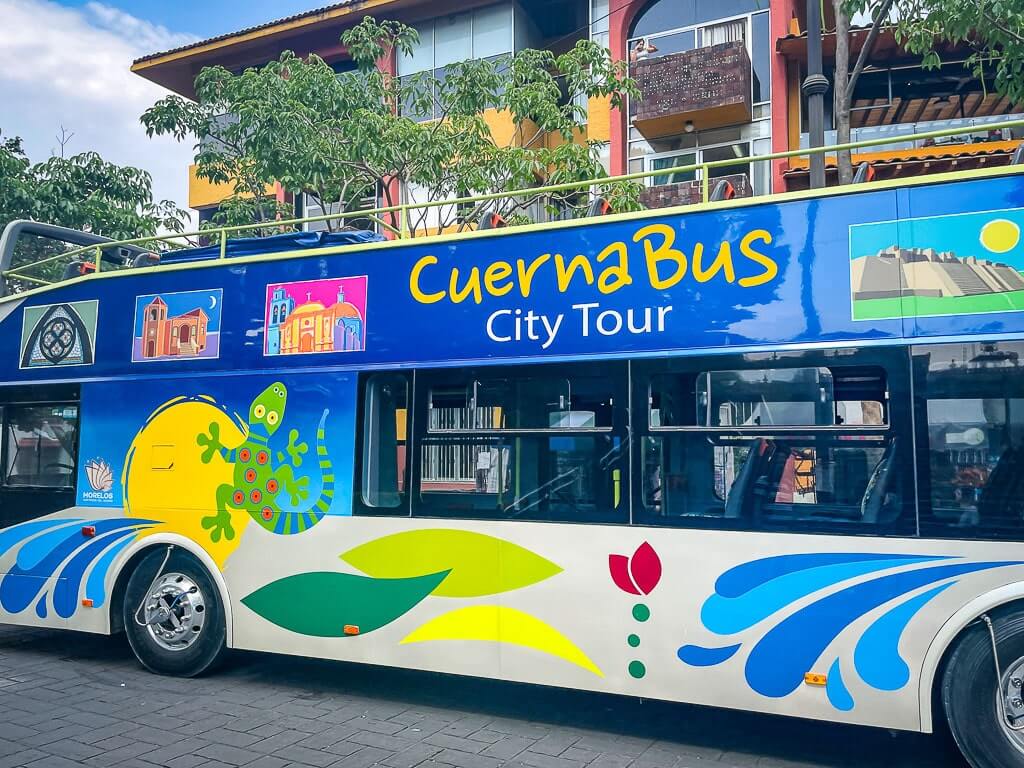
Cuernavaca Mexico Travel FAQ
Yes, Cuernavaca in Mexico is absolutely worth visiting because of its rich combination of ancient and colonial history as well as beautiful natural landscapes. Whether it is the awe-inspiring architecture of the Palacio de Cortes, the tranquility of Jardin Borda, the ancient pyramid of Xochicalco, or the silver mining history of nearby Taxco, Cuernavaca will surely leave you enchanted.
Cuernavaca is famous for its rich cultural heritage and historical landmarks such as the Cathedral of the Assumption of Mary, a UNESCO world heritage site known for its brilliant 16th-century colonial architecture. Other important landmarks include Palacio de Cortes, an impressive fortress-like-palace, and the archeological site of Xochicalco, a UNESCO World Heritage site, offering a deep dive into the ancient civilizations of Mexico.
Visit Cuernavaca to enjoy a beautiful blend of pre-Hispanic and colonial Mexican history and architecture and a treasure trove of exquisite gardens and beautiful natural landscapes. The city is full of amazing attractions such as the Cuernavaca Cathedral (a UNESCO site), the Palace of Hernan Cortes, the Borda Garden, and an eclectic Robert Brady Museum. Beautiful haciendas, ancient archeological sites, and once-prosperous silver mining towns are just a stone’s throw away from Cuernavaca.
Yes, the tourist areas in Cuernavaca Mexico are generally safe. However, like any other place in this world, you need to maintain standard safety precautions. Avoid isolated areas, particularly at night, don’t wear flashy jewelry, carry minimum cash, and always safeguard your belongings.
Loved this Travel Guide for Cuernavaca Mexico? Pin it for later!
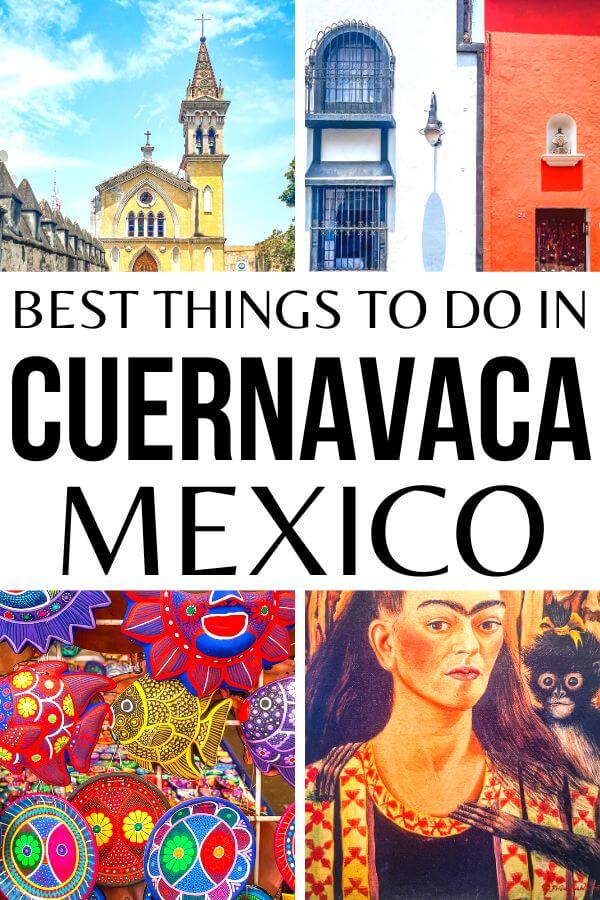
You may also like:
- 10 Best Central Mexico Cities To Visit In 2024
- 5 Best Places To See Diego Rivera Murals In Mexico…
- What To Do In Mexico City On A Monday - 15 Amazing Ideas
Leave a Reply Cancel reply
Your email address will not be published. Required fields are marked *
Post Comment
This site uses Akismet to reduce spam. Learn how your comment data is processed .
Begin typing your search term above and press enter to search. Press ESC to cancel.
- Cuernavaca Tourism
- Cuernavaca Hotels
- Cuernavaca Bed and Breakfast
- Cuernavaca Vacation Rentals
- Flights to Cuernavaca
- Cuernavaca Restaurants
- Things to Do in Cuernavaca
- Cuernavaca Travel Forum
- Cuernavaca Photos
- Cuernavaca Map
- All Cuernavaca Hotels
- Cuernavaca Hotel Deals
- Last Minute Hotels in Cuernavaca
- Things to Do
- Restaurants
- Vacation Rentals
- Travel Stories
- Rental Cars
- Add a Place
- Travel Forum
- Travelers' Choice
- Help Center
Safety and Travel in Cuernavaca Mexico - Cuernavaca Forum
- Mexico
- Central Mexico and Gulf Coast
- Morelos
- Cuernavaca
Safety and Travel in Cuernavaca Mexico

- United States Forums
- Europe Forums
- Canada Forums
- Asia Forums
- Central America Forums
- Africa Forums
- Caribbean Forums
- Mexico Forums
- South Pacific Forums
- South America Forums
- Middle East Forums
- Honeymoons and Romance
- Business Travel
- Train Travel
- Traveling With Disabilities
- Tripadvisor Support
- Solo Travel
- Bargain Travel
- Timeshares / Vacation Rentals
- Morelos forums
- Cuernavaca forum

Anyone have experiences to the contrary?

The Spanish school was nearly empty when I was there last. It's no longer due to the CNN affect. There is a real threat due to the drug cartel. It's killing tourisim...pardon the play on words.
I believe I'm the person who should have expanded remarks on safety in Cuernavaca. Again, I base my experience on two multi-week visits in the past two years living with a family in Cuernavaca.
I'll stand by my point that American tourists are quite safe in Cuernavaca until there is some evidence to the contrary.

In Oaxaca we felt completely safe and secure. The Oaxacans spoke opening about their pride in being so tourist friendly and frankly protective of us. Carlos Slim maintains a residence in Oaxaca. It is pure speculation but perhaps that impacts the crime in a positive way.
I just want to encourage you to visit Oaxaca. It is paradise. Cuernavaca...will probably not be on my list of places to return.
Cuernavaca is safe, period. If there are any problems with taxis, this should have been reported to the airport authorities immediately and there are always tel. numbers to call for the REGISTERED taxis that service the airports.
As far as Carlos Slim-he owns the Cuernavaca Golf Club and most of the properties surrounding that area including his home. In fact, Cuernavaca is home to the many rich and powerful in Mexico and always has been the weekend retreat for the wealthy from Mexico City . The problem is that many tourists are uninformed, unaware and think Mexico is all the same as the sensational reports that make news. I must say that the horrific news coming from the States of home invasions, murders, shootings in schools, offices etc. are "accepted" as common, where these types of impersonal murders are uncommon here. No school shootings-ever!
Cuernavaca is safe but like any city of almost 1 million inhabitants, one has to be aware and savvy when traveling. Everyone takes radio taxis here which are a little more expensive than drive-by taxis, so no one would ever use a freelance taxi which are notoriously unsafe. If a driver left with luggage, then of course the tourists would have or should have reported all the registered numbers that are painted on the taxi to the authorities and all the contact information that is posted inside the taxis. Unfortunately many tourists opt for the less expensive ride to save a dollar.
The advice to only stay in the downtown area shows a lack of familiarity with Cuernavaca which is much, much more than just a downtown area, which by the way is not in the safest part of Cuernavaca since most of the surrounding neighborhoods are lower middle class barrios, but not necessarily dangerous just because these areas are poor. Your Host Inn is in one of these neighborhoods, but that does not make it dangerous simply because it is a working-class area.
The upscale neighborhoods are a delight and have all the beautiful walled estates with gourmet restaurants, art/design galleries, shops that any upper middle class neighborhood would offer and the downtown is only 10 minutes from these great areas such as Bellavista, Vista Hermosa, Reforma, Delicias, Palmira.
Teenagers here always are in groups. They go out in groups and do not date one-on-one like they do in the States. They go in goups to the discos, to restaurants and to Starbucks. To call them mobs is over-the-top especially if you don't have a clue to what they are saying, but the teenagers that I have ever encountered are always polite and respectful. Our daughters and their friends always went to the upscale discos (no one goes to any disco) and they never had to worry about their drinks being spiked. These teenagers take taxis at 3 or 4 AM-many times solo. I always wear jewelry, carry whatever purse I want, and feel safe where I go. As in any city, there are areas that we do not go to, just like in SF, LA, NY, DC, etc.
Just returned from a recient trip to Cuernavaca. It is safe in town, however I ended up at a B&B outside of town and it was dicey. The ad claimed they were a short walk from town, but it was a lie. The cab drivers didn't even want to take me to the area. Also, there was a drunk pounding on the wall from the exterior of the compound all night. Scared the heck out of me. As I left the property one night, there was a group of men that asked me if I wanted to have a drink with them. I immediately went back in and called a cab. That was a mess too.
I hate to name names but given a second chance I'll stay at a hotel IN TOWN or at the Casa Chocolate'. Never the Your Host...never again. My gosh, you have to really week through the reviews and try to figure out what is real. My sister has stayed at Chocolate' so I know I can believe family!
Love your reviews by the way.
The downtown is not the only area to stay in Cuernavaca and the language schools are NOT located downtown but located in very nice neighborhoods like San Jeronimo which is a very nice upper-middle class neighborhood with beautiful homes turned into campuses. These schools like the Spanish Language Institute and UNINTER are the oldest and the most prestigious in all of Mexico since they have been operating for over 40 years! We have guests right now from the International Red Cross in Switzerland that are back for another month of instruction and these schools also have private tutoring in your own home. Unfortunately too many tourists do not familiarize themselves with the areas they are planning to visit and think that the only areas that are safe are the downtowns and like any downtown in any city in the world is not always the safest area, nor the areas surrounding the downtown areas. Our neighborhoods like Bellavista, San Jeronimo, Rancho Cortes, Tlatenango, Vista Hermosa, Reforma, Delicias, Palmira, Bosques etc. etc. in our populous city have estates and homes that are million-dollar properties and higher but one would have to get out explore Cuernavaca from the "safety" of their downtown hotel.
Furthermore, it is out of line for Trip Advisor to have the travel warning posted for Cuernavaca.
- Driver from CDMX to Cuernavaca Apr 17, 2023
- Cuernavaca a no-go? Mar 30, 2023
- Private transport from Benito Juarez Airport to Cuernavaca Mar 03, 2023
- Bus terminal from Cuernavaca to San Juan del Rio, Queretaro? Mar 01, 2023
- PCR test in Cuernavaca Jan 12, 2023
- Mother/Daughter Trip to Cuernavaca - is is Safe? Jan 01, 2023
- Bus: Mexico City to Cuernavaca and return Nov 13, 2022
- Location to stay at Aug 11, 2022
- Time of travel from MEX airport to Cuernavaca Jun 06, 2022
- Pullman bus to airport Apr 15, 2022
- Traveling from Cuernavaca to Mexico City at night by bus Mar 31, 2022
- Questions about Cuernavaca weather for living year-round... Mar 27, 2022
- Cuernavaca Neighborhoods? Mar 24, 2022
- private driver from Taxco to Mexico city with stop in Cuerna Jan 01, 2022
- Transportation Mexico City to/from Cuernavaca 5 replies
- Is it safe to Travel to Mexico this summer? Help! 6 replies
- Is it safe for Americans to travel to Cuernavaca 10 replies
- Travel from Cuernavaca to Oaxaca 4 replies
- cuernavaca nearest beach - acapulco? 3 replies
- Spanish Immersion schools for kids? 11 replies
- Car Rentals In Cuernavaca? 4 replies
- where to stay in Cuernavaca 5 replies
- Mexican schools in Cuernavaca 6 replies
- Rental home or apartment 7 replies
Cuernavaca Hotels and Places to Stay
- Skip to main content
- Skip to "About this site"
Language selection
Search travel.gc.ca.
Help us to improve our website. Take our survey !
COVID-19: travel health notice for all travellers
Mexico travel advice
Latest updates: The Health section was updated - travel health information (Public Health Agency of Canada)
Last updated: April 15, 2024 13:01 ET
On this page
Safety and security, entry and exit requirements, laws and culture, natural disasters and climate, mexico - exercise a high degree of caution.
Exercise a high degree of caution in Mexico due to high levels of criminal activity and kidnapping.
Guerrero - Avoid all travel
This advisory excludes the cities of Ixtapa/Zihuatanejo, where you should exercise a high degree of caution.
Regional Advisory - Avoid non-essential travel
- all Chihuahua
- all Colima, except the city of Manzanillo
- all Coahuila, except the southern part of the state at and below the Saltillo-Torreón highway corridor
- all Durango, except Durango City
- Highway 45 between León and Irapuato
- the area south of and including Highway 45D between Irapuato and Celaya
- all Michoacán, except the cities of Morelia and Patzcuaro
- the Lagunas de Zempoala National Park
- the municipality of Xoxocotla
- the area within 20 km of the border with Sinaloa and Durango
- the city of Tepic
- all Nuevo León, except the city of Monterrey
- all Sinaloa, except the cities of Los Mochis and Mazatlán
- all Sonora, except the cities of Hermosillo and Guaymas/San Carlos and Puerto Peñasco
- all Tamaulipas
- all Zacatecas
Back to top
Deteriorating security situation in Guerrero State
Hurricane Otis struck Guerrero State on October 25, 2023. The security situation remains volatile and unpredictable after the storm. Damage to transportation and communications networks have left many towns and cities isolated, increasing the risk of criminal and gang activity.
Certain areas are particularly affected by banditry and violence, including:
- the highway between Acapulco and Zihuantanejo
- the highway between Acapulco to Chilpancingo
You should avoid all travel to Guerrero State. If you are in Guerrero despite the advisory, you should take necessary precautions to ensure your safety, including:
- avoid travelling alone or after dark
- exercise extreme vigilance
- monitor local media for the latest updates on the situation
- follow the instructions of local authorities
Levels of crime, particularly violent crime, are high throughout Mexico. Arrest and detention rates are low and don’t deter criminal activity.
Criminal groups, including drug cartels, are very active. Clashes between cartels or gangs over territory, drugs and smuggling routes are common.
In some parts of the country, military, navy and federal police forces have been deployed to combat organized crime and improve security conditions. They maintain a visible presence by:
- patrolling the streets
- setting up roadblocks
- conducting random vehicle checks
If you plan on travelling to Mexico:
- remain vigilant at all times
- stay in tourist areas
- be very cautious on major highways
- avoid travelling at night
- monitor local media closely
If you’re the victim of a crime, you must report it immediately to local authorities. No criminal investigation is possible without a formal complaint. Complaints must be made in person before leaving Mexico. You should hire a local lawyer to represent your interests and follow up on your case after you return to Canada. Failure to do may result in incomplete investigations or long delays in bringing cases to trial.
Violent crime
There are high rates of violent crime, such as homicides, kidnappings, carjacking and assaults, including in popular tourist destinations such as the Mayan Riviera (Cancún, Playa del Carmen, Puerto Morelos and Tulum), and Acapulco.
Criminal groups and drug cartels are present in tourist areas. Inter-gang and cartel fighting has taken place in restaurants, hotels and nightclubs frequented by tourists.
Innocent bystanders have been injured or killed. You may be in the wrong place at the wrong time and become a victim of violent crime.
Border areas often see higher criminal activity and violence, including in rural areas. Confrontations between organized criminal groups and Mexican authorities continue to pose a risk. Shootouts, attacks and illegal roadblocks may occur without warning.
You should travel to Mexico by air to avoid international land border crossings, particularly along the border with the United States, in the following cities:
- Ciudad Juárez
- Nuevo Laredo
If crossing an international land border:
- remain extremely vigilant
- use only official border crossings
Armed robbery
Armed robbery occurs. Foreigners have been targets of robberies that sometimes involve assault.
Robbers will follow a victim after they exchange or withdraw money at airports, currency exchange bureaus ( casas de cambio ) or ATMs.
- Stay in hotels and resorts with good security
- If you are threatened by robbers, stay calm and don’t resist
- Avoid withdrawing or exchanging money in public areas of the airport
Canadian travellers have been physically and sexually assaulted. In some cases, hotel employees, taxi drivers and security personnel at popular tourist destinations were involved. In some cases, hotel staff are not helpful and try to dissuade victims from pursuing the incident with police.
- Avoid walking after dark, especially alone
- Avoid isolated or deserted areas
- Avoid excessive alcohol consumption
Are you a victim of sexual violence? – Government of Canada and British Embassy Mexico City
Credit card and ATM fraud
Credit card and ATM fraud occurs in Mexico. When using debit or credit cards:
- pay careful attention when others are handling your cards
- use ATMs located in public areas or inside a bank or business
- avoid using card readers with an irregular or unusual feature
- cover the keypad with one hand when entering your PIN
- check for any unauthorized transactions on your account statements
Overcharging
Some bars and nightclubs may try to charge exorbitant prices. Discussions about overcharging may lead to threats of violence and security guards may force you to pay. Avoid running a tab or leaving your credit card with bar or restaurant staff.
Overseas fraud
Police officers
Legitimate police officers have extorted money from tourists or arrested tourists for minor offences such as :
- drinking alcohol on the street
- urinating on public roads
- traffic violations
They have requested immediate cash payment in exchange for their release. Travellers driving rental cars have been targeted.
If this occurs:
- don’t hand over your money or your passport
- ask for the officer’s name, badge and patrol car number
- ask for a copy of the written fine, which is payable at a later date, or insist on going to the nearest police station
Virtual kidnappings
Extortion, including virtual kidnappings, is the third most common crime in Mexico. Criminals use a variety of tactics to gather information about potential victims for extortion purposes, including using social media sites or eavesdropping on conversations
In a virtual kidnapping, criminals contact the victim’s hotel room landline and threaten the victim to stay in their room. The criminals then instruct the victim to provide information needed for the caller to use to contact family and friends, to demand the immediate payment of ransom for their release.
- Don't discuss travel plans, your room number or any other personal information around strangers
- Never leave your cellphone unattended
- Ensure your cellphone is password protected
- Don't divulge personal business details to strangers in person or over the phone or on social media, especially when using hotel phones
- If you're threatened on the phone or hear screams, hang up immediately
- When you answer the phone, wait for the caller to speak. If the caller asks who is speaking, hang up immediately.
- Don’t answer unrecognized or blocked phone numbers
- Don’t answer hotel landlines
Kidnappings
Mexico has one of the highest kidnapping rates in the world. Kidnapping, including virtual and express kidnapping, is a serious security risk throughout Mexico.
Kidnappers target all classes. Canadian citizens and contractors working for Canadian businesses have been kidnapped, mostly in areas that are not under the control of police and security forces.
If you're kidnapped:
- comply with the kidnappers’ requests
- don’t attempt to resist
Express kidnappings
Express kidnappings occur in large urban areas. This is a method of kidnapping where criminals ask for a small and immediate ransom.
Thieves most commonly work in cooperation with, or pose as, taxi drivers. They force victims to use their debit or credit card to withdraw money from ATMs in exchange for their release.
- Use only a reputable taxi company or a trusted ride-sharing app
- Book taxis through your hotel or an authorized taxi stand ( sitio )
Petty theft
Petty crime, such as pickpocketing and purse snatching, is common in Mexico.
- Be aware of your surroundings at all times, even in areas normally considered safe
- Ensure that your belongings, including your passport and other travel documents, are secure at all times
- Avoid showing signs of affluence, such as flashy jewellery, cell phones, headphones and designer bags
- Carry only small amounts of money
- Be cautious when withdrawing cash from ATMs
Home break-ins
Tourists staying in rental homes have been the victims of break-ins and burglaries. Whether you're staying in private or commercial accommodations, make sure you lock windows and doors securely.
Women’s safety
Women travelling alone may be subject to some forms of harassment and verbal abuse.
Some incidents of assault, rape and sexual assault against Canadian women have occurred, including at beach resorts and on public buses.
- Exercise caution when dealing with strangers or recent acquaintances
- Be wary of rides or other invitations
Advice for women travellers
Spiked food and drinks
Never leave food or drinks unattended or in the care of strangers. Be wary of accepting snacks, beverages, gum or cigarettes from new acquaintances. These items may contain drugs that could put you at risk of sexual assault and robbery.
Unregulated alcohol
Some bars, restaurants and resorts have served counterfeit alcohol. Some travellers have reported getting sick or blacking out after drinking alcohol.
- Be cautious if you choose to drink alcohol
- Seek medical assistance if you begin to feel sick
Alcohol, drugs and travel
Height standards for balcony railings in Mexico can be considerably lower than those in Canada. Falls have resulted in deaths and injuries.
- Exercise caution when standing close to balcony railings
Demonstrations
Demonstrations take place regularly throughout the country. Protests and roadblocks are common in:
- Mexico City, including to and from the airport
- the states of Chiapas, Guerrero, Michoacán and Oaxaca
Such incidents may last a long time, leading to shortages of fresh food, medicine and gasoline.
Even peaceful demonstrations can turn violent at any time. They can also lead to disruptions to traffic and public transportation.
- Avoid areas where demonstrations and large gatherings are taking place
- Follow the instructions of local authorities
- Monitor local media for information on ongoing demonstrations
Mass gatherings (large-scale events)
Water activities
Coastal waters can be dangerous. Riptides are common. Several drownings occur each year.
Many beaches don’t offer warnings of dangerous conditions and they don’t always have lifeguards on duty.
Rescue services may not be consistent with international standards.
- Consult local residents and tour operators for information on possible hazards and safe swimming areas
- Always obey warning flags at beaches
- Follow the instructions and warnings of local authorities
Water sports
Tour operators may not adhere to international standards. Many operators don’t conduct regular safety checks on their sporting and aquatic equipment.
Also, Canadians have been involved in accidents where operators of recreational vehicles, such as watercraft, have demanded compensation exceeding the value of the damage caused to the vehicle or equipment.
If you undertake water sports, such as diving:
- choose a well-established and reputable company that has insurance
- ensure that your travel insurance covers the recreational activities you choose
- wear the appropriate safety equipment, such as helmets and life jackets
- ensure that equipment is available and in good condition
- don’t consume alcohol before the activity
If in doubt concerning the safety of the facilities or equipment, don’t use them.
Water safety abroad
Adventure tourism
Outdoor activities, such as white water rafting, kayaking, scuba diving, snorkelling, bungee, zip lining, paragliding, hiking, mountain biking, etc and other adventure activities can be dangerous if unprepared. Trails are not always marked, and weather conditions can change rapidly, even during summer.
Tour operators may not always adhere to international safety standards.
If you intend to practice adventure tourism:
- consider hiring an experienced guide from a reputable company
- obtain detailed information on your activity and on the environment in which you will be setting out
- buy travel insurance that includes helicopter rescue and medical evacuation
- know the symptoms of acute altitude sickness, which can be fatal
- pay attention to the symptoms of dehydration and heatstroke, both of which can be fatal
- avoid venturing off marked trails
- ensure that you’re adequately equipped and bring sufficient water
- stay informed about weather and other conditions that may pose a hazard
- refrain from using facilities or equipment if you have doubts on their safety
- inform a family member or friend of your itinerary
Road travel
Road conditions and road safety.
Road conditions and road safety can vary greatly throughout the country.
Road conditions can be dangerous due to:
- sharp curves
- poorly marked or hidden road signs
- construction sites
- roaming livestock
- slow-moving or abandoned vehicles
Toll highways are typically safer and better maintained than secondary highways.
Mexican driving styles are very different from those in Canada. Many drivers don’t respect traffic laws, and police don’t strictly enforce these laws. Drivers often drive at excessive speeds and may be aggressive or reckless. Drinking and driving laws are not strictly enforced. Accidents causing fatalities are common. Police don’t regularly patrol the highways.
Roadblocks and checkpoints
Illegal roadblocks and demonstrations are common. Heavily armed gangs have attacked travellers on intercity highways. Criminals especially target sport utility vehicles and full-size pickup trucks for theft and carjacking.
The military searches for drugs and firearms at military checkpoints throughout the country.
- Avoid road travel at night between cities throughout the country
- Ensure that you only stop in major centres, at reputable hotels or at secure campsites
- Keep your car doors locked and the windows closed, especially at traffic lights
- Avoid hitchhiking which is not a common practice in Mexico
- Don’t leave valuables in the vehicle
- Rent cars that don’t have stickers or other advertisements for the rental company on them, as rental cars have been targets for robbery, sometimes using force
- Ensure operators provide insurance and helmets if renting scooters
- Travel on toll roads to lower the risk of targeted roadblocks and robberies
- Never attempt to cross roadblocks, even if they appear unattended
Public transportation
Remain vigilant in airports, at bus stations, on buses and on the metro.
The Mexico City metro is often very crowded and a popular place for pickpocketing. There are metro cars dedicated to women and children during rush hours. They are located at the front of the trains.
The Metrobus in Mexico City, which has dedicated lanes and stops, is relatively safe. There are sections dedicated to women and children at the front of the buses.
The “colectivos” and “pesero” mini-buses that stop when hailed are frequently targeted for robbery.
When travelling to other cities, use bus companies that offer VIP or executive class transportation. These buses only travel on toll roads, which lower the risks of targeted roadblocks and robberies, and follow a speed limit.
Taxis and ridesharing services
Disputes between taxi and ridesharing application drivers may occur, especially in Quintana Roo. They may result in:
- altercations
Although tourists have not been targeted, you may be caught up in these incidents and harassed or injured.
In Mexico City, all government-authorized taxis have licence plates starting with “A” or “B.” Taxis from designated stands have both the logo of their company and the plate number stamped on the side of the car. Official taxis in Mexico City are pink and white. Users can validate the pink and white taxis on the CDMX app.
- Avoid hailing taxis on the street
- Don't share taxis with strangers
When arriving at an airport in Mexico, pre-pay the taxi fare at the airport (inside or outside the terminal) and ask to see the driver’s official identification. You can also use a ridesharing app to arrange for a pickup at certain airports. Not all airports in Mexico allow ridesharing service pickups.
If you use a trusted ridesharing app, confirm the driver’s identity and the licence plate before getting in the car.
Mi Taxi – CDMX app (in Spanish)
Cruise ship travel
Plan carefully if you plan to take a cruise departing from or stopping in Mexico.
Advice for cruise travellers
Pirate attacks and armed robbery against ships occur in coastal waters of the Bay of Campeche. Mariners should take appropriate precautions.
Live piracy report - International Maritime Bureau
We do not make assessments on the compliance of foreign domestic airlines with international safety standards.
Information about foreign domestic airlines
Every country or territory decides who can enter or exit through its borders. The Government of Canada cannot intervene on your behalf if you do not meet your destination’s entry or exit requirements.
We have obtained the information on this page from the Mexican authorities. It can, however, change at any time.
Verify this information with the Foreign Representatives in Canada .
Entry requirements vary depending on the type of passport you use for travel.
Before you travel, check with your transportation company about passport requirements. Its rules on passport validity may be more stringent than the country’s entry rules.
Regular Canadian passport
Your passport must be valid for the expected duration of your stay in Mexico.
Passport for official travel
Different entry rules may apply.
Official travel
Passport with “X” gender identifier
While the Government of Canada issues passports with an “X” gender identifier, it cannot guarantee your entry or transit through other countries. You might face entry restrictions in countries that do not recognize the “X” gender identifier. Before you leave, check with the closest foreign representative for your destination.
Other travel documents
Different entry rules may apply when travelling with a temporary passport or an emergency travel document. Before you leave, check with the closest foreign representative for your destination.
Useful links
- Foreign Representatives in Canada
- Canadian passports
Tourist visa: not required Business visa: required Work visa: required Student visa: required
Required documents
To enter Mexico, you must present a valid passport and a duly completed tourist card (Multiple Immigration Form). Carry documents to prove the purpose of trip, such as hotel or tour booking confirmations, as immigration officers may request them.
Tourist card
You must obtain a tourist card to enter the country unless you stay in Mexico for less than 72 hours within the northern border zone.
If you don’t obtain a tourist card upon arrival, you may face:
It is highly recommended to keep your digital tourist card, or tourist card if entered by land, with you at all times as proof of your legal stay in Mexico. You may be asked to show it to Mexican officials when exiting the country or if you are stopped on an immigration check point.
If you are stopped at an immigration check point and you are unable to prove your legal stay, you may be fined, detained or expelled from the country.
Entering by land
If entering Mexico by land, you must stop at the immigration office located at the border to obtain a tourist card, even if not explicitly directed by Mexican officials. Immigration officials will write down on your tourist card the number of days you are allowed to stay in Mexico.
You may complete the tourist card form online before your arrival. However, you must print the form and present it to the migration official at the port of entry.
Multiple Immigration Form - Government of Mexico
Entering by air
If entering Mexico by air, you are advised to download your tourist card issued by Mexican officials upon entry.
Depending on your airport of entry:
- the immigration official will stamp your passport and note the number of days you are allowed to spend in Mexico or
- you will go through an E-gate kiosk where you will scan your passport and self-register your entry in the country. Only use this option if you are entering Mexico as a tourist.
Once in the country, whether you entered via a E-gate or not, you will be able to access the digital tourist card online. You have 60 days to download it.
If you are unable to show your tourist card or digital tourist card upon departure, you will have to pay for a replacement at the immigration office of any international airport before boarding.
Make sure to plan sufficient time at the airport to obtain a new card in time for your flight.
Portal access for digital tourist card - Government of Mexico
Length of stay
An immigration official will determine the number of days you can remain in Mexico and note it on your tourist card. The maximum length granted for a tourism-related trip is 180 days; the maximum number of days is not granted by default.
If you're seeking the maximum number of days, you may be required to:
- explain the purpose of your trip to the immigration official
- provide details about your trip (accommodations, funds, return flight, etc.)
You won’t be able to request an extension or change the condition of your stay from inside the country.
Canadians travelling to the northern border zone (within 21 kilometres of the U.S. border) for work don’t require a visa for stays of 72 hours or less.
If you require a business or work visa, you should take care of the process yourself. If a prospective employer is processing your visa for you:
- obtain copies of all correspondence between the employer and Mexican immigration authorities
- verify that these copies are stamped by the immigration authorities as proof that your papers are being processed
- request a receipt from your employer for any document that you provide for purposes of obtaining the visa
- avoid surrendering your passport to your employer
Volunteer, religious, research and eco-tourism activities
You may not be able to undertake volunteer, religious/missionary, research or certain forms of eco-tourism activities while visiting as a tourist. Contact the Mexican Embassy or closest Mexican consulate for information the type of visa required for these activities.
Tourism tax
Most visitors to Mexico must pay a tourism tax.
This fee is normally included in airline ticket prices. Visitors arriving by road or sea will have to pay this fee at any bank in Mexico. There is a bank representative at every port of entry. The bank receipt must be attached to the tourist card for submission at departure.
You don't have to pay this tax if:
- you're entering by land for tourism purposes, and your stay will not exceed 7 days
- you're travelling to the northern border zone for less than 72 hours
- you're travelling to Mexico on a cruise ship
Dual citizenship
If entering and leaving Mexico as a dual citizen, you must identify yourself as a Mexican citizen. You must carry valid passports for both countries.
Laws about dual citizenship
Criminal records
Canadians with a criminal record or a warrant for arrest may be refused entry and returned to Canada or to a third country on the next available flight.
Children and travel
Learn more about travelling with children .
Yellow fever
Learn about potential entry requirements related to yellow fever (vaccines section).
Relevant Travel Health Notices
- Global Measles Notice - 13 March, 2024
- Zika virus: Advice for travellers - 31 August, 2023
- COVID-19 and International Travel - 13 March, 2024
- Dengue: Advice for travellers - 8 April, 2024
This section contains information on possible health risks and restrictions regularly found or ongoing in the destination. Follow this advice to lower your risk of becoming ill while travelling. Not all risks are listed below.
Consult a health care professional or visit a travel health clinic preferably 6 weeks before you travel to get personalized health advice and recommendations.
Routine vaccines
Be sure that your routine vaccinations , as per your province or territory , are up-to-date before travelling, regardless of your destination.
Some of these vaccinations include measles-mumps-rubella (MMR), diphtheria, tetanus, pertussis, polio, varicella (chickenpox), influenza and others.
Pre-travel vaccines and medications
You may be at risk for preventable diseases while travelling in this destination. Talk to a travel health professional about which medications or vaccines may be right for you, based on your destination and itinerary.
Yellow fever is a disease caused by a flavivirus from the bite of an infected mosquito.
Travellers get vaccinated either because it is required to enter a country or because it is recommended for their protection.
- There is no risk of yellow fever in this country.
Country Entry Requirement*
- Proof of vaccination is not required to enter this country.
Recommendation
- Vaccination is not recommended.
* It is important to note that country entry requirements may not reflect your risk of yellow fever at your destination. It is recommended that you contact the nearest diplomatic or consular office of the destination(s) you will be visiting to verify any additional entry requirements.
About Yellow Fever
Yellow Fever Vaccination Centres in Canada
There is a risk of hepatitis A in this destination. It is a disease of the liver. People can get hepatitis A if they ingest contaminated food or water, eat foods prepared by an infectious person, or if they have close physical contact (such as oral-anal sex) with an infectious person, although casual contact among people does not spread the virus.
Practise safe food and water precautions and wash your hands often. Vaccination is recommended for all travellers to areas where hepatitis A is present.
Measles is a highly contagious viral disease. It can spread quickly from person to person by direct contact and through droplets in the air.
Anyone who is not protected against measles is at risk of being infected with it when travelling internationally.
Regardless of where you are going, talk to a health care professional before travelling to make sure you are fully protected against measles.
Hepatitis B is a risk in every destination. It is a viral liver disease that is easily transmitted from one person to another through exposure to blood and body fluids containing the hepatitis B virus. Travellers who may be exposed to blood or other bodily fluids (e.g., through sexual contact, medical treatment, sharing needles, tattooing, acupuncture or occupational exposure) are at higher risk of getting hepatitis B.
Hepatitis B vaccination is recommended for all travellers. Prevent hepatitis B infection by practicing safe sex, only using new and sterile drug equipment, and only getting tattoos and piercings in settings that follow public health regulations and standards.
Coronavirus disease (COVID-19) is an infectious viral disease. It can spread from person to person by direct contact and through droplets in the air.
It is recommended that all eligible travellers complete a COVID-19 vaccine series along with any additional recommended doses in Canada before travelling. Evidence shows that vaccines are very effective at preventing severe illness, hospitalization and death from COVID-19. While vaccination provides better protection against serious illness, you may still be at risk of infection from the virus that causes COVID-19. Anyone who has not completed a vaccine series is at increased risk of being infected with the virus that causes COVID-19 and is at greater risk for severe disease when travelling internationally.
Before travelling, verify your destination’s COVID-19 vaccination entry/exit requirements. Regardless of where you are going, talk to a health care professional before travelling to make sure you are adequately protected against COVID-19.
The best way to protect yourself from seasonal influenza (flu) is to get vaccinated every year. Get the flu shot at least 2 weeks before travelling.
The flu occurs worldwide.
- In the Northern Hemisphere, the flu season usually runs from November to April.
- In the Southern Hemisphere, the flu season usually runs between April and October.
- In the tropics, there is flu activity year round.
The flu vaccine available in one hemisphere may only offer partial protection against the flu in the other hemisphere.
The flu virus spreads from person to person when they cough or sneeze or by touching objects and surfaces that have been contaminated with the virus. Clean your hands often and wear a mask if you have a fever or respiratory symptoms.
Malaria is a serious and sometimes fatal disease that is caused by parasites spread through the bites of mosquitoes. There is a risk of malaria in certain areas and/or during a certain time of year in this destination.
Antimalarial medication may be recommended depending on your itinerary and the time of year you are travelling. Consult a health care professional or visit a travel health clinic before travelling to discuss your options. It is recommended to do this 6 weeks before travel, however, it is still a good idea any time before leaving. Protect yourself from mosquito bites at all times: • Cover your skin and use an approved insect repellent on uncovered skin. • Exclude mosquitoes from your living area with screening and/or closed, well-sealed doors and windows. • Use insecticide-treated bed nets if mosquitoes cannot be excluded from your living area. • Wear permethrin-treated clothing. If you develop symptoms similar to malaria when you are travelling or up to a year after you return home, see a health care professional immediately. Tell them where you have been travelling or living.
In this destination, rabies is carried by dogs and some wildlife, including bats. Rabies is a deadly disease that spreads to humans primarily through bites or scratches from an infected animal. While travelling, take precautions , including keeping your distance from animals (including free-roaming dogs), and closely supervising children.
If you are bitten or scratched by an animal while travelling, immediately wash the wound with soap and clean water and see a health care professional. Rabies treatment is often available in this destination.
Before travel, discuss rabies vaccination with a health care professional. It may be recommended for travellers who are at high risk of exposure (e.g., occupational risk such as veterinarians and wildlife workers, children, adventure travellers and spelunkers, and others in close contact with animals).
Safe food and water precautions
Many illnesses can be caused by eating food or drinking beverages contaminated by bacteria, parasites, toxins, or viruses, or by swimming or bathing in contaminated water.
- Learn more about food and water precautions to take to avoid getting sick by visiting our eat and drink safely abroad page. Remember: Boil it, cook it, peel it, or leave it!
- Avoid getting water into your eyes, mouth or nose when swimming or participating in activities in freshwater (streams, canals, lakes), particularly after flooding or heavy rain. Water may look clean but could still be polluted or contaminated.
- Avoid inhaling or swallowing water while bathing, showering, or swimming in pools or hot tubs.
Travellers' diarrhea is the most common illness affecting travellers. It is spread from eating or drinking contaminated food or water.
Risk of developing travellers' diarrhea increases when travelling in regions with poor standards of hygiene and sanitation. Practise safe food and water precautions.
The most important treatment for travellers' diarrhea is rehydration (drinking lots of fluids). Carry oral rehydration salts when travelling.
Typhoid is a bacterial infection spread by contaminated food or water. Risk is higher among children, travellers going to rural areas, travellers visiting friends and relatives or those travelling for a long period of time.
Travellers visiting regions with a risk of typhoid, especially those exposed to places with poor sanitation, should speak to a health care professional about vaccination.
Salmonellosis is a common illness among travellers to this country. It can be spread through contaminated food or beverages, such as raw or undercooked poultry and eggs, as well as fruits or vegetables.
Practice safe food and water precautions . This includes only eating food that is properly cooked and still hot when served.
Pregnant women, children under 5 years of age, those over 60 years of age, and those with weakened immune systems are at greater risk of becoming seriously ill.
Cases of multidrug-resistant (MDR) Salmonella have been reported among Canadian travellers returning from Mexico. These strains of Salmonella do not respond to some of the recommended antibiotics if treatment is needed.
Most people recover on their own without medical treatment and from proper rehydration (drinking lots of fluids).
- Carry oral rehydration salts when travelling.
Travellers with severe symptoms should consult a health care professional as soon as possible.
Insect bite prevention
Many diseases are spread by the bites of infected insects such as mosquitoes, ticks, fleas or flies. When travelling to areas where infected insects may be present:
- Use insect repellent (bug spray) on exposed skin
- Cover up with light-coloured, loose clothes made of tightly woven materials such as nylon or polyester
- Minimize exposure to insects
- Use mosquito netting when sleeping outdoors or in buildings that are not fully enclosed
To learn more about how you can reduce your risk of infection and disease caused by bites, both at home and abroad, visit our insect bite prevention page.
Find out what types of insects are present where you’re travelling, when they’re most active, and the symptoms of the diseases they spread.
There is a risk of chikungunya in this country. The risk may vary between regions of a country. Chikungunya is a virus spread through the bite of an infected mosquito. Chikungunya can cause a viral disease that typically causes fever and pain in the joints. In some cases, the joint pain can be severe and last for months or years.
Protect yourself from mosquito bites at all times. There is no vaccine available for chikungunya.
- In this country, dengue is a risk to travellers. It is a viral disease spread to humans by mosquito bites.
- Dengue can cause flu-like symptoms. In some cases, it can lead to severe dengue, which can be fatal.
- The level of risk of dengue changes seasonally, and varies from year to year. The level of risk also varies between regions in a country and can depend on the elevation in the region.
- Mosquitoes carrying dengue typically bite during the daytime, particularly around sunrise and sunset.
- Protect yourself from mosquito bites . There is no vaccine or medication that protects against dengue.
Zika virus is a risk in this country.
Zika virus is primarily spread through the bite of an infected mosquito. It can also be sexually transmitted. Zika virus can cause serious birth defects.
During your trip:
- Prevent mosquito bites at all times.
- Use condoms correctly or avoid sexual contact, particularly if you are pregnant.
If you are pregnant or planning a pregnancy, you should discuss the potential risks of travelling to this destination with your health care provider. You may choose to avoid or postpone travel.
For more information, see Zika virus: Pregnant or planning a pregnancy.
American trypanosomiasis (Chagas disease) is a risk in this country. It is caused by a parasite spread by infected triatomine bugs. The infection can be inactive for decades, but humans can eventually develop complications causing disability and even death.
Risk is generally low for most travellers. Protect yourself from triatomine bugs, which are active at night, by using mosquito nets if staying in poorly-constructed housing. There is no vaccine available for Chagas disease.
Animal precautions
Some infections, such as rabies and influenza, can be shared between humans and animals. Certain types of activities may increase your chance of contact with animals, such as travelling in rural or forested areas, camping, hiking, and visiting wet markets (places where live animals are slaughtered and sold) or caves.
Travellers are cautioned to avoid contact with animals, including dogs, livestock (pigs, cows), monkeys, snakes, rodents, birds, and bats, and to avoid eating undercooked wild game.
Closely supervise children, as they are more likely to come in contact with animals.
Person-to-person infections
Stay home if you’re sick and practise proper cough and sneeze etiquette , which includes coughing or sneezing into a tissue or the bend of your arm, not your hand. Reduce your risk of colds, the flu and other illnesses by:
- washing your hands often
- avoiding or limiting the amount of time spent in closed spaces, crowded places, or at large-scale events (concerts, sporting events, rallies)
- avoiding close physical contact with people who may be showing symptoms of illness
Sexually transmitted infections (STIs) , HIV , and mpox are spread through blood and bodily fluids; use condoms, practise safe sex, and limit your number of sexual partners. Check with your local public health authority pre-travel to determine your eligibility for mpox vaccine.
Medical services and facilities
The quality of care varies greatly throughout the country.
Good health care is available in private hospitals and clinics, but it’s generally expensive. Most private facilities won’t agree to deal directly with medical insurance companies and will require payment with a credit card in advance or a bank transfer/direct deposit.
Mental health services are extremely limited in Mexico, particularly outside of Mexico City. Services and treatment standards may differ substantially from those in Canada.
Medical evacuation can be very expensive and you may need it in case of serious illness or injury.
Make sure you get travel insurance that includes coverage for medical evacuation and hospital stays.
Travel health and safety
Medical tourism
Medical tourism is common in Mexico. Canadian travellers have had serious health complications following cosmetic or other elective surgeries abroad.
Before leaving for medical travel, you should do your research, especially on:
- the health and financial risks
- the medical facility where the procedure will be performed
- language barriers, which can lead to misunderstandings about your medical care and conditions
- travel insurance that includes coverage for the type of medical procedure you will be undergoing
You should discuss your medical plans with your primary healthcare provider in Canada before travelling. Most provincial and territorial health care programs are extremely limited in their coverage offered abroad.
- Make sure that the healthcare providers you choose are authorized by the Mexican health authorities
- Ask to see the credentials of the healthcare providers
- Obtain a written agreement detailing the proposed treatment or procedure
- Receiving medical care outside Canada
- If you become sick or injured while travelling outside Canada or after your return
- Medical tourism – Government of Mexico (in Spanish)
If you take prescription medication, you’re responsible for determining their legality in Mexico.
- Bring sufficient quantities of your medication with you
- Always keep your medication in the original container
- Pack your medication in your carry-on luggage
- Carry a copy of your prescriptions
Medication cannot be sent to Mexico from Canada via courier services.
Many types of medication—both over-the-counter and prescription—are readily available with little oversight. Counterfeit medication is common in certain parts of Mexico. If you need to purchase medication while in Mexico, make sure to get it from a reputable location.
Federal Commission for protection against sanitary risk (in Spanish)
Air quality in Mexico City
In Mexico City, you may experience health problems caused by high altitude or by air pollution, which is at its peak during the winter months.
Consult your doctor before booking your trip if you have lung, heart or respiratory problems.
Death in Mexico
If you plan to retire or spend long periods of time in Mexico, or travel there for medical procedures, you should:
- share your plans or wishes with relatives
- make sure important documents can easily be located
- make arrangements in case of your death while in the country
- What if I Die in Mexico? – Fact sheet
- Death Abroad Factsheet
Keep in Mind...
The decision to travel is the sole responsibility of the traveller. The traveller is also responsible for his or her own personal safety.
Be prepared. Do not expect medical services to be the same as in Canada. Pack a travel health kit , especially if you will be travelling away from major city centres.
You must abide by local laws.
Penalties for breaking the law in Mexico can be more severe than in Canada, even for similar offences.
Foreign nationals are often held in pre-trial detention and there can be lengthy delays before a trial.
Many petty crimes (such as public urination, failure to pay a bill or disorderly behaviour) can result in a 72-hour detention by police. Paying a fine can secure an early release from detention.
Detention conditions are below the standards of Canadian prisons.
- Overview of the criminal law system in Mexico
- Arrest and detention
Penalties for possession, use or trafficking of illegal drugs are severe. Convicted offenders can expect lengthy prison sentences.
Drugs, alcohol and travel
Smoking is prohibited in all public places except for clearly marked designated smoking areas. This includes but is not limited to:
- restaurants
You may be fined if you’re caught smoking in public.
Electronic cigarettes
It’s illegal to bring electronic cigarettes/vaping devices and solutions into Mexico.
You could have these items confiscated by customs officials if you have them in your possession. You could also be fined or detained.
It is strictly prohibited to sell or distribute these devices and solutions in Mexico.
Imports and exports
The Mexican government strictly enforces its laws concerning possession, importation and trafficking of firearms.
Anyone entering Mexico with a firearm or ammunition without prior written authorization from Mexican authorities is subject to imprisonment.
It is also illegal to enter the country with certain types of knives.
Importing vehicles and boats
Mexico has very strict rules regarding the importation of foreign vehicles and boats.
You must enter Mexico with the proper import permit and insurance, since it cannot be obtained once you are in Mexico. You may face a fine and have your vehicle seized if you enter Mexico without the proper permit.
You must present a paper document of your vehicle registration to obtain a vehicle importation permit from the Mexican authorities. If you present a digital document of your vehicle registration, your vehicle may be refused entry into Mexico.
- Vehicle importation – Government of Mexico (in Spanish)
- Temporary vehicle import application system – Banjército
- Travelling to Mexico by land – Mexican Embassy in Canada
Cigarettes and alcohol
If you are older than 18, you are allowed to bring into Mexico up to:
- 10 cigarette packs
- 25 cigars or
- 200 grams of tobacco
- 3 litres of alcohol and
- 6 litres of wine
If you bring more alcohol and cigarettes into Mexico than allowed, even if you declare your imported items, you will be subject to a high import fee. You will still be subject to a significant fee if you decide to relinquish your imported items
It’s illegal to possess archaeological artefacts or to export such items from Mexico.
- Goods you can bring to Mexico as part of your personal luggage – Government of Mexico
- Goods you cannot bring into Mexico – Government of Mexico
- Agricultural product restrictions – Government of Mexico (in Spanish)
Political activity
It’s illegal for foreigners to conduct political activity in Mexico, including participating in demonstrations.
2SLGBTQI+ travellers
Mexican law does not prohibit sexual acts between individuals of the same sex. However, homosexuality is not widely accepted in Mexican society, particularly in rural areas.
2SLGBTQI+ travellers could be discriminated against based on their sexual orientation, gender identity, gender expression or sex characteristics. Transgender and gender non-conforming individuals are disproportionately targeted for violence and can face discrimination.
Travel and your sexual orientation, gender identity, gender expression and sex characteristics
Dual citizenship is legally recognized in Mexico.
If you are a Canadian citizen, but also a citizen of Mexico, our ability to offer you consular services may be limited while you're there. You may also be subject to different entry/exit requirements .
Travellers with dual citizenship
International Child Abduction
The Hague Convention on the Civil Aspects of International Child Abduction is an international treaty. It can help parents with the return of children who have been removed to or retained in certain countries in violation of custody rights. The convention applies between Canada and Mexico.
If your child was wrongfully taken to, or is being held in Mexico, and if the applicable conditions are met, you may apply for the return of your child to the Mexican court.
If you are in this situation:
- act as quickly as you can
- contact the Central Authority for your province or territory of residence for information on starting an application under The Hague Convention
- consult a lawyer in Canada and in Mexico to explore all the legal options for the return of your child
- report the situation to the nearest Canadian government office abroad or to the Vulnerable Children’s Consular Unit at Global Affairs Canada by calling the Emergency Watch and Response Centre
If your child was removed from a country other than Canada, consult a lawyer to determine if The Hague Convention applies.
Be aware that Canadian consular officials cannot interfere in private legal matters or in another country’s judicial affairs.
- List of Canadian Central Authorities for the Hague Convention
- International Child Abduction: A Guidebook for Left-Behind Parents
- Travelling with children
- The Hague Convention - Hague Conference on Private International Law
- Canadian embassies and consulates by destination
- Emergency Watch and Response Centre
There are no clear procedures or regulations about surrogacy in Mexico.
If you're considering surrogacy, seek advice from legal professionals knowledgeable in Canadian and Mexican laws and citizenship procedures.
Identity documents
The names on your identity documents must be identical to those on your birth certificate to obtain official Mexican documents, such as marriage certificates, immigration documents or passports.
Middle names are often left off Canadian identity documents. This has caused significant difficulties for many Canadians. If you plan on residing in Mexico or dealing with the Mexican Civil Registry, obtain a Canadian passport that will meet Mexican requirements.
Identification
You should carry photo identification.
Authorities can ask you to show identification and a proof of your legal status in Mexico. They can demand to see your tourist card at any time. You must carry the original at all times. You must carry the original at all times, and should also carry a photocopy of the identification page of your passport.
Investments
If you plan on buying property, or making other investments in Mexico, seek legal advice in Canada and in Mexico. Do so before making commitments. Related disputes could take time and be costly to resolve.
Mexican real estate agents are not licensed or regulated.
- Choose your own lawyer
- Avoid hiring a lawyer recommended by a seller
Problems with timeshare arrangements occur.
Timeshare representatives may be very persistent. They use pressure tactics and offer free tours, meals, gifts or alcoholic beverages.
It's illegal for timeshare companies to ask you to sign a waiver that prevents you from cancelling a contract. You're legally entitled to cancel a timeshare contract without penalty within 5 working days. Contracts must be cancelled in writing directly with the timeshare company.
Before purchasing a timeshare:
- gather as much information as possible
- review carefully the contract; anything not included in the contract will not be honoured
- provide your credit card only if you are sure you want to make the purchase
- keep copies of all correspondence
If you suspect a fraud in the real estate procedures, contact the Federal Attorney’s Office of Consumer immediately.
- Federal Attorney’s Office of Consumer (PROFECO) – Mexican Government (in Spanish)
- Should I buy a timeshare in Mexico? - Embassy of Mexico in Canada
- Should I sell my timeshare in Mexico? - Embassy of Mexico in Canada
Rental accommodations
Rental agreements between two individuals in Mexico are considered a private matter and are not regulated by the government.
If you encounter difficulties with a rental agreement, you must obtain the services of a Mexican lawyer.
You should carry an international driving permit.
International Driving Permit
Auto insurance
Mexican liability insurance is mandatory. Canadian automobile insurance is not valid in Mexico.
You can obtain insurance at the Mexican border. You should obtain full coverage, including coverage for legal assistance.
Automobile insurance is much more expensive in Mexico than in Canada. Many local drivers don’t have any form of car insurance.
If you’re involved in an accident, and you don’t have Mexican liability insurance, you could be prevented from leaving the country until all parties agree that adequate financial satisfaction has been received. If you’re found to be under the influence of alcohol or drugs at the time of an accident, or if you don’t have a valid driver’s licence, your insurance will be considered invalid.
If you’re involved in a traffic accident, you may face serious legal problems, including imprisonment. You could be taken into custody until responsibility for the accident is determined and all fines are paid. You must report any accident you’re involved in to the police.
Driving restrictions in Mexico City
The Hoy No Circula (No Driving Today) program restricts some cars from driving in Mexico City and in some municipalities of the State of Mexico, from Monday to Saturday, from 5 am to 10 pm.
You will face driving restrictions depending on:
- your car’s emission sticker
- the last digit of your license plate
- where your license plate was issued
Hoy No Circula program is strictly enforced. You may face heavy fines and temporary confiscation of your vehicle if you don’t comply. Consult the Hoy No Circula calendar before driving.
Electric and hybrid cars are exempted from these restrictions. Gas-fueled cars of a 2008 model or later may obtain a tourist pass valid for selected drive days.
- Hoy no circula – Government of Mexico (in Spanish)
- Tourist pass – Government of Mexico (in Spanish)
- Ministry of Environment – Government of (in Spanish)
Buying/selling a vehicle
You must be either a temporary or a permanent resident if you wish to buy a car in Mexico.
It’s illegal to sell your imported vehicle in Mexico. If you do, your vehicle may be seized and you may be subject to a fine and deportation.
The currency of Mexico is the Mexican peso.
In some parts of Mexico, particularly tourist destinations, hotels and other service providers may advertise prices in USD.
There is a limit to the amount of U.S. dollars that residents and foreigners can exchange in Mexico, depending on your immigration status. The rule doesn’t apply to Canadian dollars but some financial institutions, hotels and currency exchange bureaus don’t make the distinction.
When carrying more than US$10,000 or the equivalent in other currencies, cash, cheques, money orders or any other monetary instrument, you must declare the amount exceeding US$10,000. Failure to make this declaration is against Mexican law and often results in detention.
Mexico is subject to various natural disasters, such as:
- earthquakes
- volcanic eruptions
- torrential rains, floods and mudslides
- forest fires
In the event of a natural disaster:
- monitor local news to stay informed on the evolving situation
- follow the instructions of local authorities, including evacuation orders
- Secretary of Integrated Risk Management and Civil Protection – Government of Mexico City (in Spanish)
- National Center for Disaster Prevention (CENAPRED) – Government of Mexico (in Spanish)
- Get prepared
Hurricane season
Hurricanes usually occur from mid-May to the end of November. During this period, even small tropical storms can quickly develop into major hurricanes.
These severe storms can put you at risk and hamper the provision of essential services.
If you decide to travel to a coastal area during the hurricane season:
- know that you expose yourself to serious safety risks
- be prepared to change your travel plans on short notice, including cutting short or cancelling your trip
- stay informed of the latest regional weather forecasts
- carry emergency contact information for your airline or tour operator
- follow the advice and instructions of local authorities
- Tornadoes, cyclones, hurricanes, typhoons and monsoons
- Large-scale emergencies abroad
- Active storm tracking and hurricane watches and warnings - United States’ National Hurricane Center
Flooding and landslides
Heavy rains can cause flooding and landslides. Roads may become impassable and infrastructure damaged.
Earthquakes and tsunamis
Mexico is located in an active seismic zone. Earthquakes, tsunamis and volcanic eruptions can occur.
A tsunami can occur within minutes of a nearby earthquake. However, the risk of tsunami can remain for several hours following the first tremor. If you’re staying on the coast, familiarize yourself with the region’s evacuation plans in the event of a tsunami warning.
Useful links:
- National Seismological Institute – Government of Mexico (in Spanish)
- Latest earthquakes - U.S. Geological Survey
- Tsunami alerts - U.S. Tsunami Warning System
- Centre for Studies and Research of Volcanology - University of Colima (in Spanish)
Forest fires
Forest fires may occur, particularly during the dry season from:
- January to June in the centre, north, northeast, south and southeast
- May to September in the northwest
The air quality in areas near active fires may deteriorate due to heavy smoke.
In case of a major fire:
- stay away from the affected area, particularly if you suffer from respiratory ailments
- always follow the instructions of local emergency services personnel, including any evacuation order
- monitor local media for up-to-date information on the situation
Daily report on wildfires – Government of Mexico (in Spanish)
Local services
In case of an emergency, dial 911.
Roadside assistance
The Angeles Verdes is a highway patrol service that provides free assistance on all major toll highways from 8 a.m. to 6 p.m.
You can download the App on your mobile device.
In case of an emergency, you can also dial 078 or 800 006 8839 (toll-free in Mexico) to reach them.
Consular assistance
Aguascalientes, Chiapas, Chihuahua, Coahuila, Durango, Estado de Mexico, Guanajuato, Hidalgo, Michoacán, Morelos, Mexico City, Oaxaca, Puebla, Querétaro, San Luís Potosí, Tabasco, Tamaulipas, Tlaxcala, Veracruz, Zacatecas.
Campeche, Yucatán, and Quintana Roo north of the municipality of Solidaridad, including Puerto Morelos, Isla Mujeres and Holbox
Baja California, Sonora
For emergency consular assistance, call the Embassy of Canada to Mexico, in Mexico City, and follow the instructions. At any time, you may also contact the Emergency Watch and Response Centre in Ottawa.
The decision to travel is your choice and you are responsible for your personal safety abroad. We take the safety and security of Canadians abroad very seriously and provide credible and timely information in our Travel Advice to enable you to make well-informed decisions regarding your travel abroad.
The content on this page is provided for information only. While we make every effort to give you correct information, it is provided on an "as is" basis without warranty of any kind, expressed or implied. The Government of Canada does not assume responsibility and will not be liable for any damages in connection to the information provided.
If you need consular assistance while abroad, we will make every effort to help you. However, there may be constraints that will limit the ability of the Government of Canada to provide services.
Learn more about consular services .
Risk Levels
take normal security precautions.
Take similar precautions to those you would take in Canada.
Exercise a high degree of caution
There are certain safety and security concerns or the situation could change quickly. Be very cautious at all times, monitor local media and follow the instructions of local authorities.
IMPORTANT: The two levels below are official Government of Canada Travel Advisories and are issued when the safety and security of Canadians travelling or living in the country or region may be at risk.
Avoid non-essential travel
Your safety and security could be at risk. You should think about your need to travel to this country, territory or region based on family or business requirements, knowledge of or familiarity with the region, and other factors. If you are already there, think about whether you really need to be there. If you do not need to be there, you should think about leaving.
Avoid all travel
You should not travel to this country, territory or region. Your personal safety and security are at great risk. If you are already there, you should think about leaving if it is safe to do so.
Update April 12, 2024
Information for u.s. citizens in the middle east.
- Travel Advisories |
- Contact Us |
- MyTravelGov |
Find U.S. Embassies & Consulates
Travel.state.gov, congressional liaison, special issuance agency, u.s. passports, international travel, intercountry adoption, international parental child abduction, records and authentications, popular links, travel advisories, mytravelgov, stay connected, legal resources, legal information, info for u.s. law enforcement, replace or certify documents.
Share this page:
Learn about your destination
Take 90 seconds for safer travel.
Travel Advisory Levels
Enroll in step.

Subscribe to get up-to-date safety and security information and help us reach you in an emergency abroad.
Recommended Web Browsers: Microsoft Edge or Google Chrome.
External Link
You are about to leave travel.state.gov for an external website that is not maintained by the U.S. Department of State.
Links to external websites are provided as a convenience and should not be construed as an endorsement by the U.S. Department of State of the views or products contained therein. If you wish to remain on travel.state.gov, click the "cancel" message.
You are about to visit:

IMAGES
COMMENTS
While Cuernavaca is a relatively safe city to visit, there are always things you can do to prioritize your safety when visiting. Like anywhere, there's always a chance of falling victim to a crime. But with Cuernavaca's general safety along with these safety tips, your odds of having a bad experience are quite slim. 1.
Zapopan. Zihuatanejo. Mexico - safety as a country. Cuernavaca is the capital and largest city of the state of Morelos in Mexico. The city is located around 86 km from Mexico City. The name "Cuernavaca" means "surrounded by trees". Cuernavaca is known as the city of the eternal spring because of its warm weather that lasts almost all year.
The United States is warning travelers heading to Mexico to be aware of their surroundings ahead of the spring break holiday season. The warning, which was issued this week by the U.S. Embassy and ...
Travel Advisory. August 22, 2023. See State Summaries. K C. Reissued after periodic review with general security updates, and the removal of obsolete COVID-19 page links. Country Summary: Violent crime - such as homicide, kidnapping, carjacking, and robbery - is widespread and common in Mexico. The U.S. government has limited ability to ...
The government has determined that the state is in green on the federal stoplight system. The use of face masks is obligatory throughout Morelos for anyone in a public or common use space, ages four and older. Failure to abide by the state's face mask law may result in fines and penalties. Cuernavaca: Municipal officials may issue fines and ...
1. Stay informed: Before your trip, research the current safety situation in Cuernavaca and stay updated on any travel advisories or warnings. 2. Blend in: Avoid drawing unnecessary attention to yourself by dressing modestly and avoiding flashy jewelry or accessories. 3.
If newspaper reporting is accurate, thus far in 2023 there have been more homicides in the state of Morelos (1.8 million population - in which Cuernavaca is located) than in the City of Chicago (2.75 million population). The violence in parts of Morelos is the basis forthe fact-based U.S. Department of State advisory for the state.
Is it Safe to Travel to Cuernavaca? Our best data indicates this area is somewhat safe, but with extra warnings in a few regions. As of Dec 04, 2023 there are travel warnings and regional advisories for Mexico; exercise a high degree of caution and avoid some areas. Check this page for any recent changes or regions to avoid: Travel Advice and Advisories.
Cuernavaca is a rather unsafe city. The crime index here is at a high level. The main problems are related to corruption, drug trafficking, and attacks. It is rather unsafe here at night. It is better not to walk around the city at night and avoid poorly lit places and areas. Also, use a taxi to get home.
To travel from Mexico City to Cuernavaca, you have several transportation options, including bus, car, or even a combination of metro and bus.. Depending on traffic conditions, the ride takes around 1.5 hours. Here are the common ways to make the journey: Bus: One of the most convenient and economical travel methods is by bus.Several bus companies run between Mexico City and Cuernavaca.
Cuernavaca. Mexico, North America. There's always been a formidable glamour surrounding Cuernavaca (kwehr-nah-vah-kah), the capital of Morelos state. With its vast, gated haciendas and sprawling estates, it has traditionally attracted high-society visitors year-round for its warmth, clean air and attractive architecture.
Monitor travel advisories and alerts and read travel tips from the US Department of State. Enroll in the Smart Traveler Enrollment Program (STEP). Leave a copy of your itinerary, contact information, credit cards, and passport with someone at home. Pack as light as possible, and leave at home any item you could not replace. While at your ...
Office of the Spokesperson. April 19, 2021. State Department Travel Advisory Updates. In order to provide U.S. travelers detailed and actionable information to make informed travel decisions, the Department of State regularly assesses and updates our Travel Advisories, based primarily on the U.S. Centers for Disease Control and Prevention (CDC ...
PCR test in Cuernavaca Jan 12, 2023; Mother/Daughter Trip to Cuernavaca - is is Safe? Jan 01, 2023; Bus: Mexico City to Cuernavaca and return Nov 13, 2022; Location to stay at Aug 11, 2022; Time of travel from MEX airport to Cuernavaca Jun 06, 2022; Pullman bus to airport Apr 15, 2022; Traveling from Cuernavaca to Mexico City at night by bus ...
Cuernavaca, home to roughly 350,000 people, is a mid-sized city. As long as you're staying somewhere relatively central, most of the locations in the Cuernavaca guide above should be walkable. Also as mentioned above, the city is home to a plethora of different bus stations, and you'll often be using a different one during each of your day ...
Save. I have posted on this previously, and can only base my response on three weeks in Cuernavaca last summer, but I am very confident that you will be quite safe and have a terrific time. There is real drug violence in Mexico, including some very unsavory things in Cuernavaca, but this is limited and targeted.
Reissued after periodic review with general security updates, and the removal of obsolete COVID-19 page links. Country Summary: Violent crime - such as homicide, kidnapping, carjacking, and robbery - is widespread and common in Mexico.The U.S. government has limited ability to provide emergency services to U.S. citizens in many areas of Mexico, as travel by U.S. government employees to ...
Cuernavaca is generally considered safe for female travelers. However, it is important to take the same precautions as you would in any other city. Women should avoid walking alone at night, be aware of their surroundings, and keep their valuables secure. Additionally, it is recommended to dress modestly and to avoid displaying expensive jewelry or other items that may attract unwanted attention.
Cuernavaca, pronounced "Kwair-nah-vah-kah", is the capital of Morelos State in Mexico. It is often dubbed "The City of Eternal Spring" because of its year-round mild climate.; Cuernavaca is home to Palacio de Cortes, the oldest conserved colonial-era civil structure in the continental Americas.Built by Hernan Cortes, this fortress-like palace is a unique piece of colonial architecture.
7 reviews. 12 helpful votes. Safety and Travel in Cuernavaca Mexico. 13 years ago. Save. Listen folks contrary to the CNN reports, travel in Mexico away from the border towns is safe. I'll sight my last 2010 trip to Cuernavaca. The city is starving for tourist and therefor seem to be putting their best foot forward to welcome travelers.
Petty theft. Petty crime, such as pickpocketing and purse snatching, is common in Mexico. Be aware of your surroundings at all times, even in areas normally considered safe. Ensure that your belongings, including your passport and other travel documents, are secure at all times.
Travel Advisories. Travel Advisories. Learn about your destination. Advisory Level Date Updated; Israel, the West Bank and Gaza Travel Advisory : Other: April 11, 2024: Liechtenstein Travel Advisory: Level 1: Exercise Normal Precautions: July 26, 2023: North Macedonia Travel Advisory:
I'll (21F) be in Cuernavaca for around 3 months. I'm a little worried about safety, just from other people worrying, but I've stayed in Colombia before and felt safe so I'm assuming it'll feel similar. ... My partner will be travelling there solo and is worried about the travel advisories.. if you have any advice, I'd greatly ...